































SMALL SCALE FISHING DOES NOT ATTRACT GENERATION Z




12 25 39
SEAFOOD
EXPO GLOBAL breaks records— again!
EU PROJECT
AlgaeProBanos will boost the continent’s algae industry
POLISH RESEARCHERS’ new fish trap keeps fish alive, and defies seals

JUNE 2024/3 www.eurofish.dk Poland PUBLISHED BY




JOINING FORCES for AQUACULTURE
Visit us at AQUA24 in Copenhagen on August 26-30 at stand 33-35 to see how six EU projects seek to improve European aquaculture.
Margar sem WF_427163_SEG19_InfoFish_QF.indd 1 12/3/19 2:39 PM
EUMOFA European Market Observatory for Fisheries and Aquaculture Products Smart Aqua4 FuturE
Many small scale fisheries in Poland suffer from declining catches








Wolin, the main town on an eponymous island separating the Baltic Sea from the Szczecin Lagoon, is host to the Wolin Fishermen’s Association. Members have experienced a 45 percent decline in landings over the four years to 2023, something they attribute to a combination of o cial restrictions with regard to shing, increasing numbers of predators, dredging and land reclamation works, and the impacts of climate change on the marine environment. However, in other parts of the lagoon shers report that catches though uctuating from year to year are broadly similar to what they have been in the past (page 47)
Recirculation aquaculture systems (RAS) generate waste rich in phosphorus and nitrate. is waste is treated to denitrify it and remove the phosphorus so that the concentrated sludge can be used as fertiliser for crops. e active sludge technology used in sewage treatment plants o ers a model that can be used to treat the sludge from recirculation aquaculture systems. Researchers from the University of Copenhagen and AquaPartners, a private company, concluded from a pilot study using a saltwater recirculation system that active sludge technology had the potential to enhance the sustainability of marine aquaculture (page 26)
Euro sh is part of a consortium (SAFE) that seeks to reduce the environmental impact of freshwater aquaculture by using the e uents in the production of edible biomass for humans (mushrooms, salads) and sh (microalgae, redworms, mealworms). e objective is to increase the circularity of the system whereby waste from sh production is used to grow a feed that can be given to the sh in a virtuous cycle (page 30)
Aquaculture in Georgia includes the farming of trout, carp, sturgeon, and European cat sh in freshwater bodies and Atlantic salmon in the Black Sea. e sector is likely to be given a boost once the recently drafted national aquaculture development strategy is adopted. e strategy outlines four objectives related to government, production, markets and social development which are to be achieved with support from the GFCM (page 52)
Macroalgae have a lot going for them. ey are often edible o ering a number of valuable micronutrients; they do not use valuable resources such as land and fresh water as they grow in the sea; and they are a useful carbon sink. While macroalgae is consumed at scale in east Asia, in the EU it is only just being discovered, something that the European Commission is working to change, says Dr Manfred Klinkhardt (page 55)
Dr Susan Steele, the executive director of the European Fisheries Control Agency, is responsible for the day-to-day operations that seek to ensure that sheries activities comply with the provisions of the EU’s Common Fisheries Policy. is is only part of her brief, however. She also oversees the agency’s e orts to deliver capacity building, training, and competences to the national sheries inspectors and supervises the cooperation with other European agencies working in related areas (page 62)
In this issue
EUROFISH Magazine 3 / 2024 3
EFCA
6 International News
Events
12 Seafood Expo Global, Seafood Processing Global, Barcelona Unparalleled enthusiasm for seafood
13 Poland pavilion highlights sophistication of nation’s processors
14 PP Orahovica has expanded into farming African catfish
14 The beauty of Salmco’s machines lies in their simplicity
15 Starfish Seafood shows off their salmon smoking skills
16 Bivalve farmers beset by challenges
16 Mussel farming company Fratelli D’Andria exports spat to Spain and France
17 Pelagos Net Farma produces tuna and small pelagics
17 Akvapona farms and processes African catfish
18 Eva canned sardines are based on Adriatic fish
18 Bajcshal guarantees stability of catfish deliveries
20 Smyrna Goods sells wild products from the Aegean Sea
21 Politek produces and processes Turkish Salmon from the Black Sea
22 Creating awareness of the ocean among pupils across Europe
23 GLOBALG.A.P. panel discussion at SEG Collaboration for traceability and transparency
25 AlgaeProBanos project meeting, 3-4 April 2024, Copenhagen Giving the EU algae sector a boost
Projects
26 Study shows active sludge technology’s potential to treat waste from saltwater land-based fish farms Making marine RAS more sustainable
30 The SmartAqua4FuturE (SAFE) EU research project Seeking a revolution in freshwater aquaculture
Poland
34 Adapting to and mitigating climate change impacts calls for new approaches Challenges abound but so do opportunities
37 WPUT’s Food Science and Fisheries Faculty Cross disciplinary cooperation is a strength




































































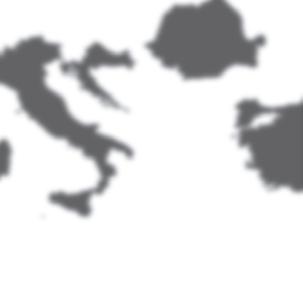
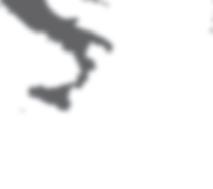


DK SE FI LT DE UK IR NL BE CH AU SL BY RU RO HU IT ES IS PT RU SI MT HR AL BG BA RS EL MA DZ TN LY CZ NO LV ME MK PL EE FR LU MD UA 4 Table of News










































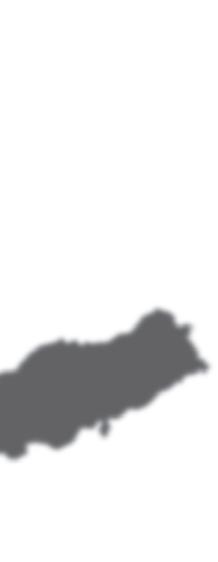
40 Polish Angling Association hatchery in Goleniów Restocking waters in West Pomerania
43 The logistics of buying, processing, and distributing fresh fish are challenging Whitefish products for the EU market
45 Perch from the Szczecin lagoon now dominates processor’s assortment Adapting to the lack of Baltic cod
47 Making the most of EU funding opportunities Fishers struggle to adapt to changes
49 A group of fishers has concerns about the future of their industry Diversification is the way forward
Georgia
52 The aquaculture sector in Georgia Potential exists despite the challenges
Aquaculture
55 The rising tide of macroalgae cultivation in the EU Macroalgae aquaculture needs to be expanded
Ukraine
59 Ukraine’s seafood business: Impacts of Russia’s war against Ukraine Living on a powder keg
Guest Pages: Dr Susan Steele
EG AZ KZ UZ IR IQ IL JO SA LB SY CY TM TR AM GE (CC BY-SA 3.0) Map based onhttps://commons.wikimedia.org/wiki/File:Location_European_nation_states.svgby Hayden120 and NuclearVacuum EUROFISH Magazine 3 / 2024 5 Contents
62 The European Fisheries Control Agency A key partner in the fight for fisheries sustainability Service 61 FISH Infonetwork News 65 Diary Dates 66 Imprint, List of Advertisers Worldwide Fish News Australiapage 8 Belgiumpage 7 Denmarkpage 9 Germanypage 8 Icelandpage 9 Lithuaniapage 6 Norwaypages 6, 7

Norway: Salmon volume dropped, pulling down total seafood export value in Q1 2024
In recent times Norway’s salmon export success has been due to strong prices, not volume, which has been relatively steady. But in this year’s 1st quarter, volume dropped significantly, causing a value drop in the country’s overall seafood exports. The drop has been attributed partly to a production decline caused by a fall in sea temperatures compared to last year. Seafood exports dropped by 3 in value in the first quarter compared to the same period in 2023, disrupting a 3-year value rise. Norway’s currency value visà-vis the euro and dollar has fallen for some time, making its product
prices cheaper in export markets and has helped fuel revenue gains. But such gains have previously depended on a volume of exports that at least stays constant.
The recent volume drop in Q1—to 246,560 tonnes of salmon—more than offset any exchange rate advantage, and Norway’s total fish export revenue fell to NOK 40.2 billion (EUR 11.7 billion). Norway’s largest markets are in the EU, including Sweden and Poland, which process salmon for reexport throughout the EU. Norwegian salmon prices are influenced by global production (which

In 2023, Norwegian exports of salmon reached 1.2 million tonnes valued at EUR 10 billion, or more than 70% of the country’s total seafood exports.
Norwegians play a large part in) and demand. Demand for salmon, in filleted or steak form, fresh or frozen, has been strong for many years, and that has helped Norway, whose salmon (and trout) farmers also have operations in
other countries, such as Chile, the world’s second largest farmed salmon source. Norway’s exports of other species, such as cod, showed mixed results. The largest cause of revenue decline was farmed salmon to the EU.
Lithuania: Environment agency improves rules for reducing cormorant problems
After humans, cormorants are perhaps the largest consumers of fish from Baltic aquaculture sites. These shore birds, of medium size but maximum appetite, nest in colonies along the coast where their favorite food—fish, wild or farmed—is to be found. They are immensely costly to aquaculture farms along the Baltic coast. In Lithuania, the Environmental Protection Agency (EPA) has long sought a balance between populations of cormorants and “populations” of fish farms. For many years the EPA, with EU money, helped farmers with using “nonlethal” means to control cormorants, such as coating their eggs with oil to prevent them from hatching, and financially compensating farmers for cormorant-caused losses. In recent years the money spent on this support has risen to a third of the agency’s entire budget for aquaculture and nature management efforts.
However, the problem has continued. Recognizing cormorants are not an endangered species, the EPA recently announced a new system of individual quotas (farmspecific) for cormorants that are “caught or destroyed” by farmers. The quotas are determined by the EPA using data that farms shall report on the number of problematic birds and the financial losses they cause. Farms can then take the necessary action to reduce the problem, during a period each year set by the agency in accordance with other environmental factors that fall under its managerial purview. “We have agreed that it would make sense to take the next step and go towards setting individual quotas, by determining the number of birds that can be taken for each farm,” said an official. The implementation of the new system is being done gradually; the goal is to have the system fully implemented by 2025, and this year 15 farms will be fully in the system, with only a few more to go.
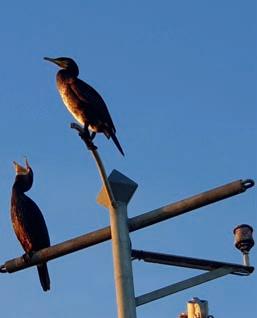 Cormorant populations are on the rise in the EU, posing a threat to regional fisheries and the viability of smaller enterprises.
Cormorant populations are on the rise in the EU, posing a threat to regional fisheries and the viability of smaller enterprises.
[ INTERNATIONAL NEWS ] 6

Seafood consumption promoting project kicks off in Brussels
Despite its potential advantages in terms of climate impact, sustainability, and nutrition, seafood is frequently disregarded or lumped together with meat. The potential benefits of seafood are often overlooked, particularly in the transition towards a sustainable, equitable and balanced protein system. Seafood consumption in Europe is low compared to meat consumption, and locally produced seafood often cannot compete with imported products because consumers do not know about or value local seafood. To enable healthy and sustainable choices, consumers need information about sustainability and nutrient values as well as provenance and potential health risks and benefits.
VeriFish, a project funded under Horizon Europe will provide a framework of verifiable sustainability indicators based on existing EU and global databases. VeriFish will work on the creation of a prototype web
application, a series of media products and recommendations for communicating sustainability indicators to various stakeholders including guidelines for retail and the hospitality sectors. The goal is to provide an accessible and dynamic framework for the improvement of communication and understanding of sustainable seafood production and consumption.
The indicators framework must not only be communicated to seafood producers and retailers, but also to policymakers, citizens, and children. Therefore, a storytelling series, recipe books for kids, puzzles, and posters are among the planned product outputs. Finally, the project will develop and publish European Good Practice recommendations, co-designed with seafood sector stakeholders, on how to efficiently use the indicator framework to communicate with citizens. The VeriFish website will be launched in June at verifish.info from where one
One of the world’s largest producers of farmed fish has a new fisheries minister following a reorganization of government. Norway’s LaborCenter coalition government has been in power since 2021 and since then has averaged one fisheries minister per year, as it frequently rearranges ministries across the board or replaces people who leave government for one reason or another. The latest appointee will have to learn on the job as she comes from a non-fisheries background, but she is committed to her new role. Marianne Sivertsen Næss takes over the job from Cecilie Myrseth, who has been appointedindustry minister. The community’s marine resources must benefit
the community. The government must pursue an active maritime policy, which ensures people safe and good jobs that we will live on in the future, Ms Næss said. A teacher and school principal before entering politics, she was elected mayor of Hammerfest municipality from 2019 to 2021. She then entered the Storting (Parliament) representing Finnmark and has since chaired the energy and environment committee until her new appointment. The minister of fisheries is responsible for implementing the government’s policy relating to fisheries, aquaculture, and seafood, as well as other policy areas relating to coastal development and sea transport.






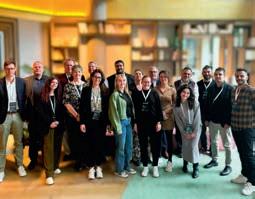
Members of the VeriFish consortium at the kick-off meeting. From left to right, back row: Alessandro Petrocelli (COMMpla), Marco Frederiksen (Eurofish), Peter Olsen (NOFIMA), Karl Presser (Premotec PLN), Ixai Salvo (Eurofish) Paul Finglas (EUROFIR), Yannis Tzitzikas (FORTH), Themis Altintzoglou (NOFIMA), Toni Bartulin (Eurofish), Yannis Marketakis (FORTH).
Front row: Sabrina Duri (Trust-IT), Sian Astley (EUROFIR), Sara Pittonet (Trust-IT), Marte Olsen (NOFIMA), Christine Absil (Clupea), Silje Steinsbo (NOFIMA), Michelle Boonstra (Clupea), Cristina González (EUROFIR)
can also reach the project’s social media accounts on X (formerly Twitter), Facebook, Instagram, LinkedIn, and YouTube.
Norway: Cabinet reshuffle results in a new fisheries minister
 Marianne Sivertsen Næss is Norway's new fisheries minister with responsibility for fisheries, aquaculture, and seafood.
Marianne Sivertsen Næss is Norway's new fisheries minister with responsibility for fisheries, aquaculture, and seafood.
[ INTERNATIONAL NEWS ] EUROFISH Magazine 3 / 2024 7

Germany: Closed season set in North Sea fishery to protect eels
The German government has announced a closed season for eels in its North Sea waters, from 1 September 2024 to 28 February 2025. This coincides closely with an EU-wide seasonal closure for eel fishing in the Baltic Sea from 15 September 2024 to 15 March 2025. Both restrictions exclude the late summer period of eel migration, a key time for harvesting activity. There is only one stock, or population, of eel in all of Europe. Despite being perilously close to extinction for many years, as judged by
the world’s main organizations that monitor the state of natural resources, European eel continues to be legally fished in the EU, albeit with some restrictions that have proven to be ineffective in allowing eel resource recovery, according to ICES, whose scientific recommendations are supposed to form the basis of EU fishery regulations.
Eels are notoriously difficult to raise in aquaculture operations, so the wild fishery remains the principal source of eels. Despite the
vanishing numbers of wild eels, fishing is allowed by governments to continue because the eel fishery remains economically important in many rural regions. It is primarily a small-scale sector, supporting many in harvesting, processing, and marketing to a large base of consumers throughout Europe. There is no legal recreational fishing for eels in the EU. “Given the dramatically low population, it is high time to act,” said Claudia Müller, Parliamentary State Secretary to the Federal Minister of Food and Agriculture. “The closed
season helps the eels that are ready to spawn to make the long migration to their spawning area in the Atlantic, the Sargasso Sea east of Florida. The protection of the eel is also important because of its socioeconomic importance: eel fishing secures incomes in many places in Germany. Giving eel stocks a perspective also means securing the livelihoods of people on the coasts and in rural areas in the long term.” Whether Germany’s action will materially contribute to eel protection depends on other member states copying and enforcing it.
Australia: First in-person Seagriculture Asia-Pacific Conference to be held in March 2025
The Belgium-based organizers of the series of Seagriculture Conferences have announced plans for their very first in-person conference designed for the Asia-Pacific region, to be held 18-20 March 2025 in Adelaide, South Australia. The inaugural Asia-Pacific Conference was held in 2023 but it was on-line only. Seagriculture Conferences, which began in Europe in 2012, focus on seaweed production, innovation and marketing. Seagriculture Asia-Pacific 2025 is supported by ASSA (the Australian Sustainable Seaweed Alliance), whose mission is to promote environmentally responsible commercial farming of seaweed to provide food, feed and bioproducts. ASSA’s partners include the Fisheries Research and Development Corporation (FRDC), the South Australian Research and Development Institute (SARDI), the Department of Primary Industries and Regions South Australia (PIRSA) and the Australian Department of Agriculture, Fisheries and Forestry (DAFF).
The event is cosponsored by the government of South Australia and indirectly by the federal government, which has provided A$8 million to the Developing Australia’s Seaweed Farming Program to support investment in the Australian seaweed industry.
There are 1,500 species of seaweed in South Australia waters, a number exceeded only by Japan. The state government has identified the seaweed industry as a growth sector to be promoted not only for employment opportunities but for environmentally sustainable production of wide array of consumer and industrial goods, from food (e.g., ice cream) and skin care (e.g., shampoo) to ingredients in livestock feed and dental molds, among countless other uses. Thousands of attendees are expected from all over the Asia-Pacific region as well as from far away. They will learn about the latest in farming technology, processes, and new products from a sustainable
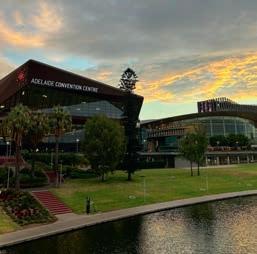
Adelaide in South Australia will host the Seagriculture conference on seaweed production and innovation 18-20 march 2025.
marine resource whose future seems to be boundless. Plus, on location, attendees will be able to join a site visit to the South Australian Research and Development Institute (SARDI), a research facility
dedicated to the sustainable use of natural resources.
Further updates and registration information on the conference will be available on the website: www. seagriculture-asiapacific.com.
[ INTERNATIONAL NEWS ] 8

Italy: Vast piles of waste in fishing nets lead to interest in recycling
From plastic bags to household appliances, thousands of tonnes of waste are brought up from the sea in fishermen’s nets every year. After throwing much of it back and repairing the nets, fishermen are frustrated by this costly environmental problem. In Italy, an idea is emerging to bring the trash to port and recycle it. Most trash can be decomposed into its raw material—plastics,
metals, etc.—and can enter the huge recycling industry for land-based recyclable waste. In a ten year period, fishermen bring up enough trash to cover the circumference of the Earth 15 times, says Paolo Tiozzo, vicepresident of ConfcooperativeFedagripesca, speaking on this year’s Earth Day. It is a growing problem, but fishermen also pay the price for inaction— polluted waters.
Italy’s fishermen probably don’t relish the thought of hauling old tyres from the depths of the Mediterranean to port for recycling, but they might if they can be compensated for it. Plus, they benefit from knowing they are helping sea turtles, birds, and other marine life that make up the natural environment that fishermen are very much a part of. The recycling industry in Italy is worth 3 billion euros a year. It is well developed
Iceland: Presentation area at Icefish 2024 will be a first
Visitors to this year’s Icelandic Fisheries, Seafood & Aqua Exhibition in September will have the opportunity to experience a brand new feature. The IceFish 2024 presentation area. Sponsored by Icelandic consulting company Verkis, the presentation area will give exhibiting companies the opportunity to showcase their latest product, innovation, or initiative to a live audience in a specially built theatre within the exhibition. Presentations will run
on all three exhibition days. Icefish 2024 already boasts a ministerial opening, the Icefish Awards ceremony, and matchmaking meetings. The presentation theatre will provide visitors with the added benefit of being informed through short and sharp presentations on exciting launches during Icefish. A platform for companies to demonstrate their activities offers a more immersive and interactive experience where attendees learn about new technologies whilst exhibitors
and can utilize added materials from the sea. Such waste is “invisible” in that we rarely see it except when it is washed up on a beach. But the marine environment sees it for hundreds of years. A plastic bottle will lie on the sea floor for half a millennium, and even cigarette butts can stay there for half a decade. Any trash, large or small, hauled up and properly disposed of benefits the environment Italy’s fishermen rely on.

gain insights into customer interests. Presentations are expected to attract an audience that will be specifically interested in the topic being presented providing an opportunity to network and build relationships with potential
customers, partners or investors. Details can be found in the new events and demo listings, another new addition to celebrate 40 year’s of Icefish. For more information on bookings, please contact info@ icefish.is or call: +44 1329 825335.
Denmark: Six EU projects to improve European aquaculture join forces at AQUA24
Aquaculture is the world’s most diverse farming practice in terms of species, farming methods, intensity level, and is one of the most sustainable ways of providing animal protein to some of the 8.5bn people expected to populate Earth by 2030. While aquaculture on a global scale is booming, its growth in the EU is stagnant— something the European Commission would like to change. Six EU projects, AlgaePro Banos, AWARE, Baltic Muppets, EUMOFA, FishEUTrust,
and SAFE, dealing with various aspects of aquaculture, will be present at the shared Eurofish organised stand 33-35 at AQUA24 in Copenhagen, Denmark on 26-30 August. The AQUA events are held every six years and comprise a scientific conference, trade exhibition, industry forums, workshops, and student events highlighting the latest aquaculture research and innovation. Visit us to learn how we seek to accelerate growth in EU aquaculture.

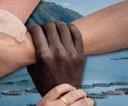


JOINING FORCES for AQUACULTURE
[ INTERNATIONAL NEWS ] EUROFISH Magazine 3 / 2024 9

The six project partners at the shared AQUA24 stand are:
AlgaeProBANOS is a fouryear Innovation Action bringing together 26 partners and affiliated entities with a mission to demonstrate viability and market accessibility for sustainable and innovative algae-based products and solutions in the Baltic and North Seas. Our vision is a thriving algae industry within Europe, supporting a broad range of innovative, sustainable, bio-based products, whilst generating new regional sustainable industries and economic growth. AlgaeProBANOS will directly contribute to the Blue Mission BANOS lighthouse initiative, which engages and supports stakeholders across the Baltic and North Sea to reach a carbon-neutral and circular blue economy.
AWARE, or Aquaculture Water Reclamation, pioneers a novel approach to freshwater aquaculture to meet the rising demand for low-carbon-footprint protein sources. By utilizing reclaimed water from rigorous treatment processes, the project integrates fish and vegetable farming in an aquaponic system, a groundbreaking practice in Europe due to regulatory challenges. Collaborating with local wastewater treatment plants, AWARE creates a sustainable loop between food production and wastewater treatment, optimizing low-value urban/peri-urban spaces and preserving natural water sources. This innovative approach promises lower environmental impact and greater resilience to climate change, such as water scarcity, while ensuring the end products’ safety, nutrition, and taste. Currently being tested in Castellana Grotte, Italy, AWARE aims to validate its pilot aquaponic farm within the local wastewater treatment plant and collaborate with authorities to establish the regulatory framework for reclaimed water aquaculture across Europe.
The Baltic MUPPETS project has an overall aim to demonstrate that it is possible to create a viable business based on Baltic blue mussels that is both profitable and beneficial to the Baltic Sea environment. The main objective is to develop new value chains for small mussels (1-3 cm) from the Baltic Sea for pet food and to develop innovative technologies for farming, harvesting, processing and side-stream use. The project will enable a new circular economy in the Baltic Sea Region as well as provide support to mussel farmers across Europe to develop, diversify, and scale their existing businesses.
EUMOFA
European Market Observatory for Fisheries and Aquaculture Products
The European Market Observatory for Fisheries and Aquaculture Products (EUMOFA) is an online tool for the EU fisheries and aquaculture sector, which aims at increasing market transparency and efficiency, and at analysing EU markets dynamics. The market intelligence provided by EUMOFA is useful for all stakeholders involved in the fisheries sector: producers, processors, importers, retailers, consumers, market analysts and policy makers. It represents one of the tools of the Market Policy in the framework of the Common Fisheries Policy.
Starting in June 2022, FishEUTrust is a 4-year Innovation Action funded by the European Union’s Horizon Europe programme. The project is developing tools to maximize trust in seafood and aquaculture products by guaranteeing quality, safety, and traceability through sensors, metagenomics, genetic biomarkers, isotopic techniques, labelling, product passports, and blockchain. These tools will be integrated into a single digital FishEUTrust data platform. FishEUTrust is establishing five Co-creation Living Labs in the Mediterranean Basin, the North Sea and the Atlantic Sea to enable the validation and demonstration of these innovations for supply chain solutions.
The SmartAqua4FuturE (SAFE) project aims to reverse the declining trend of EU freshwater aquaculture by demonstrating a circular economy model that reduces emissions, minimizes impacts on biodiversity, supports local production of sustainable feed ingredients, improves profitability and creates new jobs. The objective is to reduce the environmental impact and improve the viability of freshwater aquaculture by valorizing solid and liquid waste streams from recirculating aquaculture systems and integrated multi-trophic aquaculture systems.
SAFE will enable the uptake of these solutions through local and regional scale demonstrations across the EU and will document the necessary management and governance conditions for successful transferability.
[ INTERNATIONAL NEWS ] 10
We look forward to welcoming you in September
The Icelandic Fisheries. Seafood & Aqua Exhibition hosts the latest developments from the industry showcasing new and innovative products and services, covering every aspect of the commercial fishing industry from catching and locating to processing and packaging, right through to marketing and distribution of the final product.
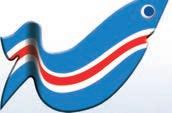

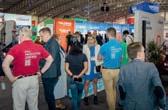



For more information about exhibiting, visiting or sponsoring, contact the events team
Visit: Icefish.is
Contact: +44 1329 825 335 or Email: info@icefish.is
Organised
Media Partner: 18 20
Iceland 2024 SEP
by:
TO Smárinn Kópavogur
#Icefish Book
stand now!
your
The global seafood industry thronged to this year’s edition of Seafood Expo Global and Seafood Processing Global in Barcelona like never before.
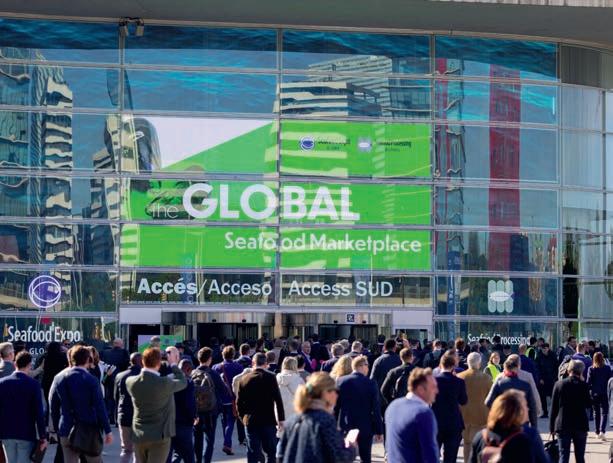
Seafood Expo Global, Seafood Processing Global, Barcelona
Unparalleled enthusiasm for seafood
The 30 th edition of Seafood Expo Global and the third one in Barcelona was the largest ever drawing almost 2,250 exhibitors from 87 countries. Diversified Communications, the organisers, estimate that over 35,000 professionals attended the event with stands or as visitors.
The world's most international seafood show was characterised by a huge variety of processed products from the simple to the sophisticated, made from a variety of species, and in every kind of packaging. The show includes Seafood Processing Global which features equipment and services for the processing industry as well as increasingly for the aquaculture sector. In addition, each of the three days of the event saw a series of seminars, discussions, and presentations on topics of relevance for the industry including sustainability, aquaculture,
labour issues, artificial intelligence and traceability. The Seafood Excellence Global Awards highlighted the best products in different categories giving exhibitors and visitors an overview of trends in product and packaging development. From Eurofish’s perspective almost all
its member countries were represented at the show. In the following pages the participation by some of them is reviewed and it is apparent how useful and productive they found the event. All of them were determined to return in 2025 when the event will be held 6-8 May.
Diversified Communications
12
Poland pavilion highlights sophistication of nation’s processors
As a country with one of the weightiest fish processing sectors in the EU, Poland has good reasons to be present at SEG. Here Polish processors can meet existing and potential suppliers and customers from all over the world under one roof. This year, the Polish Association of Fish Processors together with the Organization of Sturgeon Fish Producers organized a Polish national pavilion where 22 companies from the processing industry presented themselves: Abramczyk, Graal, Evra Fish, Barkas, Freezco, Antonius Caviar, Mik- Food, Mirko, Polski Karp , Offshore Fish Producers Organization,
Salmon Fish Processing, Rybhand, Seamor International Ltd, Seko, Stanpol, Tahami Fish, Thai Union Global, Dega, Contimax Trade, CPF Culinar, Sturgeon Fish Producers Organization. On 23 April, the first day of the show, the pavilion was officially inaugurated by Ms Ilona Kałdońska, Consul General of Poland in Barcelona, Ms Małgorzata Pawliszak, President, Polish Association of Fish Processors, and Mr Mirosław Purzycki, President, Organization of Sturgeon Fish Producers. As in previous years the pavilion featured a cook who prepared samples for the participants as well as for visitors to the pavilion.

Małgorzata Pawliszak, Polish Association of Fish Processors, Mirosław Purzycki, Organization of Sturgeon Fish Producers, and Ilona Kałdońska, Consul General of Poland in Barcelona officially open the Polish pavilion at SEG.
For Polish companies the show is a unique opportunity to promote themselves and their products. A Polish company was among the finalists for the Seafood Excellence Global awards competition suggesting that the seafood industry has moved from pure contract manufacturing to one that
develops sophisticated seafood products for domestic and international markets. Poland’s participation was enabled by support from the European Maritime, Fisheries, and Aquaculture Fund for Fisheries program for 20212027 and from the Ministry of Agriculture and Rural Development.



INTERNATIONAL FAIR OF FISH AND FOOD PRODUCTS GDAŃSK, POLAND





amberexpo.pl







 PolFish
PolFish
polfishfair.pl
Monika Pain / Project manager monika.pain@amberexpo.pl
[ EVENTS ] EUROFISH Magazine 3 / 2024 13
PP Orahovica has expanded into farming African catfish
In addition to farming carp and related species grown in polyculture in ponds, PP Orahovica, a Croatian company, is now also farming African catfish in recirculation aquaculture systems (RAS). The technology is very different from that used to farm carps, says Jakov Beslic Gadzo, the sales manager, as here we use very little water and can control virtually every parameter. Over the last two years the company has learned a lot about the production processes in a RAS and has expanded its production of African catfish, which are processed the same way as the carp. We make steaks, fillets, we pack in MAP, we freeze, and IQF— we make a lot of products from this fish, says Mr Gadzo. African catfish is very interesting for us because it is
robust to breed, the flesh has a very neutral taste, the texture is meaty which means it does not break up like the flesh of other species, and above all it has very few bones. This makes it very popular with children. But chefs like it too, they find it versatile because the taste does not dominate, and it can be successfully paired with sauces of many kinds. The company produces 150 to 200 tonnes of African catfish a year of a total production of 2,500 to 4,000 tonnes. How much the catfish production will expand in the future depends on the market. If there is demand we will expand further because the fish is relatively easy to grow and the technology allows us to control everything, Mr Gadzo states. However, the very fact that it can
The beauty of Salmco’s machines lies in their simplicity
A40-year-old manufacturer of slicing machines for the salmon industry, Salmco is known for the high quality of the equipment it makes. Its slicers can be found in more than 70 countries around the world, and today its most important markets in Europe are Turkey, Spain, France and the Baltic States. Most sales are through dealers in different parts of the world.
Werner Kuehl-Menk, the sales manager, sees several advantages to using dealers. They know the customer, can speak the language, and do the negotiation which allows us to concentrate on the engineering side of things to improve our machines. Despite this reliance on dealers, Salmco also successfully sell overseas and in many other countries, always remaining a reliable point of contact for their customers.
 Katica
Katica
be easily produced encourages others also to invest in this production. So, it is a bit tricky, he feels. On the other hand, the company produces according to demand, production can be planned so that there are no surpluses, prices are maintained at around the same level, it is a predictable business, there is no stress.
Orahovica sells over three fourths of its total production outside its domestic market. Neighbouring countries in the Balkans as well as the rest of the EU are among the countries to which it exports. Visitors to the stand could sample batter fried products based on common carp, bighead carp, and African catfish.
The beauty of Salmco’s machines lies in their simplicity. We want our customers to be able to maintain their own machines without having to summon a technician, says Mr Kuehl-Menk. Making more complex products will move away from this philosophy. Besides our customers typically require a machine only for slicing, without any other extra features. Developments in artificial intelligence, internet of things, turnkey solutions etc. are no doubt interesting, but for Salmco they are more a distraction from the business of making simple, reliable, durable, and hygienically designed machinery. This is not to say that the machines cannot be modified. If customers need a standard machine adapted to their needs, Salmco will make the necessary changes. The machines have been evolving over the years. Since 2020
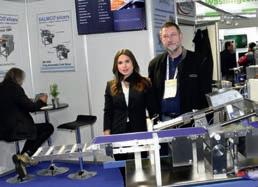
they all have programmable logic controllers, devices that can receive and process data and trigger an output. The knife changing system can now be done without a tool, while before the same operation required a screwdriver. Another refinement is the divided cover, the two parts of which can be removed also without the need
for tools and in just a few seconds lay bare the entire machine for maintenance or for cleaning. A further development that is now in the works is a new kind of belt that carries the product away after slicing. The new belt will allow even small pieces of sliced fish to be collected and sold thus contributing to greater efficiency.
Petkov, Marketing Manager and Jakov Beslic Gadzo, Sales Manager at PP Orahovica
Yana Pluzhnikova, Sales and Marketing, and Werner Kuehl-Menk, Sales Manager at Salmco, a manufacturer of fish slicing machinery.
[ EVENTS ] 14
Starfish Seafood shows off its salmon smoking skills
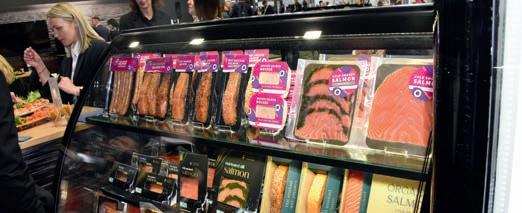
Seafood offers discerning retailers a range of high end
and
products based on salmon, as well as salmon sausages and salmon paté.
Among the companies present at the Latvian pavilion was firsttime exhibitor Starfish Seafood. The firm may have existed for only five years, but in that time it has managed to carve out a name for itself in the highly competitive market for secondary processed salmon products. These are based on raw material from Norway, the Faroe Islands, and occasionally Scotland, which the company converts into alluring hot- and cold-smoked products for clients in Latvia and other EU countries. Starfish, a Latvian Danish joint venture, started as a trading company, says Aija Serenda, the director, buying smoked products and selling them. But then we decided we could make products better than the ones we were trading, so we started our own processing facility. The production is sold under the company’s own brand, Starfish Seafood, or under a private label. We do a range of products, says Ms Serenda, and specialise in high end exclusive items for retail, where the raw materials, taste, look, and packaging all contribute to something very select. Moving from trader to processor has been a challenge, but the experience of trading has helped greatly in developing the products that Starfish really
wanted to sell. Cold-smoked salmon is produced using beechwood and the process creates a lightly salted product with a smoky smell and taste that does not drown out the natural taste of the fish. The hot smoke on the other hand results in a juicy fillet with a crunchy crust and a taste shaped by herbs such as pepper or garlic. Both types of smoked products can be produced in sizes ranging from 50 g (100 g for the hot smoke) to a whole fillet. The product can be packaged in modified atmosphere, vacuum, or skin depending on the customer’s preference. The company also produces a salmon paté and salmon sausages, the latter is made entirely from salmon with no other ingredients, while the paté spread on toast makes a delicious snack. Exhibiting at Seafood Expo Global has always been a dream for Ms Serenda which was finally fulfilled this year. And the experience has been overwhelmingly positive, she says, both in terms of the interest generated by her own products and the samples that were available to taste, but also because of the variety of products on display at the show which were a rich source of inspiration. As a result, she has every intention of returning to the show in 2025.
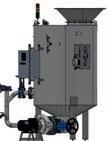
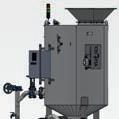







 Starfish
hot-
cold-smoked
Starfish
hot-
cold-smoked
Kroma promotes a zero-waste policy Discover How We Can Unleash Your Potential Turn waste and dead fish to PROFIT with a SILAGEMASTER solution NO COOLING STORE OUTSIDE PERSIST FOR YEARS SILAGEMASTER Effective handling and storage of your By-product · Optimal solution for by-products · Minimal maintenance · Designed for your plant and needs · Get value out of your waste [ EVENTS ] EUROFISH Magazine 3 / 2024 15
Bivalve farmers beset by challenges
The blue crab (Callinectes sapidus) is an invasive species in the Mediterranean and the Adriatic where it is destroying populations of bivalves. We lost EUR5m one summer in clam production to the blue crab, says Gabriele Albano, a consultant for the fisheries and aquaculture industry. They use their strong claws to crack open the clams and eat them. Mr Albano together with his brother proposed at a conference to extract the meat from the crab using high pressure processing (HPP), but the idea did not gain much traction. Part of the reason may be that Mr Albano is based in Taranto in the Apulia region in southern Italy where there is no tradition for eating crab. Blue crab meat may be more popular further north, he says where there is an existing tradition of eating green crab
(Carcinus aestuarii) in and around Venice. Clams (vongole) are virtually a national dish in Italy where they are typically eaten with pasta and Fedagripesca, an industry association, estimates that blue crabs have resulted in shellfish losses worth EUR100m across Italy, according to Politico, an online newspaper. The government has set aside EUR3m to combat the invasion. Fishers are trying to trap the crabs and destroy them, but that is not a lasting solution, Mr Albano feels. Better would be to treat is as a resource and exploit it. Blue crabs are however not the only challenge that shellfish farmers currently face. Mussel farmers in Taranto have seen the fee to the government for leasing their concessions increase by a factor of 10 completely upending the economics of their activity. Many farmers are
Mussel farming company Fratelli D’Andria exports spat to Spain and France
Gnot paying, says Mr Albano, preferring to wait and see what happens. But this triggers a series of warnings from the government, which are also not pleasant to receive. One solution might be for the farmers to consolidate their concessions. Since the fee is per concession a farmer with, say, five concessions would have to pay for each. By consolidating all five into one the farmer would only have to pay the fee once. The travails of Taranto’s shellfish farmers do not end here, however. Mr Albano recalls how a mussel farmer called him recently to ask if he had a solution for turtles eating his mussels. Apparently, loggerhead sea turtles (Caretta caretta) have been causing a lot of damage to his lines of mussels. There is nothing to be done about it, says Mr Albano, as the animal is under threat according to European legislation.
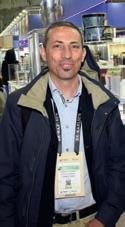
Gabriele Albano, a consultant for the fisheries and aquaculture industry in Italy, feels that by removing the meat using high pressure processing, blue crabs could go from being a menace to a resource.
abriele Albano, a consultant for the aquaculture and fisheries industry, is currently working on a project for a farmer of mussels and oysters in Taranto, Apulia. Franco D’Andria has been farming shellfish for over 40 years and one of the biggest changes he has noted is the increase in automation in the industry. Two decades ago everything was done manually—retrieving the lines, removing the mussels, separating them, cleaning, and packaging. Now, machines perform all these tasks. Automation has enabled Mr D’Andria to increase the number of workers he employed as the production became more efficient. Today some 15 workers are employed in the company.
Mr D’Andria has three concessions and has also been hit by the increase in the concession fee, but he has elected to stagger his payments over two years. But he is annoyed about the hike in the fee. We already pay taxes on our salaries, on our pensions, and a fee for the concessions, he says, increasing it like this is threatening our livelihoods. With Mr Albano’s help Mr D’Andria has sought support from European funds to invest in his business. The first time he bought a vessel to carry out the harvesting. The new boat was nearly 18 m long and equipped with the necessary machinery to harvest, clean, grade, and pack. More recently
he used the fund to equip buoys with RFID tags to prevent theft. While this is an occasional problem, more enduring is the increase in water temperature at the surface of the sea caused by global warming. Mr D’Andria has therefore moved his lines into deeper water where the temperature is lower. He is fortunate that the depth of the water where he has his concessions is 24 m, where usually in Taranto it is not more than 8 m. Moving the lines deeper in the water column does generate more work, but there is no real alternative as the mussels cannot tolerate the warmer water that prevails towards the surface. Like most farmers in the area Mr D’Andria is a primary producer. The mussels are harvested, cleaned, graded, and then packaged in nets for sale primarily in Italy. He also exports mussel spat to buyers in France and Spain, because the sea is very rich in spat. Any substrate introduced into the water will soon be covered by spat. To export it the
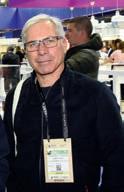
Franco D’Andria has been farming mussels for forty years in Taranto and has seen the positive impact of automation in his industry.
spat is collected on 6 m long ropes which are coiled on a pallet and transported by truck. They will easily survive for four days with some ice added into the coils.
[ EVENTS ] 16
Pelagos Net Farma produces tuna and small pelagics
The Croatian pavilion at SEG hosted companies working with many different species seabass, seabream, anchovies, tuna, and sardines. Jadran Tuna and Pelagos Net Farma are two of the four Croatian companies fattening bluefin tuna for the Japanese market. The two are related as the owners of Jadran Tuna are also part owners of Pelagos. Tuna are fattened by feeding them a diet of small pelagic fish and once they reach the right size they are sold to Japanese buyers. Processing vessels from Japan arrive at the time of harvest and take the harvested fish on board to process and freeze it down to minus 65 degrees. Pelagos’ vessels were targeting anchovies and sardines in the Adriatic to feed the tuna and so Dunja Gotovina, the sales director, thought it would be more profitable to use that fish to make products for human consumption. Anchovies and sardines are typical small pelagics
from the Adriatic and in Croatia these are usually salted or marinated. Pelagos began its activity with these species five years ago choosing the best fish from the catch while allowing the rest to be used as tuna feed. The feed is supplemented with frozen herring as the catches are insufficient to cover the company’s requirement for both processed products and tuna feed. The processing factory is located on the pier where the company’s ten vessels land the fish, so the raw material is very fresh when it arrives to be processed. The catch amounts to some 800 tonnes per year in total for both anchovies and sardines and about three fourths is processed for human consumption. We salt the anchovies, she says, and then fillet them by hand before placing the fillets in jars in olive oil or sunflower oil. Another product is marinated anchovies. The sardines, on the other hand, are individually quick frozen either whole
Akvapona farms and processes African catfish
Vladas
working with this fish for the last decade and has seen its popularity increase several-fold. One reason is availability. As a relatively unproblematic fish to
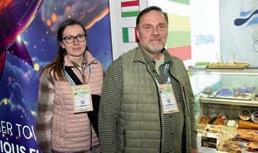

or headed and gutted. Sometimes in summer when the sardines are large, they are salted after being gutted. The salted sardines are then either packed in bulk in barrels as a semi-finished product or are packaged in retail-size glass jars or plastic containers with
breed catfish has proved attractive for entrepreneurs in many European countries particularly in the east. The meat-like texture of the flesh, lack of bones, mild taste, and the health benefits associated with fish make it a sought-after product especially in families with young children who are picky eaters. Mr Vickūnas has
olive or sunflower oil. When processed like this the raw material used is the fresh fish. The products are sold under the Pelagos brand on the Croatian market and at SEG Ms Gotovina hopes to promote them to a wider audience.
developed a range of products including headed fish, fillets with and without skin, portions, and no less than 14 varieties of frozen fish cakes. People at SEG are certainly more aware of catfish today compared with a few years ago when nobody had heard of it. But even so more work needs to be done to promote it, Mr Vickūnas






A Aqquuaaculture T Teecchhnology A small selection of our approved range of products for : Breeding - Holding - Feeding - Aerating - Monitoring - Catching - Transporting - Processing A AqquuaaTTeecch h Unterbrunnweg 3, A-6370 Kitzbühel/Austria, Tel: +43/664-1048297, www.aqua-tech.eu
From left, Dunja Gotovina, Sales and Marketing Director; Ivana Kuzman, Production Manager; Anamarija Bakmaz, Commercialist, all from Pelagos Net Farma.
Vladas Vickūnas and Svetlana Lvova, his wife, used SEG to explore the potential of African catfish on European and other markets.
Vickūnas, an African catfish farmer from Lithuania, is presenting his products at SEG for the first time. He has been
[ EVENTS ] EUROFISHMagazine 3/202417
feels. Discussions with traders at the show have revealed interest in catfish and its potential and a need for certain products like fillets and even whole fish, a product form he cannot sell in Lithuania. The catfish story is just beginning, according to Mr Vickūnas, who started with 50 tonnes and is now producing 1,000 tonnes. While catfish is a sturdy and
Eva canned sardines are based on Adriatic fish
Rovinj, a town in Istria, the westernmost county in Croatia, and one that borders Slovenia, is the site of the Podravka Group’s fish production facility. Fishers catch the raw material, mainly sardines, which are then brought directly to the factory to be processed and canned in Dingley cans. Canned sardines are just one of the products manufactured by the company; it also offers canned hake, mackerel, tuna, and tuna salads. However, the canned sardines is the product Tamara Blazekovic, the lead category manager in the fish business unit, is most proud of. This is because the raw materials come from the Adriatic and are of the highest quality, because of the natural conditions in the Adriatic Sea. According to Ms Blazekovic, the water has the ideal ratio of salinity and temperature which is responsible for the high quality of the fish. In contrast the mackerel used in the production is Atlantic fish. The Adriatic
also has mackerel, but the company was not sure that it would be able to obtain the raw material it needed on a regular basis and from the same source. The group does not have its own fishing vessels relying instead on agreements with independent fishers to supply it with the raw material. Sardines are the company’s biggest category and sales go primarily to Croatia and the neighbouring Balkan countries. Australia, the US, Germany, and Austria are among the other export destinations. Croatian salted anchovies are well known but the company has eschewed their production, because it is a lot of manual labour. Our processing lines are specialised for sardines and we also do not have the distribution facilities we would need if we were to export anchovies to Italy. The facility also produces for private label. At the moment, however, the private label activities have been interrupted because of the lack of sardines. We have to ensure there is
rapidly growing fish it is also sensitive, reacting to noises and smells, and therefore needs to be handled with a little care. Even a power outage when the farm switches automatically to a generator can upset the fish. Mr Vickūnas plans to invest in solar panels which will take care of most his needs making the farm more or less independent of the grid.

A range of canned products are sold under the Eva brand, of which the biggest is canned sardines, says Tamara Blazekovic, Podravka’s lead category manager in the fish business unit.
enough fish for our regular customers here in Croatia. Production last year was around 30m cans of which most were Dingley, but a small volume of club cans is also produced. Cans, says Ms Blazekovic, sometimes evoke negative sentiments among consumers because they associate it with
preserving chemicals (in Croatian the root of both words is the same). The company has launched a campaign emphasising how healthy its canned sardines in fact are, containing nothing other than fish, oil, and salt—and that they have an official shelf life of two years.
Bajcshal guarantees stability of catfish deliveries
AHungarian company, Bajcshal, representing the Hungarian Aquaculture and Fisheries Interprofessional Organisation, was one of the two exhibitors from that country at SEG. Bajcshal is primarily a processing company handling 1,800 tonnes of fish a year of which about a quarter comes from suppliers delivering trout and salmon, while the bulk is from V95. V95 is a producer of African catfish
among other species like carps and related pond-grown fish. Production of African catfish amounts to 1,000 tonnes per year, while the other species total some 250 tonnes. Bajcshal has collaborated with V95 since 2015 and both companies are led by Gábor Szilágyi. At Bajcshal the fish is subject to primary processing such as gutting, and heading, but also filleting and portioning. In addition, the raw material is processed into fish
soup, a Hungarian delicacy traditionally made from carp, which is sold both fresh and frozen. The catfish, on the other hand, is almost all sold as fresh fillets with a small fraction going into the production of smoked fish, smoked fillets, and soup. Mr Szilágyi also farms sturgeon from which he extracts the caviar. The fish and fish products are currently sold on the domestic market, but Mr Szilágyi is at SEG to look for
markets in other countries—in particular for his award-winning caviar. According to him, the biggest advantage with catfish is the reliability of supply. He can guarantee delivery all the year around. African catfish also grows rapidly, taking about 10 months to reach market size. The carps and other species raised in ponds take longer to reach market size and are seasonal—they can be harvested and sold only at a certain
[ EVENTS ] 18











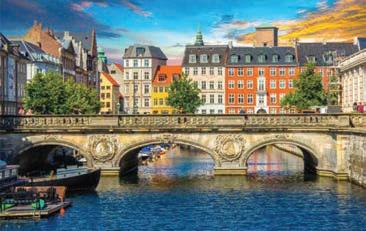





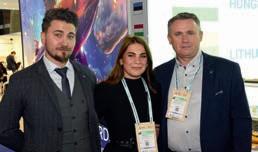
time of the year. At V95 the catfish are raised in a flow-through system that derives water from a river. This is mixed with warm water from a borewell since catfish need water at above 20 degrees before they will feed.
Like other farmed fish producers in Europe, Mr Szilágyi is not happy about what he feels is the lack of a level playing field. Companies like his must jump through hoops to comply with legislation at the EU, national, and sometimes also provincial level, pushing up his costs, yet products from countries that may
not place the same demands on their producers can freely enter the EU. He thinks the lobby for European companies that depend on imported raw materials for their production has become too powerful. In addition, he surmises that there are vested interests in allowing the flow of freshwater fish into the EU because there are European investments in these third country producing and processing firms. These factors make it difficult to be a small-scale fish farmer in the EU and also contribute to the lack of growth in the EU aquaculture sector.
Smyrna Goods sells wild products from the Aegean Sea
Türkiye is well represented at SEG with a large national pavilion hosting companies producing and trading in seabass, seabream, meagre, and tuna among other species. Some of the companies represented also trade in products from capture fisheries. Smyrna Goods, for instance, has a portfolio that includes sea cucumber, squid, octopus, mussels and bottarga (salted and dried roe) from mullet. Ogün Demirel, the founder, who represented the company at SEG said he was looking for volume buyers (those interested in 200 tonnes and above) and was impressed with the quality of the contacts he had made. This was the first time the company was present at the show, but Mr Demirel is convinced he will come back next year. Sea cucumber was the product he started with 12 years ago, and since then he has been adding a new product each year to the portfolio. The company exports sea cucumber to South Korea and China and traders from these countries were among the buyers he met. Some of the other products such as the bottarga, cephalopods, sea urchin, and fish fillets are exported to Europe. The fish fillets are from farmed seabass and seabream and they together with the mussels are
the company’s only products from the aquaculture sector.
Based in Izmir on the Aegean Sea, the company has a fleet of some 100 10 m to 15 m vessels that are responsible for the catch of the wild products. Four fifths of the vessels supply the company exclusively, while the remainder are on contract. The fishing area is in the Aegean Sea and in the northern part of the Black Sea and the vessels supply the entire requirement of raw material. Part of the production is frozen, but we also have a truck a week going to Spain and Italy with fresh products, says Mr Demirel. The product range includes some highly value-added products such as a shrimp burger using the Turkish red shrimp. Available frozen, the burger has a shrimp content of 100%. How exactly the burger is made so that it doesn’t lose its shape when thawed and cooked is a trade secret. Many people have wondered about that, Mr Demirel smiles, but that is our intellectual property and will not be divulged. Because the product is 100% shrimp exporting it is relatively easy due to the lack of other ingredients whose safety may have had to be proved. As a fishing company, Mr Demirel says,
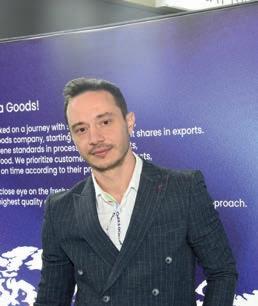
he is well aware of the issue of climate change and its impacts on the marine environment. But beyond the usual fluctuation in catches from
year to year they have not noticed any marked difference in the volumes of fish and seafood caught over the years.
Balazs Szilágyi (left), Dora Szilágyi, and Gábor Szilágyi represent Bajcshal, a Hungarian processing company and its production unit for farmed fish.
Ogün Demirel’s company Smyrna Goods catches, processes, and trades a variety of wild and farmed seafood with markets in Europe and Asia.
[ EVENTS ] 20
Politek produces and processes Turkish Salmon from the Black Sea
Türkiye is now well known for its production of Turkish Salmon, the trade name for trout (Oncorhynchus mykiss) that is raised to large sizes in the Black Sea. Production has increased steadily over the last years thanks in part to interest in the fish from many of the big fish farming companies in Türkiye as well as from several smaller operators. The fish and its roe are exported to Japan and Russia among other countries. At SEG the association of Turkish Salmon producers had a booth as did one of the producers Politek. Ömer Sener, foreign trade specialist at the company explained that Politek had a total production of 10,000 tonnes of the fish, 6,000 from the sea and about 4,000 from freshwater. The company has production facilities in
both marine and freshwater because the growing season in the Black Sea is only four months, while on land it is all year round. He considers the fish from both sources very similar—the freshwater fish are grown in large, deep lakes fed by nutritious water from the mountains. The fish from the lakes are introduced into sea cages in November and are harvested in June giving them 8-9 months of growth in the sea. We typically place 500-600 g fish in the sea and harvest them at 3 kg. It is also possible to put 1.5 kg fish in the sea and grow them to 5 kg. Temperature affects the appetite of the fish, if the water is cold the fish do not feed as well which reduces the growth rate.
Politek sells both fish from freshwater and from the sea and the fish

Politek prepares for the European market by investing in quality and processing capacity.
is sold fresh. The main markets are in Russia, Japan, Canada, Vietnam, and Thailand. The last couple of years has also seen a significant rise in interest from European buyers which is a very exciting development for the Turkish producers. We see it potentially as another Norwegian salmon story, says Mr Sener, though the two products

[ EVENTS ] EUROFISHMagazine 3/202421
are different and salmon from Norway is well entrenched on the European market. But demand from Europe is encouraging us to work on our quality. For this we have employed special quality managers, and we invest in our plants and
machinery. This year, for example, Politek established two plants with new machinery and a processing line that can handle 200 tonnes a day. Freezing capacity is also 200 tonnes a day and the company also has three cold stores with a
total —capacity of 12,000 tonnes. Currently the main product is frozen headed and gutted fish followed by fresh gutted fish. At SEG Mr Sener held meetings with potential Japanese clients who are interested in fresh shipments delivered
by air. The company also has a production of steaks, fillets, portions and smoked products. By-products from the processing operations such as heads, bellies, frames, and fins are also marketed to countries in south east Asia so that waste is minimised.
Creating awareness of the ocean among pupils across Europe
The European Marine Science Educators Association brings together people and institutions who work in blue education across Europe to create greater awareness about the oceans and the challenges they face. The institutional members could be universities, teaching institutes, aquaria, NGOs, or government departments, and the target for these information campaigns are citizens in general with a sharper focus on children and young adults in education. This could be in primary, secondary, vocational schools, maritime schools, or even universities. The association develops programmes on ocean literacy which can then be integrated into an existing course. The idea is to show what is possible and hope that the recipient organisation will be encouraged to do something similar that will make pupils, students, and staff more aware of the marine environment and the challenges it faces. For example, says Evy Copejans, managing director of the association, a module could include information about sustainability or fish species and could become part of a fisheries education programme. Or a degree in oceanography could include a module about the blue economy. These modules could then be shared with other institutions for them to adapt (or not) and incorporate in their programmes. The association is currently driving
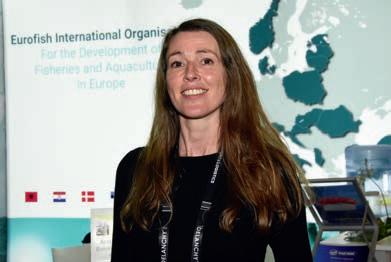
a programme for primary and secondary schools that seeks to bring the ocean, ocean economy, ocean health, and environmental issues to these schools all over Europe and that will be adopted into the regular curriculum. Since each country and educational system takes a different approach the association tries to identify the right people in the right positions who can strengthen the message and magnify the
level of awareness. As an example, Ms Copejans points to the port city of Den Helder in the Netherlands from where young people would leave in search of education or work. The port could offer jobs, but not enough people knew they existed. So, the port authorities and the association designed a programme that started in primary school and continued into secondary school and informed the pupils about
professions needed by the port. Apart from helping the port and the young people, the programme allowed the association to approach the government and demonstrate why it was worth investing in and replicating in other contexts. A certain momentum was thus created from this project that could lead to similar efforts in other places, which is one of the objectives of the association.
Evy Copejans, managing director of the European Marine Science Educators Association, a body that seeks to promote awareness of the ocean and the challenges it faces to school children of all ages across Europe.
[ EVENTS ] 22
GLOBALG.A.P. panel discussion at SEG
Collaboration for traceability and transparency
Aquaculture experts emphasized cross-sector collaboration in the face of evolving aquaculture supply chain transparency requirements.
AGLOBALG.A.P.-sponsored panel discussion titled “Responsible Aquaculture Supply Chains” brought insights from a broad range of voices across the aquaculture sector at last month’s Seafood Expo Global (SEG). During this insightful conversation moderated by Marco Frederiksen, Director, Eurofish International Organisation, industry experts found common ground in the theme of collaboration to meet
aquaculture’s rapidly evolving demands for transparency and traceability.
Collaboration at all levels across aquaculture
Dawn Purchase, Aquaculture Program Manager at the Marine Conservation Society, stressed the vital importance of cooperation at the global level to develop and implement data-driven traceability in aquaculture to mitigate
today’s environmental concerns and achieve sustainable aquaculture systems.
“Collaboration in legislation development identifies and addresses pressing challenges of concern to all stakeholders,” explained Ms Purchase. “We must not forget that we are in a nature and climate crisis, which is why traceability supported by data-based management systems needs to be embraced not
only on a European level, but also globally. Legislation needs to be developed that identifies emerging issues, drives research, and gathers data to establish binding commitments.”
Audun Lem, Deputy Director of the Fisheries and Aquaculture Division and Secretary of the FAO Committee on Fisheries, brought an international and government-level perspective to the discussion.

























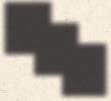


VIMIDA. YOUR FISH – OUR PASSION. Timeless tradition and modern machinery Lesta 7, Tallinn, Estonia Phone: +372 555 05 777 E-mail: info@vimida.ee www.vimida.ee Please contact us for more information and to place an order
[ EVENTS ] EUROFISH Magazine 3 / 2024 23

Dr Lem highlighted the growing emphasis on traceability in the industry, and pointed out how aquaculture continues to lead the development of traceability systems within agriculture at large. In further support of the spirit of collaboration, he concluded that governments must welcome input from industry if they are to successfully meet the challenges facing today’s global markets.
Carlos Tavares Ferreira, Sustainability Manager at the Spainbased Stolt Sea Farm, described the real-world challenges of
data collection and data management at the farm level and highlighted the need for workable long-term solutions. He called for support from other supply-chain stakeholders so that, together, they could overcome the challenges facing the industry.
Certification as a tool to demonstrate responsible aquaculture
As a standard-setter for aquaculture and other agriculture sectors, GLOBALG.A.P. constantly seeks input from industry stakeholders
to provide solutions that promote responsible farming around the world. Remko Oosterveld, Aquaculture Key Account Manager, GLOBALG.A.P., represented the brand in the discussion. “Only with cross-stakeholder collaboration can we, as an organization, develop standards that meet the requirements of the whole industry,” he said. “To achieve increased transparency and traceability, with increasing requirements, cooperation with all stakeholders in the supply chain is vital. GLOBALG.A.P. ultimately exists to support the whole sector.”
According to Teresa Fernandez, Sustainability Senior Manager for Seafood and Crops at Hilton Foods Ltd., certification is a tool for suppliers to give tangible proof that they are operating responsibly. “Certification is the baseline for everything that we are doing, and we appreciate holistic approaches that benefit the whole supply chain,” she said. Seafood processors like Hilton Foods favour raw materials sourced from certified producers because certification to trusted standards helps to mitigate risks in the complex aquaculture supply chain.
Audun Lem, FAO; Dawn Purchase, Marine Conservation Society; Teresa Fernandez, Hilton Foods; Carlos Tavares Ferreira, Stolt Sea Farm; Remko Oosterveld, GLOBALG.A.P.; and Marco Frederiksen, Eurofish International Organisation, discuss transparency and traceability in the aquaculture supply chain.
[ EVENTS ] 24
AlgaeProBanos project meeting, 3-4 April 2024, Copenhagen
Giving the EU algae sector a boost
AlgaeProBanos is a Horizon Europe project that aims to demonstrate the viability of and market accessibility for sustainable and innovative algae-based products and solutions in the Baltic and North Sea areas.
AlgaeProBanos contributes to promoting a European algae industry by supporting the development of a broad range of innovative algae-based products thereby creating new sustainable regional industries and boosting economic growth.
On 3-4 April the AlgaeProBanos consortium assembled in Copenhagen at the headquarters of a project partner, Eurofish International Organisation, for the annual project meeting. More than 60 participants—representatives from various companies, partner organisations, and different countries—attended the meeting.
Partners generally satisfied with the progress made in the project
On the first day, progress made in the first period of the project was presented and discussed in detail. The latest deliverables, such as the interdisciplinary multi-level sustainability assessment framework for micro- and macroalgal value chains, and milestones like the “Train the trainers” online workshops were evaluated. Views on these topics were exchanged and developments in specific areas of algae production and processing were debated. Participants also received information and progress updates from sister projects of AlgaeProBanos,
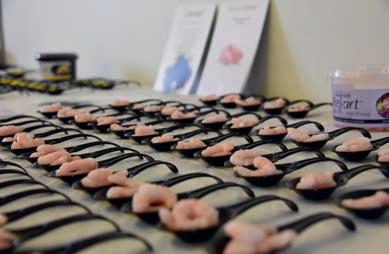
Algae-based shrimp, caviar, and chips were among the innovative products that participants at the meeting got to sample courtesy the Danish company, Jens Møller Products ApS.
namely Locality, Seamark and EU4ALGAE.
The following day, besides familiarising themselves with broader areas of working with algae, attendees tested the digital tools that are under development within project tasks and provided feedback to help improve them. One such tool, Algae Economist, is a biorefinery tool to screen and optimize the economics of algae production, while another, AlgaeBrain, will assist researchers to rapidly find relevant answers to specific questions.
Danish producer shows the potential of algae
The meeting concluded with a field trip to the facilities of the company, Algiecel, just outside Copenhagen, where a pilot project is in progress that provides bio-solutions for decarbonisation, i.e. a modular microalgae photobioreactor. Participants gained firsthand knowledge of the challenges and progress of the work at Algiecel where they could study a photobioreactor built into a shipping container. The reactor was integrated into
the production of sustainable, low-carbon natural microalgaebased ingredients rich in protein, omega-3s, and vitaminsfor use in feed, food, and cosmetics.
A post-meeting survey revealed that the attendees all profited from the information received during different presentations and group work, but more importantly from personal meetings, idea sharing, and brainstorming with other participants.
Eva Kovacs, Eurofish, eva@eurofish.dk
[ EVENTS ] EUROFISHMagazine 3/202425
Study shows active sludge technology’s potential to treat waste from saltwater land-based fish farms
Making marine RAS more sustainable
In a recent experiment Louise von Gersdorff Jørgensen from the Faculty of Health and Medical Sciences, University of Copenhagen, together with Bent Urup, Jeremy Gacon, and Stefan Rathje Lund from Aqua-Partners ApS, Fredericia, treated the discharge from a saltwater recirculating aquaculture system (RAS) in a pilot active sludge system, applying a technology generally implemented in sewage plants. The scientists’ results were overwhelmingly positive with one reservation that they felt could easily be addressed.
From an environmental perspective, a Recirculating Aquaculture Systems (RAS) may not always be as sustainable as one might assume. On a RAS farm, cutting-edge technology eciently separates organic waste into sludge. It also transforms ammonia into nitrate, a form of nitrogen, which even in relatively high concentrations is harmless to the sh. Although water is recirculated, a small discharge volume (0.5-1 of the recirculated volume) remains. e internal cleaning process typically splits this discharge into two fractions: a sludge fraction from mechanical ltration, and a potentially low BOD (biochemical oxygen demand), particle-free fraction with high levels of phosphorus and nitrogen (in the form of nitrate). Although much reduced, these
discharges need further processing, otherwise the net discharge of phosphorus and nitrogen to the recipient will remain nearly equivalent to that of a ow-through sh farm. Various technologies have been developed for denitri cation and for the removal of phosphorus in freshwater. And the concentrated sludge from freshwater sh farms, has the potential to be used either as a fertilizer for agriculture or in biogas plants.
Saltwater RAS present unique issues
e challenge lies in nding e ective methods applicable to saltwater RAS plants. e sludge from marine systems contains a high salt content, posing dilemmas for its use as fertiliser or in biogas




plants. Furthermore, removing nitrogen through denitri cation under anaerobic conditions can lead to the production of sulphide—a toxic and notoriously
pungent compound. Nevertheless, as the discharge water from a RAS plant is minor compared to the discharge from a ow-through farm (or from cage farming), more

[ PROJECTS ]
Figure 1, layout rendering of the small-scale active sludge implementation plan within Hanstholm RDF aquaculture facility.
Figure 2, the top of the sedimentation tank (Tank 4) showing accumulation of floating sludge under saltwater conditions.
Figure 3, the top of the denitrification tank (Tank 2) showing accumulation of floating sludge under saltwater conditions.
26
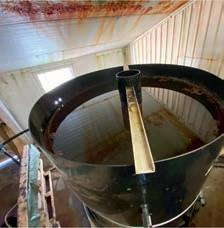

options are available for processing and cleaning. One tried-andtrue method for denitri cation is the active sludge technology used in sewage plants. Here, the sludge serves as the organic carbon source for denitri cation. is o ers cost savings by reducing the need for alternative energy sources like methanol and reducing the overall volume of the concentrated sludge generated. e consequence is a sludge fraction with a greatly reduced organic content that can no longer be used for biogas production. However, in the seawater scenario, the reduction in sludge volume produced, would be an advantage, since repurposing concentrated seawater sludge is more challenging.
Pilot
project hosted by
commercial producer of rainbow trout
e experiment took place at Royal Danish Fish (RDF), a company with a recirculating aquaculture facility for rainbow trout (Oncorhynchus mykiss) in Hanstholm,
Tank 1. Methanol input in Tank 1 is either increased or decreased depending on Tank 2 carbon requirement.
• Tank 3: Aeration tank for the removal of the nitrogen gas that results from denitri cation, and for increasing the oxygen level in general. In addition, within this tank iron chloride was added via a dosing pump to reduce the level of phosphate (phosphate precipitation) in the clean water outlet of the system.
• Tank 4: Sedimentation tank for the separation of clean water (top outlet) and sludge (bottom outlet). Sludge returned to Tank 1 to increase the level of particles and organic matter required for proper
denitri cation and/or sludge repurposing/collection.
e water source of the smallscale active sludge inlet was the mixed discharge from a single production section within RDF. is was pumped to Tank 1 of the small-scale active sludge system. e ow within the system started from Tank 1, then went to Tanks 2, 3, and 4. Finally, from Tank 4, the water ow is partially split with approx. 65 of the ow being skimmed o from the surface of Tank 4—the skimmed surface fraction considered to be the clean fraction, now free of particles, and the fraction supposedly suitable for discharging into a recipient (it was noted that this clean fraction proved not to be
Denmark. e small-scale active sludge installation consisted of four interconnected tanks (Figure 1) and a control system to manage various ows as well as oxygen levels. e installation was delivered, and testing protocols were developed by Aqua-Partners ApS. e active sludge system was allowed to mature for a few weeks, with RAS discharge water supplied to the installation before the experiment was launched.
e study involved the monitoring and analysis of various water parameters at multiple points within the experimental system, including the discharge water supply into the system, the outlets and within each of the four tanks.
• Tank 1: Denitri cation using organic matter from RAS farm outlet and from return ow of Tank 4. In addition, methanol (carbon source) was supplied by a dosing pump at a desired rate.
• Tank 2: Denitri cation using remaining carbon source in
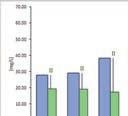
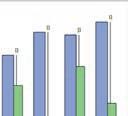
5, denitrification rate during testing days under saltwater conditions, including concentrations of nitrate before and after treatment, and the percentage of reduction obtained.
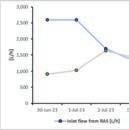
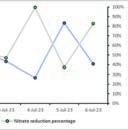
Figure 6, correlation between average nitrate reduction (%) and measured inlet flow (L/h), underlying the relationship between denitrification rate and flow dimensioning. When flow is voluntarily increased, nitrate reduction decreases as retention time decreases.
[ PROJECTS ]
Figure
EUROFISH Magazine 3 / 2024 27
Figure 4, the top of the sedimentation tank showing effective sedimentation and no significant accumulation of floating sludge under freshwater conditions (a parallel experiment within the project).

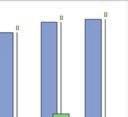
gas compared to freshwater. As a result, the higher salinity contributes to the sludge remaining buoyant for a longer period.
c) A third critical factor is the di erence in bacterial activity as bacteria develop at higher rate in seawater compared to freshwater. is may not only a ect the denitri cation rate but may also in uence when and where the sludge is produced.
Nitrogen reduction efficiency in salt water
approximately six times that of the inlet water volume appears to be su cient when the temperature is within the range of 18-20 degrees Celsius. e results indicate true potential. ere is also little doubt that sludge handling within an active sludge denitrifying installation for seawater can be optimised well beyond what was practiced during this experiment.
Process of phosphate removal proves highly effective
fully free of particles when dealing with seawater as opposed to when the experiment was carried out in freshwater). e remaining ow went through the bottom outlet of Tank 4 and consisted of accumulated sludge of which the majority was redirected to Tank 1, while a smaller fraction was harvested from the system for potential further concentration (beyond the scope of this study). By adjusting the amount of sludge harvested against the ow of sludge returned to Tank 1, the sludge concentration within the system could be managed and controlled.
Floating sludge challenges in salt water
e main challenge observed in the saltwater experiment was the oating sludge accumulation (Figures 2 and 3). e design of the sludge separation tanks followed principles commonly used in sewage plants, where the clean fraction (without sediments) is skimmed from the surface of the tank. However, when using this design in saltwater a signicant mixing of sludge with the desired clean (sludge-free) fraction occurred. While this design worked e ciently to generate clean water at the main surface
outlet in freshwater (Figure 4), it seemed to be less e ective for saltwater. In saltwater conditions, the accumulation of oating sludge was not limited to the sedimentation tank (Tank 4); it was particularly pronounced in the second denitri cation tank (Tank 2) as shown in Figure 3. Interestingly, this phenomenon was not observed in the rst denitri cation tank.
e amassed oating sludge at the surface of Tanks 2 and 4 (Figures 2 and 3) can be explained assuming the following factors:
a) e di erence in gravity between seawater and freshwater. Seawater has a higher speci c gravity, which naturally causes particles to oat more in seawater compared to freshwater.
b) Another signi cant factor is the denitri cation process. During this process, gaseous nitrogen is produced, and some of it becomes trapped in the particulate material. is e ect is more pronounced in a seawater system due to the speci c gravity of seawater and higher denitri cation activity. Additionally, the higher surface tension of seawater limits the release of
e results from this experiment demonstrate high e ciency of denitri cation in seawater, achieving nearly 100 e ectiveness. However, as illustrated in Figure 6, it becomes evident that retention time plays a crucial role. e results indicate that a retention time within the denitri cation tank within the range of 6 hours would likely be appropriate for achieving a high rate of denitri cation at the applied temperature. is is compatible with other experiences with denitri cation plants which do not involve active sludge, but solely rely on a simple energy source such as methanol. What may not be immediately evident from the results is the impact of sludge as the energy source, which substantially contributed to oxygen depletion and denitrication. Even in the absence of added methanol, Denitri cation tank 1 exhibited notably low oxygen content, while Denitri cation tank 2 saw complete oxygen depletion. In conclusion, this experiment highlights the suitability of active sludge technology for e ciently removing nitrate nitrogen from the discharge water of land-based marine sh farms. When dimensioning the denitri cation tanks, a volume
e removal of phosphate using FeCl (iron chloride), resulting in phosphate precipitation, is a chemical process that does not require a maturation time to be operational. Consequently, FeCl was only introduced during the testing phase. While FeCl was not added on the starting day of the testing phase, we still observed a positive impact from the active sludge process in seawater, with a 17 reduction in phosphate levels between the inlet and the outlet. During the testing period phosphate removal was highly e cient, achieving nearly 100 removal. e only exception to this was observed on 5 July (Figure 7) which coincided with an increase in the system’s inlet ow. is increase in ow reduced the retention time within the system. As shown previously, it is apparent that denitri cation and retention time are correlated. However, regarding phosphate removal, it might be slightly less straightforward, as the same quantity of FeCl was administered to this larger ow of water, resulting in a lower concentration. It is therefore possible that by commensurately increasing the amount of FeCl added, similar results could have been realised even with increased ows. During the seawater experiment,
[ PROJECTS ]
Figure 7, phosphate precipitation efficiency during testing’s days under saltwater condition, including concentrations of phosphate before and after treatment, and the percentage of precipitation obtained.
28


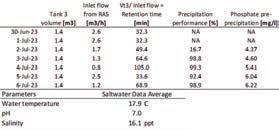
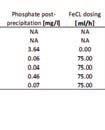
the dosing of FeCl was xed at 75 ml/h (Table 2).
It is worth mentioning that throughout additional testing conducted in freshwater (not discussed in this article), the dosing of FeCl was reduced from 75 mg/h to approximately half this level. We observed only a modest reduction in performance, going from around 99 to approximately 98. This suggests that the FeCl dosage can be optimised, and it is possible that we may have been overdosing in our experiments. The experiment therefore only indicates the potential of relatively small amounts of FeCl to almost eliminate phosphate in the outlets, whereas the actual dosing of FeCl should be further optimised for commercial use.
Retention time critical to nitrate reduction
The performance of the active sludge concept for reducing nitrate concentrations on discharge water from the RAS farm was surprisingly high, reaching above 80 on day 5 and 6 of the testing period. Throughout the testing period, two key factors significantly influenced the performance of the active sludge. Firstly, retention time emerged as a crucial determinant. Notably, a direct correlation was observed between retention time and nitrate reduction; the higher the retention, the higher the nitrate reduction rate. This insight underlines the importance of careful dimensioning of the denitrification tank; the results indicate that the tank
gravity and surface tension compared to freshwater. However, due to the lower water content of the floating sludge compared to the sludge settling at the bottom of the sedimentation tank, it might actually be an advantage, as it could reduce costs related to waste handling— under the condition that the technology is modified to take advantage of the floating characteristics of sludge generated in seawater.
In conclusion, the experiment highlights the potential of active sludge technology to enhance sustainability in seawater RAS farms by addressing nitrate and phosphate levels e ectively, while also identifying operational challenges, for which it appears that solutions can be developed.
volume required for denitrification to obtain more than 80 nitrate reduction, would be in the range of 6 times the hourly discharge volume (at 18-20 degrees Celsius water temperature). A second parameter impacting the performance was, as could be expected, the organic matter content of the sludge delivered to the denitrification tank. Surpassing expectations, the pilot active sludge plant also demonstrated exceptional performance in phosphate precipitation, with reduction rates exceeding 90.
The main challenge encountered during the experiment was the floating sludge. Several factors may have contributed to this phenomenon, including seawater’s higher specific
While the experiment described above exclusively focuses on the performance results of active sludge technology under seawater condition, it was just one of a series of studies under a framework project (Active sludge and intelligent disease control in Model 3 Dambrug and Recirculating Aquaculture Systems) dealing with challenges and opportunities in land-based fish farming and funded by the Fisheries Agency under the Danish Ministry of Food, Agriculture and Fisheries, and the European Maritime, Aquaculture, and Fisheries Fund.
Louise von Gersdor Jørgensen PhD* (lvgj@sund.ku.dk), Bent Urup PhD**, Jeremy Gacon BSc**, Stefan Rathje Lund BSc** *Faculty of Health and Medical Sciences, University of Copenhagen, Denmark **Aqua-Partners ApS, Fredericia Denmark
[ PROJECTS ]
Table 1, summary tables of the denitrification performance in Tanks 1 and 2 under saltwater conditions.
Table 2, summary tables of the phosphate precipitation performance in Tank 3 under saltwater conditions.
EUROFISH Magazine 3 / 2024 29
The SmartAqua4FuturE (SAFE) EU research project
Seeking a revolution in freshwater aquaculture
SmartAqua4FuturE (SAFE) is an ambitious project funded by Horizon Europe that aims to revolutionise freshwater aquaculture. The project seeks to make freshwater aquaculture more environmentally friendly while increasing its financial stability by introducing circular economy approaches.
The world’s aquaculture production has increased by 54 since 2011 and remains one of the fastest-growing food production sectors, with an expected additional growth of 35 by 2030, according to the UN Food and Agriculture Organisation (FAO). Aquaculture growth within the European Union has, however, not seen a similar development and investments in this growth sector are therefore being encouraged by the European Commission.
One project that ts directly into this focus area is SAFE. is €4.5m Horizon Europe project aims to reduce the environmental impact and improve the economic viability of freshwater aquaculture by valorising unused resources like solid and liquid waste streams from systems based on recirculating aquaculture (RAS) and integrated multitrophic aquaculture (IMTA).
Launched in 2022 with 13 partners from nine countries across Europe, the diverse objectives of the SAFE project will be achieved through several work packages.
Aquaculture waste stream characterisation
SAFE aims to reduce the nutrient emissions from freshwater aquaculture systems by utilising
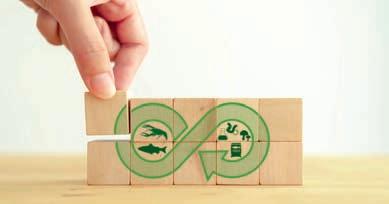
liquid and solid e uents in biomass production. A baseline of the selected systems was rst determined to assess the suitability and safety of the e uents as substrates for microalgae, mushrooms, redworms, and plant production and to quantify the e ect of SAFE solutions.
e study sites in SAFE include RAS (Finnforel, in Finland), IMTA (Keywater, in Ireland), pond (ICR, in Poland), and ow-through (Måsøval Åsen Sette sk, in Norway) systems. e systems have been sampled at least four times between November 2022 and February 2024 to take into account seasonal variations in the quality of incoming water, e uent, and
sludge. Samples have also been collected from the intermittent stages of the process. e samples have been analysed for macronutrients and trace elements with additional analyses (e.g. pesticides, antibiotics, and particle size) depending on site-speci c needs and the subsequent use as substrates. e analyses have been done locally (outsourced service/ in-house laboratories) and by consortium partners according to ISO standards and in-house protocols. e operators have provided additional environmental data such as pH and temperature. e sediment buildup in ponds (Poland) has been assessed by installing sonar technology and sampling cylinders at
the bottom of 10 selected ponds in Poland.
e results indicate no concerns regarding heavy metals, pesticides, and antibiotics. e constructed wetlands at Keywater and the treatment process at Finnforel e ciently reduce phosphorus discharges, whereas at the ICR farm there is no reduction of phosphorus levels from ponds to the discharge channel, highlighting the need for additional solutions to be tested in SAFE.
Innovation in aquaculture
e project has produced a broad overview of current technologies and innovative concepts applied
[ PROJECTS ]
Using circular economy approaches, the SAFE project aims to reduce the environmental impact and economic viability of freshwater aquaculture systems.
30
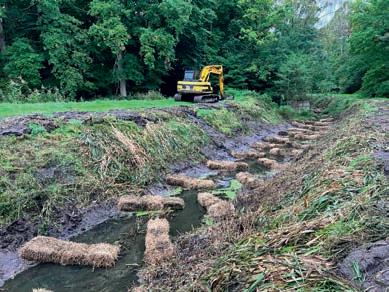
in the broader aquaculture sector, providing insights into current developments with potential applications for freshwater aquaculture production in the EU. It encompasses 55 state-of-the-art technological innovations spanning six main areas of innovation: Production system designs, waste management, aquafeed development, genetic improvement, disease prevention, and digital innovations. is provides a foundation on which the project can build and, in SAFE, has resulted in a prototype of a low-cost and natural ltering system for pond aquaculture using straw bales acting as a sieve. e system reduces the discharge of sediments from the ponds during their seasonal draining by altering the discharge water ow. Based on this prototype, a full-scale ltration system was developed in operational conditions at the ICR farm consisting of 69 sets of 3 straw bales
arranged in a herring-bone pattern along 134 metres of the drainage channel, diverting the water and forcing it to slow down and release its sediments. ese straw bales enriched with sediments were subsequently tested as a substrate for oyster mushroom (Pleurotus ostreatus) cultivation (see below).
e project designed a novel CO2 heat pump for RAS systems to be used with an existing dryer that will better enable the drying and exploitation of sludge from RAS farms. e implementation and installation at an operational RAS farm have not yet taken place.
Biodiversity assessment
e project also evaluates the impact of di erent aquaculture systems on local biodiversity before and after applying SAFE technologies/models in IMTA
the proximity of the Keywater farm in Ireland has been completed, the species diversity of benthic invertebrates assessed, and diatom samples are being analysed.
At the ICR farm (Poland), benthic diatom and macroinvertebrate samples from the in ow and out ow channels were collected during di erent seasons (spring, summer, autumn, and winter). To assess how the straw bale ltering system improves biodiversity downstream the farm, three water quality bioindicators, i.e., noble cray sh (Astacus astacus), thick-shelled river mussel (Unio crassus), and river water crowfoot (Ranunculus uitans) were placed in the water and their condition monitored.
Machine learning and image-based sizing tool
systems in common carp (ICR) and perch farms (Keywater). For reference, the impacts of a ow-through system with sludge collection on biodiversity were assessed for a salmon smolt farm in Norway.
e impact of the reference farm on the aquatic environment was assessed in summer, autumn and winter. A set of physiochemical parameters (e.g. pH, O2 level, conductivity, temperature) were characterised in water samples collected from Lake Ulen. Additionally, sonar technology was applied to prepare bathymetric maps of the lake and samples of macrobenthos (e.g. water mites) were collected at di erent depths. Furthermore, a spring sampling campaign in Norway is currently planned.
e seasonal sampling campaign at the selected sampling sites in
To enhance the management of sh biomass, with a particular focus on improving grading processes, the SAFE project seeks to minimise the handling of sh, reduce variability in weight, and maximise the e ciency of resource allocation during sh transfers. is will be achieved by developing a Discrete Event Systems (DES) simulator, designed to model sh growth and weight distribution considering various rearing conditions such as water quality, temperature, and salinity. Complementing this simulator, a machine-learning model has been devised to predict growth patterns based on the simulator’s calibrated outcomes. is predictive model serves as a critical component of an optimisation framework for grading and resource management.
A key feature of the system is an imaging-based sh measurement tool. is innovative tool facilitates growth monitoring and data
[ PROJECTS ]
EUROFISHMagazine 3/202431
By laying straw bricks in a herring-bone pattern pond discharge channel, sediments are collected to be used as a substrate for growing mushrooms.

gathering on sh size and weight directly in their habitat, eliminating the need for physical handling and thus reducing stress and disease risk. e SAFE project developed this tool using advanced deep-learning techniques for image segmentation, identifying sh silhouettes in images taken above the tanks. Concurrently, an allometric model calculates the sh weights from these dimensions. is system can moderate the feed rates and measure water quality parameters in the experimental tanks.
Moving forward, this tool will enter a crucial phase involving the collection of empirical data from laboratory experiments and eld studies at aquaculture facilities. is data will not only facilitate the calibration of the simulator but also provide the essential information needed to train and ne-tune the machine-learning model. is comprehensive approach aims to signi cantly enhance the precision of sh stock management practices, ensuring sustainable and e cient operations.
Microalgae cultivation
e algae cultivation has been conducted using processed wastewater from the Finnforel RAS farm. In the initial growth trials with diatom Phaeodactylum tricornutum,
the RAS water was optimised by adding phosphorus and certain trace elements (e.g. Mn). Grazer ( agellates, ciliates) contamination appeared to be a signi cant issue that collapsed the cultures. e tests showed that to secure the purity of the water used for algal cultivation, the RAS wastewater needs to be ltered through a <1 µm lter and treated with UVC before being used as a growing medium. In addition, the cultivation unit should be closed to prevent contamination from the air.
Following the preliminary tests, the cultures were upscaled from 5 to 300 litres. e cultures in batch mode did not reach N-limitation, and hence, the cultivation mode was changed to semi-continuous with weekly/ biweekly harvesting by settling the biomass and collecting the settled material. To boost lipid production, the collected biomass was then cultivated in batch mode until it was N-decient (ca. 5 days), “after which it was centrifuged and frozen at -20 °C. e biomass was dried by freeze-drying, after which it was immediately vacuum-packed to prevent the oxidation of lipids., after which it was immediately vacuum-packed to prevent the oxidation of lipids.
e algal biomass production for sh feed trials and the
optimisation of lipid production are in process. Trials with sh sludge from RAS and experiments on bio occulation are planned for the upcoming year.
Aquaponics
Testing of decoupled aquaponics began in late April 2023 to investigate the utilisation of liquid e uent from RAS to cultivate edible vegetables and fruits in a greenhouse environment. SAFE experimented with di erent types of aquaponics systems, including nutrient lm technique, bell siphon technique, and ow through. A variety of plants, including spinach, various types of lettuce, mint, swiss chard, and watercress, were also tested, as were hops and grapes, in a separate outdoor soil- lled container.
On a daily basis, 30 L of RAS waste was added to the aquaponics system to monitor the resulting changes in water quality. Overall, the di erent decoupled aquaponics systems worked very well, with all the plants showing positive growth trends while maintaining good water quality. One trend that became obvious was the high PO4 levels, which will be further investigated in the coming growing season. A total biomass of 18 kg was produced during the growing season, which ended in Oct 2023. For the colder winter,
researchers are comparing wild growth with commercial watercress plants.
Mushroom production with dried sludge looks promising
So far, two materials have been evaluated as potential ingredients in substrates for the oyster mushroom (Pleurotus ostreatus) cultivation, namely, the straw bales enriched with sediments from common carp pond farming, as previously mentioned, and insect frass from mealworm (Tenebrio molitor).
e straw bales enriched with sediments were used as an ingredient for mushroom production at di erent percentages (0, 25, 50, 75, and 100) mixed with a commercial mushroom substrate. e best yields were obtained with the inclusion level of 25, followed closely by 50 and 75, all exceeding the control group. Only a 100 inclusion level resulted in lower yields compared to the control.
e mealworm insect frass was also used as an ingredient for mushroom production at di erent percentages (0, 15, 30, 45, and 65) mixed with the commercial mushroom substrate. e best yield results were obtained with a 15 proportion.
[ PROJECTS ]
32
Research in growing algae, plants, mushrooms, redworms, and mealworms using side streams from aquaculture can help make European aquaculture more competitive.
Since the yields with high percentages (>15) were lower than the control values, the trials were repeated using the insect frass supplement in smaller quantities to nd the optimal share. e second trial was performed with inclusions of 2.5, 5, 7.5, 10, 12.5 and 15 of frass. is trial showed that 2.5 gave the best results, exceeding the control yield.
A commercial-scale trial with straw bales enriched with carp farm sediments has been successfully accomplished, and a full-scale mushroom production using an innovative substrate from the carp farm has been demonstrated. e stems were dried using traditional drier and Waister drying technology (Waister AS, Norway), and the ground material was sent to the di erent partners to produce feeds for upcoming sh trials. e post-cultivation substrate from this trial will be dried and used as an ingredient for mealworm production. Trials will also be undertaken
with dried sh sludge from a salmon RAS farm as a mushroom growing substrate.
Redworm production
Redworm (Eisenia fetida) production started in April 2023. e worms were housed and grown in box containers in a 6.1 m insulated steel container. Each polystyrene box is lled with compost and 1 kg of worms. Duckweed from IMTA ponds is harvested and mixed with the compost along with sh waste from the Keywater RAS, to provide a food source for the worms.
For the rst three months, the worms used duckweed and sludge as a feed source, but they had limited maturity and reproduction after this point. e project is therefore conducting trials to investigate various ratios of duckweed to sh waste to make it more appealing for the redworms. SAFE is designing a workshop on on-site redworm rearing for carp farmers,
erefore, future biomass will be produced based on the oyster mushroom SMS instead.
e SMS used for mushroom production at di erent percentages (0, 25, 50, 75, and 100) was rst evaluated and mixed in with the control diet used, which is based on cereals. An experiment using only the control diet was also carried out. e substrates with 25 and 75 of SMS grew 14 and 11 higher than the conventional substrate in mealworms, respectively. e performance of the rest of the substrates (0, 50, and 100) was similar to the control. is suggests that the use of this by-product can both improve and accelerate the growth of these insects.
which is planned for Poland’s National Carp Conference in September 2024.
Mealworms
ree di erent substrates were tested for mealworm production: duckweed, watercress, and the spent mushroom substrate (SMS) from straw bale cultivation (as described above). e mealworm production was carried out by breeding larvae of a known age in laboratory scale boxes lled with the substrates in a de ned mass ratio for four weeks. On a weekly basis, the excrement, the larvae biomass, and the remaining substrate were weighed, and the feed was replenished.
e results of utilising watercress and duckweed biomass for mushroom culture showed that none of the samples performed better than the control group. Neither of these by-products improved the growth of mealworms. In contrast, the less watercress or duckweed, the better they grow.
Looking ahead
e SAFE project represents a signi cant step towards a more sustainable future for freshwater aquaculture. By applying circular economy concepts and introducing innovative technologies, the project aims to reduce the environmental impact of freshwater aquaculture systems and improve their economic viability. e preliminary results after only 18 months demonstrate the potential of these approaches and provide a solid foundation for the ongoing work of the SAFE project. e project’s success will bene t the aquaculture industry and contribute to the broader goal of sustainable development. e lessons learned from the SAFE project can also be applied to other sectors, making it a valuable resource for anyone interested in sustainability and innovation.
For more information, contact: omas Jensen, Euro sh contact@projectsafe.eu www.projectsafe.eu
[ PROJECTS ]
Freshwater microalgae Redworm Mealworm Duckwee d / w a e r c r sse Freshwater aquaculture employment increased by 20% Biodiversity impacts reduced by 30% Restoration of species in 7 locations 10% improved profitability 10% reduction of CO2 emissions from RAS Reduced local biodiversity impact (Reduced solid and liquid waste discharge by 10%) Reduced global biodiversity impact (15% global land use and water consumption) 10% reduction of fishmeal and soy-based protein dependance
goals 4 novel feed ingredients Carbon footprint reduced by 15% Cost reduced by 50% Increase in EU freshwater aquaculture consumption by 20% per capita Crayfish Fish Mushroom caps
SAFE
EUROFISH Magazine 3 / 2024 33
An overview of the goals that could be achieved by utilising research conducted in the SAFE project.

Adapting
to and mitigating climate
change impacts calls for new approaches
Challenges abound but so do opportunities
Magdalena Zasępa, director of the Department of Fisheries, is responsible for the implementation of the Common Fisheries Policy as well as for the development of fishing, both in Polish marine and inland waters, aquaculture, processing, and the market for fish and seafood. This extensive and demanding portfolio includes challenges, like the status of stocks in the Baltic and the impacts of climate change across the sector, over which the department has little control. Yet it must try and mitigate these phenomena’s effects on the ground. Ms Zasępa, who took office recently, explains here the efforts the department is making in this regard, and outlines her priorities for the future.
The current Polish Government took office relatively recently. What are its priorities regarding the fisheries and aquaculture sector? Will there be any significant changes in direction in comparison with the previous administration?
The current state of fish stocks in the Baltic Sea, which is the most important fishing area for the Polish fishing fleet, is worrying. The current government is taking measures to balance the fleet, however, the effect of implementing this measure might be a reduction in jobs. It is therefore necessary to support fishermen who wish to remain in the industry associated with their profession—in the aquaculture and fishing industry. It is also crucial for the scientific community to outline, considering the socio-economic aspect, a direction that allows for the recovery of stocks and the continuation of marine fisheries. To strengthen food security and to ensure that people can remain in the fishing profession, the government aims to further develop aquaculture, including in areas harbouring offshore wind farms and in inland regions.
In the next EU institutional cycle (2024-2029), the government will focus on activities that contribute to increasing the production potential of sustainable fisheries and aquaculture. The latter will enjoy subsidies that contribute to the establishment of new farming facilities and to the decarbonisation of existing farms. Future decisions will be based on environmental, social, and economic data collected from fishermen and aquaculture farmers.
The small-scale fleet generates the lowest environmental impact of all fleet segments, employs proportionally the most people, demands little in the way of subsidies and, despite growth in 2021, it is on a downward trend in terms of volumes and value. How can this decline be halted to encourage this segment to grow?
In the current difficult situation affecting Baltic fishermen, linked to climate change and reduced fishing opportunities, the Polish government is taking action to help local fishing communities develop and improve their situation. Measures are being taken to balance the fleet. Growing interest in healthy food and

public awareness of environmental issues are also creating new opportunities for fishermen. The ability to produce and sell fish and fish products from local fisheries can provide income for fishing communities. In addition, the development of waterside
tourism and the promotion of fishing traditions can attract tourists generating both economic and social benefits for local fishing communities.
Digitalisation of the fisheries sector is a priority of the
Magdalena Zasępa, Director, Department of Fisheries, Polish Ministry of Agriculture and Rural Development
34
POLAND


Polish programme of the European Maritime, Fisheries and Aquaculture Fund (EMFAF) for 2021-2027. What actions does the administration envisage that will lead to greater digitalisation of the sector and how will they contribute to more sustainable development?
Under the European control regulation, several changes to the EU fisheries control regime have been introduced with a view to using modern and more cost-effective control technologies. These consider the latest scientific findings to ensure, in the long term, the environmental sustainability of fishing activities. Several digital solutions have been introduced into the sector, including for smallscale vessels carrying out inshore fishing, to make catch data more reliable and comprehensive and the control of compliance with CFP rules more effective.
The EU regulations impose an obligation to monitor fishing vessels of less than 12 m in length by means of a vessel tracking system
(VMS or alternative system allowing automatic localisation and identification of the vessel at sea), as well as an obligation for these vessels to record catch data in a digitised manner and transmit them electronically to the competent authorities of the flag state. In addition, an obligation to remotely monitor certain fishing vessels for compliance with the landing obligation has been introduced, as well as an obligation for certain fishing vessels to install equipment for the continuous measurement and recording of engine power. Recreational fishing has also been digitised, requiring Member States to introduce electronic systems for anglers to record and report data. These requirements will apply from 10 January 2028.
In view of the above, the activities planned by the Polish administration leading to greater digitalisation of the marine fisheries sector will consist of transposing the above-mentioned EU requirements into national law. To facilitate fishing vessel owners and
electronic monitoring—CCTV) system on selected units over 18 m in length. The next step will be to implement a traceability system for fish products.
Climate change is a challenge for the fisheries and aquaculture sector, including warming waters, unstable weather and extreme events such as droughts and floods. What has been the impact of these changes on the fisheries and aquaculture sectors and what efforts is the industry making to adapt?
the fisheries administration to adapt to the new requirements, a measure Control and Enforcement of the Common Fisheries Policy has been envisaged under Priority 1, supporting sustainable fishing and the restoration and conservation of living aquatic resources. Assistance under this measure shall be granted for the development, implementation, and maintenance of a system for monitoring, control, or surveillance.
All fishing vessels under 12 m in length not yet subject to this obligation shall be equipped with the appropriate software and equipment for reporting (currently this obligation only applies to vessels over 12 m in length overall). In mid-2023, the administration introduced an obligation for all fish product purchasers to report first sale documents in electronic form. From January 2024 fishing vessels up to 8 m in length are obliged to transmit data contained in the monthly report electronically upon completion of fishing. In addition, it is planned to install a REM (remote
The impact of climate change is experienced by both the marine fisheries and the inland fisheries sectors. In the case of the Baltic Sea, climate change is among the factors that has affected cod and thereby the fishing industry based on this species. The condition of Baltic cod stocks has led to a ban on targeted fishing so that the species has a chance to recover. Inland fisheries also face similar problems mostly resulting in a reduction of economically valuable fish species such as vendace and eel.
Climate change also affects aquaculture. The rise in water temperature affects the rearing and breeding of trout, which are by nature cold-water species. Breeding and rearing facilities for warmwater carps are also affected by water and oxygen deficits caused by climate change. However, aquaculture undoubtedly has a much greater range of options for influencing fish rearing and breeding conditions and adapting to climate change compared to capture fisheries. These include a variety of technological measures ranging from the possibility of collecting water, recirculating it and enriching it with oxygen, to complete isolation from the external environment and complete
The Polish fish processing sector is a European powerhouse exporting a variety of products to countries across the EU and further afield.
EUROFISH Magazine 3 / 2024 35
POLAND
control of the production process. Breeders are also helped by targeted selection, as well as bioengineering introducing, for example, trout selection lines that are more resistant to increased water temperatures.
In contrast, changes in natural fish stocks are long-lasting and call for the restructuring of the national Baltic Sea fleet, retraining of fishermen, and various protective and remedial measures. In the marine fisheries sector, support for diversification of fishing activities will continue. In the aquaculture sector, it is envisaged to co-finance operations that reduce water consumption, increase water retention capacity, lessen the impact of aquaculture on the environment, or lead to decarbonisation of aquaculture farms.
Moreover, support is available for research or education on the environment, biodiversity, climate change, sustainable use of water or its living resources, and the impact of human activities on the state of the environment and aquatic ecosystems. Activities concerning education or training on climate change, energy system transformation, and sustainable blue economy business development will be supported. In addition, it is possible to support the protection and restoration of natural ecosystems and environmental biodiversity, which include investments or measures related to reducing energy or water consumption and streamlining the management of these resources, contributing to the reduction of CO2 emissions, promoting the production of energy from renewable sources, and increasing the use of recycled materials. These activities also include operations contributing to the creation or maintenance


electronically.
and preservation of the genetic diversity of fish spawning stocks and the construction or restoration of fish spawning grounds or their natural surroundings, including oxbow lakes, as well as those related to the reduction of eutrophication of waters and of pressure on the environment from human interventions.
While adaptation to climate change is one of the strategies for dealing with climate change and its effects, the fisheries and aquaculture sector must also reduce its contribution to greenhouse gas emissions by reducing energy consumption. What efforts are being made in this regard and how is the administration supporting these measures?
As mentioned above, in the field of fisheries, any decarbonisation of fishing vessels will be supported under the EMFAF Programme 2021-2027. It is also planned to
continue supporting the diversification of fishing activities as a response to the deteriorating conditions for fish catches. Meanwhile, in the field of aquaculture, it is also planned to support operations aimed at modernising and upgrading infrastructure (e.g. investments in modern, low- or zero-emission means of transport necessary for transporting aquaculture products) and improving the energy efficiency of fish farms (e.g. investments in facilities, equipment or technologies that reduce the energy needs of aquaculture farms and diversify energy sources).
In addition, funding is provided for operations that support innovation and technological development (i.e. pilot projects aimed at developing and implementing new fish farming or breeding technologies) or projects related to the application of recirculation aquaculture systems (RAS) and decarbonisation. The priority
given to projects contributing to the reduction of energy intensity and CO2 emissions from aquaculture is reflected in the project evaluation criteria.
The fish processing sector in Poland is one of the largest in the EU. A variety of products are produced and exported to the rest of the EU and other parts of the world. However, the sector also faces challenges such as labour shortages and a lack of automation. How can the administration help the sector to solve these issues?
The fish processing sector in Poland is developing very dynamically. In recent years, Poland has been among the EU’s leading producers of processed fishery and aquaculture products. At the end of 2022, fish processing was carried out by about 565 companies, of which 240 were authorised to export to the EU market. The production
Digitalisation affects even the smallest fishing vessels. As of this year fishers in vessels up to 8 m must report their catches
36 POLAND

of processed products amounted to around 604,000 tonnes and has remained at this level for several years. Fresh, frozen, and processed products, as well as smoked fish are the most important items. Companies obtained support for the expansion, modernisation, and automation of production facilities from the European Maritime and Fisheries Fund 2014-2020. Close to sixty projects related to the modernisation of machinery and the purchase of production lines valued at PLN78 million (EUR18m) were supported by the fund. Under the current EMFAF 2021-2027, funding is available for the implementation of operations aimed at supporting the strengthening of technological development, innovation, and knowledge transfer. Aid may be granted for the construction of new buildings for processing, storage, warehousing, and for the extension or renovation of existing facilities; for the purchase of new machinery, equipment, and appliances for processing, storage, warehousing, transport, and of computer software.
Even though Poland is a significant producer and exporter of fish products, consumption of fish and seafood is far below the EU average. What efforts are being made by the industry and the administration to encourage greater consumption of fish? What are the results of these efforts?
The consumption of fish products in Poland in 2022 was estimated at 13.68 kg per capita and has gradually increased in recent years. The estimated average consumption in 2023 may be around 13.51 kg/ capita. The main species consumed in Poland for years have been marine fish—Alaska pollock and herring, as well as sprat, mackerel, Atlantic salmon and coalfish. Poles mainly consume frozen and fresh products, and the consumption of fish sold in bulk (74) is higher than the EU average (68, including the UK).
To understand the market, consumer preferences and build contacts with importers, trade missions coordinated by trade/export organisations and
WPUT’s Food Science and Fisheries Faculty
exhibition fairs such as POLFISH, held every two years in Gdansk, on the Baltic Sea in northern Poland, are organised. Polish entrepreneurs also participate in the Seafood Expo Global Exposition, which is an important event promoting Polish fish products and industry. Fish products are sold in specialised shops, supermarkets and hypermarkets, as well as in small independent grocery shops. Supermarkets and hypermarkets offer the most dedicated shelf space and a wide selection of processed fish and seafood products. Many hypermarkets also offer a wide selection of fresh seafood. Small independent grocery shops usually lack this option, but offer processed, frozen products. Polish producers are keeping up with today‘s consumer preferences and produce with care for their quality, without the use of artificial additives and preservatives, and are introducing environmentally friendly packaging. More and more fish products are included in the group of functional foods targeting specific groups of consumers, e.g. children, people with cardiovascular diseases.
Fish processing companies can obtain co-financing under the measure „Conscious Consumer“ of the European Maritime, Fisheries, and Aquaculture Fund 20212027. Aid under this measure is granted for marketing activities supporting the organisation and development of the market for fish products, raising consumer awareness about seafood, or improving quality, hygiene, and food safety. These activities are carried out through the organisation of national or international information or promotional campaigns, or through participation in national or international trade fairs and exhibitions. In addition, the measure support improving the conditions for marketing fish products, marketing new fish products or finding new customers. These objectives are mainly pursued through the provision of product publicity services (spots in the media, advertising at trade fairs/exhibitions, renting advertising space, etc.). The electronic sale of fish products is also being developed through support for the purchase of appropriate IT systems.
Cross disciplinary cooperation is a strength
The West Pomeranian University of Technology (WPUT) was formed from the merger of the Agricultural Academy in Szczecin and Szczecin University of Technology. Although WPUT started officially in 2009 the parent organisations have pedigrees that are over 70 years old.
Today, WPUT boasts 10 faculties, over 1,000 academic staff, 47 fields of study and around 13,000 students enrolled in bachelor, master, or doctoral programmes.
The Faculty of Food Science and Fisheries offers fields of study in fisheries, food technology and human nutrition, and microbiology and some 10,000 students have graduated from here since its inception. Led by Prof. Krzysztof Formicki, the dean, the faculty is broadly split into two complementary parts, aquaculture and fisheries; and food technology including dietetics. It is spread over three buildings, one housing food technology, another for aquaculture and fisheries, while the third accommodates the Centre of Innovative Packaging Materials.
POLAND EUROFISH Magazine 3 / 2024 37

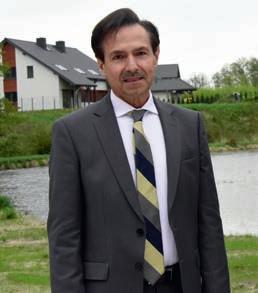
Laboratories stocked with the latest equipment
The faculty is also distinguished by its museum which has a huge collection of aquatic organisms many of them donated by students or former students who were out in fishing boats in various parts of the globe collecting samples. These graduates form a useful network on which the faculty can draw when necessary. Thanks to active participation in EU-funded projects, the various laboratories in the faculty are well equipped with the latest machines. Prof. Formicki emphasises that there is a lot of cross disciplinary cooperation between students and staff at the different departments. In the Mobile Research Centre the behaviour of fishing nets is studied generating information that will be useful for both fishers and net manufacturers. Students
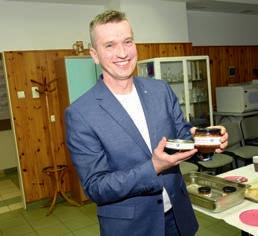
at the faculty are encouraged to join groups called scientific circles where they meet others studying related subjects. Thus, for example, the Food Technology Association brings together students interested in various aspects of food technology, while the Aquaculture Association focuses on ornamental fish.
Fish products designed to convince sceptics
The faculty’s Department of Food Science and Technology is led by Prof. Grzegorz Tokarczyk who, together with his team, develops innovative products based on fish and seafood. Among them is a breadstick made from fish meat and starch, and another concerns the use of low value species to make snacks. The mission of the department, Prof. Tokarczyk explains, is to develop novel products and the technology to make
them in the hope that they will prove attractive to commercial manufacturers. The obstacle is that fish consumption in Poland is low and is growing only very slowly. This makes fish-based products hard to sell on the domestic market especially if they are new. Prof. Tokarczyk’s way around this is to disguise the fish so that consumers do not realise what they are eating. While the bread sticks have a fish content of 20, fish
chips have 50, and a fish burger developed by Prof. Bielkiewicz, a member of Prof. Tokarczyk’s team, is 80 fish. However, the taste of fish is virtually absent in all the products perhaps to make them more appealing to the public. Prof. Tokarczyk feels that if consumers can be persuaded to eat fish products with little or no taste of fish then the research will have achieved what it set out to do— increase the consumption of fish.
Faculty of Food Science and Fisheries
West Pomeranian University of Technology
Kazimierza Królewicza 4 st., room 28
71-550 Szczecin
Poland
Tel.: +48 91 449 66 54 dziekanat.wnozir@zut.edu.pl https://wnozir.zut.edu.pl/index. php?id=3586&L=2
Dean: Prof. Krzysztof Formicki
Departments:
− Food Science and Technology
− Meat Science
− Centre of Innovative Packaging Materials
Number of students: 1,000
Fields of study:
− Fisheries
− Food technology and human nutrition
− Applied microbiology
Degrees offered: Bachelor, master, doctoral
Prof. Krzysztof Formicki, dean of the Faculty of Food Science and Fisheries
Prof. Grzegorz Tokarczyk, head of the Department of Food Science and Technology demonstrating some of the products made in the department lab.
38
POLAND

A new seal-proof and seal-friendly fishing gear
The Baltic fish pot shows its merits
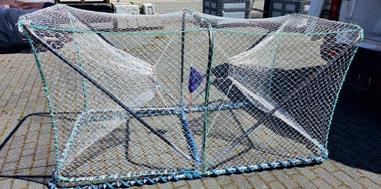
Trials showed the Baltic fish pot to be able to withstand seals. The fish trapped in the fish pot were still living when harvested, resulting in a high-quality product.
Katarzyna Stepanowska, an associate professor at the Faculty of Food Science and Fisheries, specialises in fisheries and for the last three years has represented small-scale fishers acting as a contact point between the sector, the decision makers (e.g. Department of Fisheries, Ministry of Agriculture and Rural Development) and the scientists at the faculty. She, together with colleagues, and members of a fish producers’ organisation (PO) were interested in reducing the impact of fishing on the marine environment including by minimising or altogether avoiding unwanted catches. The project objective was to design and test an alternative fishing gear, the Baltic fish pot. The researchers examined the species and length composition of the fish in the catch and also assessed the gear’s ability to protect the catch from predation by seals. Over 20 boats from the PO took part in the trial fishing that ran from July to end November 2023 where the fishers used either gillnets, hooks, or the Baltic fish pot. And 30 fishing trips were carried out with each of the vessels. The fishing effort consisted of bait being placed in the fish pot which was set out for at 16 hours. In addition, one commercial gillnet or 1,000 hooks were set.
The fishers filled out the catch data as well as the Baltic fish pot survey catch sheet which included the fishermen’s mark, number and location of fish pots set, characteristics of the comparison gear—gear type, set length, mesh clearance, fishing time, depth of the fishery, type of bottom, meteorological conditions—sea state, wind strength and direction, water temperature, number of fish, species of fish caught and their weight within species. After each fishing trip the researchers were handed the completed survey catch sheet and the fish caught by the gears (fish pot, hooks, and gillnet), which were measured and weighed. The study revealed that three fish species dominated the fish pot fishery, cod, flounder, and shorthorn sculpin (Myoxocephalus scorpius). The fish were alive and in good condition in the fish pot. Occasionally the fish pot contained a significant number of jelly fish at which time no fish were observed. Grey seals showed interest in the fishery and damage to the gillnets and trapped fish was noted, but no damage to the fish pot was seen. Finally, there were two incidents when seals became entangled in the gillnets. The researchers concluded that the Baltic fish pot was seal friendly and seal proof, but that more research was needed in other parts of the Baltic coast and over a longer period to confirm these results. Prof. Stepanowska is therefore preparing a new project that envisages testing the Baltic fish pot for a whole year.
Another project (https://interreg-baltic.eu/project/roundgoby/) she is involved in is about using round goby (Neogobius melanostomus), an invasive species in the Baltic, for human consumption since it is of significant nutritional value with high levels of protein, omega 3 fatty acids, and vitamin E. Declining quotas for traditional Baltic species such as cod and herring and the impact of round goby on native species are additional reasons to develop a targeted fishery. However, there are challenges to be overcome before this can be realised. Fishing gear needs to be designed or modified to avoid by-catches of other species, and processing lines will have to be adapted to process the fish. However, the biggest issue is perhaps the lack of a market in the Baltic area where the fish is unknown to consumers. The project hopes to address these questions and capitalise on the benefits that round goby consumption could bring to the public and the fishing sector.
Associate Professor Katarzyna Stepanowska
Department of Aquatic Bioengineering and Aquaculture
Faculty of Food Sciences and Fisheries
West Pomeranian University of Technology in Szczecin
Tel.: +48 510 053613
greyseal@o2.pl
POLAND EUROFISH Magazine 3 / 2024 39

Valorising waste from freshwater aquaculture
Prof. Remigiusz (Remi) Panicz, researcher and dean’s representative for international scientific and educational cooperation, works at the Faculty of Food Sciences and Fisheries, where he represents WPUT in the SAFE project. This aims to reduce the environmental impact and improve the sustainability of freshwater aquaculture by valorising the solid and liquid wastes from systems based on recirculating aquaculture (RAS) and integrated multi-trophic aquaculture (lMTA). According to Prof. Panicz, the economic viability of freshwater aquaculture will be improved through major advances in management systems and the integration of waste streams from freshwater aquaculture systems into the aquaculture feed chain. Any improvement in the economics of aquaculture production is to be welcomed as the sector has been stagnating for years in the EU, while production in other parts of the world has rocketed. SAFE will promote the uptake of these solutions through local and regional scale demonstrations across the EU and will document the necessary management and governance conditions for successful transferability.
Partners in the SAFE consortium represent different disciplines, systems, species, and geographies and will target the enhancement of species of particular concern, such as the native noble crayfish (Astacus astacus). We will improve the sustainability of freshwater aquaculture and investigate the feasibility of diversification through the culture of under-represented species (perch) and of crayfish species with declining populations, says Prof Panicz. Lastly, we will compare the experiences of EU freshwater aquaculture with those from China which has the largest, fastest growing, and most diverse aquaculture sector in the world. This exchange of knowledge through extensive dissemination activities, knowledge transfer programmes, training workshops, and collaborative engagement with industry and stakeholders, will support the development of professional skills and competencies of the freshwater aquaculture sector and should contribute to improve the sustainability of aquaculture both in China and the EU.
Remigiusz Panicz
Faculty of Food Sciences and Fisheries West Pomeranian University of Technology in Szczecin
Tel.: +48 515 298423 rpanicz@zut.edu.pl
Polish Angling Association hatchery in Goleniów
Restocking waters in West Pomerania
The recreational fishing sector in Poland is vast with an estimated 1.5m practitioners1. Poland has abundant freshwater natural water resources in the form of lakes and rivers and they encourage angling both by domestic tourists and foreign visitors. Turnover in the sector is assessed at EUR300m, a figure that is growing as increasing numbers show an interest in angling and demand for high quality fishing tourism is on the rise.
To further promote interest in the sector angling associations restock the waters under their management with juvenile fish. This activity serves the dual purpose of providing fish for their members to catch and securing the natural populations of fish in the water bodies.
Hatchery meets multiple demands
In Goleniów, some 40 km from Szczecin towards the north, the Polish Angling Association maintains a hatchery for different fish species. The association has leases for angling areas which amount to several thousand hectares of water
mainly in West Pomerania. Juvenile fish reared at the hatchery are used to restock these water bodies for the benefit of the angling community. In addition, the fish are sold to fish farmers and to other holders of angling area leases who need fish to restock these areas but do not have their own hatchery. Building and running
a hatchery calls for significant investments in land, construction, equipment, and qualified staff. At the Goleniów hatchery between 5 and 10 people are permanently employed. And at least one employee is present 24/7 to ensure that all systems function smoothly even in an emergency. A power failure, for example, must
The SAFE project
1 Zbigniew Głąbiński, European Research Studies Journal, Volume XXVI, Issue 4, 2023 40 POLAND

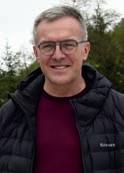
trigger the back-up system immediately for otherwise there could be a catastrophic loss of fish.
Rafał Pender, the director of the district office of the Polish Angling Association in Szczecin, says that 18 species of fish are produced at the hatchery giving a combined annual output of several million fish. However, the total is not equally divided between all the species produced—some are produced in smaller numbers than others. Production is vertically integrated; the hatchery maintains broodstock for the different species, the fertilised eggs are hatched, and the larvae grown to a certain size prior to release in the wild. The broodstock is caught from the lakes or the rivers that the association leases and is maintained in small ponds close to a river. Sea trout are allowed to mature naturally in these ponds and when they spawn the roe is collected and brought to the hatchery. Other species need to be stimulated to spawn so when they are ready, they are brought to hatchery and treated to encourage spawning, The size at which the young fish are released varies from species to species; sea trout for example are released at 0.3 to
0.4 gram which is very soon after the eggs hatch.
Both open and closed systems feature at the hatchery
The hatchery has different water circuits that feed the tanks where the fish are reared. Some tanks form part of a flow-through system where the water in the hatchery comes from a river. Apart from filtering this water is not treated in any way, it flows through the hatchery and then flows out again. We want the incubation, hatching, and early growth of the fish to take place in water conditions that are as close to natural as possible to make them more resilient, Mr Pender explains. The water temperature in the hatchery is the same as it is outside. Although it would be possible to make it so, the system is not sterile. There is also a closed loop system linking some of the tanks where the water is recirculated and parameters like oxygen content and temperature are controlled. A biofilter for this part will also start operating in the future. Water for this system comes from deep underground and only about 5 is replaced every 24 hours. This system will be used to produce pike and it will enable the hatchery to produce larger fish that stand a better chance of survival when released. As Mr Pender says, in certain bodies of water small pike will not survive predation by other fish, so it is necessary to release them only when they are larger and more robust. The hatchery has a mortality rate of about 5. The challenge is really the rivers, which suffer from low levels of dissolved oxygen, and a lot of suspended material, among other issues. Some of the species raised in the hatchery, such as ide (Leuciscus idus), spend some time in a nursery, a set of lowland ponds that the hatchery maintains
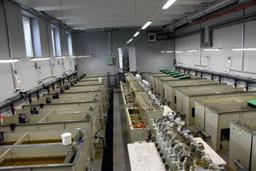
at a different location, before they are introduced into the river. Conditions in the nursery ponds are semi natural; the fish are given supplementary feed until they reach the desired size and are then released into the river.
Angling areas allocated based on competitive bidding
The allocation of the angling areas to the associations or other parties (fish farming cooperatives, fish farms, even private individuals) is based on a competition between the applicants who each submit a proposal to the Regional Management of Inland Waters, a state authority. The proposals include commitments that the applicants make and which they are obliged to fulfil if they win a contract. Among the criteria that are weighed in an application are the species that will be restocked, the number of species, the quality of the juveniles, and the qualifications and experience of the staff responsible for managing the lease. If the staff includes an ichthyologist the application will be weighted higher than if not. Although not the most important, the rent that the management authority will be paid by the lessee is another
factor. The management authority compares the applications and decides on the one they like best or that scored the most points and then sign a long term contract with the successful applicant. Owning a hatchery, as the Polish Angling Association does, also adds weight to the application as this facilitates restocking. The association now leases 6,000 ha of water surface in the former Szczecin Voivodeship for the benefit of its approximately 17,000 members, a number that fluctuates between 16,000 and 18,000. The members pay a membership fee to the association which gives them the right to fish in the waters leased by the association. The membership fee is our main source of income, says Mr Pender, though we have also acquired some EU funding in the past. In fact, the hatchery was partly co-funded by the EU. The angling community also includes those who are not members of the association. They are not prevented from angling in association waters, but they pay a higher fee than members for the privilege. Water bodies that the association leases can be identified on map applications such as Google, and all relevant information, including what to do and where to go, is provided.
Rafał Pender, director of the Polish Angling Association, Szczecin District
POLAND EUROFISH Magazine 3 / 2024 41
Tanks in the hatchery for growing the young fish. The hatchery has both flow-through and recirculation systems in place.

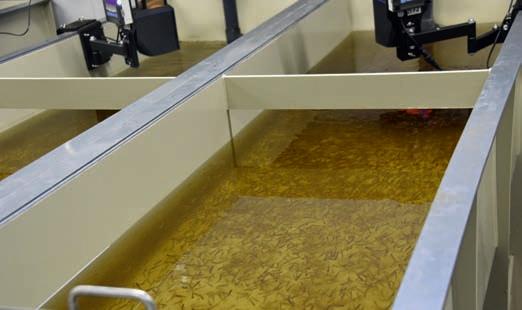
Some 18 species of fish are bred at the hatchery for restocking.
Catch data forms the basis for restocking
Anglers fishing in water bodies leased by the Polish Angling Association are obliged to report their catches to the association. The reports are prepared annually and form part of the documentation that is submitted to the Regional Management of Inland Waters along with the lease application. The data includes the species, size, weight, and location of the catch. Mr Pender estimates that fishers in his association report catches of about 80 tonnes of fish annually. He is also aware, however, that not all fishers are meticulous about their reporting, so when calculating the amount of fish that needs to be restocked, he multiplies the reported catch by three. There is a direct relation between the catch and the restocking volumes, and the two
figures must be balanced to maintain a healthy stock status. The proportion of fishers reporting their catches reliably stands at about 60 of the total membership of the association, which Mr Pender considers a relatively high share. Anglers are also subject to several restrictions which are detailed in a booklet issued by the association. These restrictions vary from one body of water to another and include spatial and temporal limitations, as well as constraints on gear types. Fishers usually keep the fish they catch, but according to Mr Pender, it is becoming more common to take a picture of the catch and then return it to the water. The association encourages this practice particularly if the fish caught are rare species such as brook trout.
The Polish Angling Association is also involved in several
conservation and educational activities. Some members are employed as guards who keep an eye on anglers to make sure they observe the rules of the water body in which they are fishing. The association covers the costs of their uniforms and the fuel they use carrying out their duties. There is also a programme of outreach activities for members
as well as for schools to promote the importance of caring for the natural environment. Moreover, there is also a regular collaboration with the Faculty of Food Technology and Fisheries at the West Pomeranian University of Technology that has resulted in several joint projects and a supply of students who serve as interns at the hatchery.
Wylegarnia Ryb (Fish Hatchery)
Osrodek Hodowlano Zarybieniowy (Fish Breeding and Stocking Center)
Okreg Polskiego Zwiazku
Wedkarskiego w Szczecinie (Polish Angling Association, Szczecin District)
ul. Spacerowa 11 72-100 Goleniów
Poland
Tel.: +48 22 620 8966
sekretariat@zgpzw.pl https://pzw.org.pl/
Director: Rafał Pender
Activity: Raising juvenile fish for restocking
Number of species: 18
Facilities: Flow-through, and recirculation aquaculture systems
42
POLAND

The logistics of buying, processing, and distributing fresh fish are challenging
Whitefish products for the EU market
The Polish fish processing industry is highly diverse comprising over 560 companies of which 240 are authorised to export to the EU. The items exported include several based on salmon, but also many made from other fish species, both marine and freshwater. Products can be smoked, marinated, salted, fresh, or frozen, and they are exported to some 100 countries. In terms of the value of processed fish production Poland ranks third in the EU (after Spain and France).
In the town of Slawno in the Polish northwest, the dynamism of the Polish sh processing sector is apparent at the company Baltimer founded at the turn of the century as a joint venture between Mr Jurand Piotrowski, a 30-year veteran of the seafood industry who people say has saltwater in his veins, and the French Fish Trading Company. In 2015 Mr Piotrowski’s son, Pawel, joined Baltimer becoming vice president and partner and he presently handles almost the entire day-to-day management. e company exploits its proximity to the main shing ports, Kołobrzeg, Darłowo, Ustka, Łeba, Władysławowo, on the Polish coast to o er its customers sh of the highest quality. is is partly thanks to the freshness of the raw material that arrives at the factory to be processed, but also because the processing facility conforms to the sanitary requirements that enable the company to export to other EU countries. e facility is also certi ed to the Marine Stewardship Council (MSC) Chain of Custody standard that provides assurance that sh sold by the company under the MSC or ASC labels does indeed come from a shery or sh farm that has been certi ed as sustainable. is focus on quality and sustainability has won the company clients on both the domestic and international markets. Fish from wild catches in marine water and in fresh water form part of the
assortment, the rest is made up of farmed sh which is obtained from the domestic market as well as from suppliers across the EU.
Yields from manual filleting cannot be matched
On a tour of the facility Jurand Piotrowski emphasises that the company specialises in producing to the client’s specifications. Most orders are for fillets, skinless or skin on, but the specification could equally be for portions, steaks, bellies, or some other cut. When the raw material arrives, it is checked and after approval is placed in a large cold store maintained at 0 degrees preparatory to being processed. The raw material is almost always fresh fish and is processed within a maximum of 18 hours of arrival, says Mr Piotrowski, though it is usually sooner than that. Today, whitefish, primarily perch and cod, is the dominant raw material at Baltimer. There was a period when the company experimented with other whitefish species but very few of them proved to be economically viable. So, the company focused on perch and cod, processing small volumes of other species like pike perch when there was a need. All the processing is done manually as that has proved to be the most efficient. At one point a machine was brought in to test it, but the yields did not match those from

to EU countries.
manual filleting. With our filleting staff we achieve as much as 45 yield, Mr Piotrowski notes, more than we could get from the machine. The plant has equipment to manufacture ice and rooms to store the semi-finished products—fillets that need to be further processed or packaged. It used to be a meat processing plant that was then adapted to process fish, so the design is not that of a conventional fish factory. The
staff at the plant are used to the factory layout as many of them have been working at Baltimer for many years. As a result, they have a lot of experience with fish and are experts at filleting. Whether fillets, portions, or steaks, the final product is typically fresh and is packaged in Styrofoam boxes on ice for shipment to wholesalers. But the company has equipment to make frozen products as well and in fact manufactures
Jurand and Pawel Piotrowski, directors of Baltimer, a company processing and exporting whitefish
EUROFISH Magazine 3 / 2024 43
POLAND

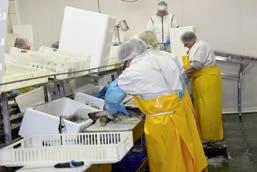
a vacuum packaged foil with skin-on perch fillets that is then frozen. This has proved very popular with customers in France and Switzerland.
Processing is also offered as a pure service
Perch has become a more important product for Baltimer since the ban on cod fishing was introduced in 2019 in the southern part of the Baltic Sea. This affected Poland and Lithuania in particular. Baltimer was dependent on cod from the
Baltic as it had not developed a supply chain for cod from other sources in the North Sea or the Norwegian Sea so when the supply of Baltic cod was cut off it had nowhere to turn. Instead, it started offering processing services on the strength of its reputation for reliability and high quality. We get the raw material from the client, process it, and send the final product to where the client specifies. The customers are often other local producers who do not have the capacity to carry out the orders they receive and therefore
Jurand Piotrowski elected to BSAC
After semi-retiring from Baltimer in 2022, Jurand Piotrowski has recently taken on the role of board member of the Polish Association of Fish Processors, the largest national organisation of fish processing companies. In this capacity he has been elected to represent Polish fish processors at the Copenhagen-based Baltic Sea Advisory Council, a body that prepares and provides advice on the management of Baltic Sea fisheries to the European Commission. The BSAC consists of organisations representing the fisheries sector, and other interest groups affected by the CFP (e.g. environmental, organisations, and sports and recreational fisheries organisations). Through his participation in this forum Mr Piotrowski reckons he will learn more about the international fish industry and market trends, while expanding his network of contacts for the benefit of the Polish processing industry.
must outsource them. Baltimer charges a fee per kilo of finished goods. It is not just local companies who avail of these services, however. Several Danish companies have also made use of them, and the cooperation has been very smooth, Mr Piotrowski reports, with both sides satisfied with the collaboration. In some cases, the client will take back the processed fish and repackage it, that is, put it into smaller boxes, label them, and ship them. In general, working with fresh fish is highly demanding with little or no margin for error. Unlike frozen products, fresh fish is highly perishable with a short shelf life. Cod from Norway, for example, has a shelf life of 12 days in which to transport it to the factory, process, package, and deliver to a logistics centre, say, in France from where it can be distributed to retailers. This means Baltimer often cannot keep the fish for longer than a day. The value of the raw material makes it imperative to use all parts of the fish. The frames that are left over from the filleting line are therefore pushed through a machine which minces the meat while discarding the bones. The mincemeat can then be used to make fish cakes, fish burgers, or breaded products. Another new product the company is considering is trout roe imported
Baltimer sp. z o.o.
Gdanska 46 76-100 Slawno
Poland
Tel.: +48 518 257 496 biuro@baltimer.pl www.baltimer.pl
Directors: Jurand Piotrowski, Pawel Piotrowski
from Turkey and canned. But, Mr Piotrowski grumbles, the project is being delayed by the local bureaucracy.
Some raw material is increasingly difficult to obtain
The increase in energy costs following the pandemic prompted Baltimer to invest in solar panels to bring down their electricity costs. Although support for this kind of investment was available from the European Maritime, Fisheries, and Aquaculture Fund, Mr Piotrowski says the procedures were so bureaucratic that he decided against applying, paying for the investment himself instead. But the lack of fish is a bigger issue than energy prices. Ten years ago the company could count on 10 tonnes of perch every two days, now it is more like a single tonne every four days, says Pawel Piotrowski. The situation is better with Atlantic cod, but there cashflow is the challenge. The supply must be paid for within a week, while Baltimer’s customers have much longer payment terms. All said and done Baltimer has adapted to the challenges of the business environment though it has not been easy. However, the ability to survive when the going gets tough is an asset that is sure to come in handy in the future too.
Activity: Primary processing of marine and freshwater whitefish
Species: Perch, cod
Products: Fresh fillets, portions, steaks, bellies
Destinations: France, Denmark, Italy
Number of employees: 35
Workers fillet farmed cod from Norway. The fish is an alternative to Baltic cod which is no longer available.
New role to assist the Polish processing sector
44
POLAND

Perch from the Szczecin lagoon now dominates processor’s assortment
Adapting to the lack of Baltic cod
For fishers and processors cod was for many years before the turn of the last century the most important fish in the Baltic Sea in terms of both its nutritional and commercial value. The situation is dramatically different today with fishing for cod banned and the catching and processing industries much reduced.
At Mieszko, a processing and trading company established in Darłowo in the northwestern part of Poland in the late 70s, the decline in cod raw material has had a signicant impact. Over the years we have switched from cod to perch which we export to Switzerland and France, says Monika Marcinkowska who co-owns the company together with her brother, Adam Hryckiewicz. Mieszko was founded by the siblings’ mother and was one of the rst privately owned processors in the area at the time. It provided sh processing services to a state-owned procurement and distribution agency that was responsible for supplying the entire country with sh. e sh, mainly cod, herring, and ounder, was obtained from shing cooperatives by the agency and then processed by companies. At the same time there was a small quota of sh that the shing cooperatives could sell freely. Mieszko would buy some of this sh and process it for export by third parties. e cod was generally processed into fresh llets and the volumes, says Ms Marcinkowska, were vast.
Decline in cod catches goes back two decades
Following those early years came a change in the political system in the late 80s and early 90s leading to accession to the EU in the noughties. This simplified many procedures, reduced bureaucracy,

and offered access to a large single market. Polish processors were highly competitive but already by the mid-00s the volumes of cod stopped growing and shortly afterwards started sliding.
Ms Marcinkowska had already started looking at alternate species and markets and had identified perch as a potential product. By the turn of the century the company Mieszko was trading perch, obtaining it from the Szczecin lagoon, processing, and exporting it to markets in Switzerland and France. Those days we could obtain all the raw material we needed, she remarks, but today we have the same problem with perch as we have with every other species in the Baltic, there is less and less fish. Our annual production volumes of perch are 30 of what they used to be. It is only available
for three months in the summer though sometimes at the end of summer there is a bumper harvest, so we freeze some of the fish. Perch is obtained from the Szczecin lagoon from where a fisher with several boats supplies the company. The fishery is managed with temporal restrictions so that there are only certain periods where the nets can be laid. The fish caught in fyke nets is the most valuable as it is alive when harvested and thus has the finest quality. Trawls were also used, but this gear is now banned.
Ms Marcinkowska attributes the decline in perch volumes to human interference in the species’ natural habitat and to changes in its biological cycle. The company has adapted to the new situation, but the change has not been easy. We were a company that was used to handling large volumes of a
single species, cod, that now had to switch to processing small quantities of other species and exporting the products to specific markets, Ms Marcinkowska states. Then the market was across Europe, now it is fewer countries that we sell to. We still process and sell cod, but it is either Atlantic cod or farmed cod from Norway.
When the raw material arrives at the processing plant it is subject to tests to ensure that the quality is suitable, and the weight is as declared. Temperature is one of the most important parameters and is monitored individually by two employees to ensure that any deviation is within the prescribed limits—if the temperature is 4 degrees or higher the fish is discarded. The fish is then weighed and sorted by size before being
Monika Marcinkowska and Adam Hryckiewicz, siblings who continue the business started by their mother some 50 years ago.
POLAND EUROFISH Magazine 3 / 2024 45

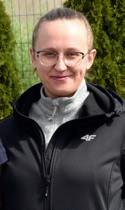
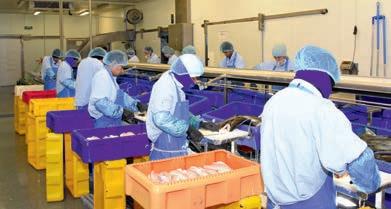
processed usually within 48 hours of arrival at the processing facility. The variation in size means that fish from different shipments are often combined to give a uniform final product. Traceability is maintained throughout so that the origins of all the fish in a final lot is contained in the system.
Carp processing for the retail sector is a new activity
Although raw material volumes have fallen the company is committed to maintaining the number of employees on its payroll. This is partly because many of the
employees have worked for the company for years and are fully trained in the company’s routines. Moreover, when there are large volumes of fish that need to be processed rapidly it is necessary to have all the employees available. To keep the staff, work must be found for them, and so Ms Marcinkowska has entered into an agreement with a carp producers’ association to process their fish. This is converted into steaks, fillets, portions, and other products that are requested. The carp products are placed in modified atmosphere or vacuum packaging to prolong the shelf life, since most carp farms are

in the south of the country hundreds of kilometres away. The fish from the carp association is mostly common carp with small volumes of other carp species as well. Annual volumes of carp processed amount to about 10 tonnes and the association takes care of all the sales and marketing. Mieszko is purely the processor in this instance—all the processing and packaging follows the association’s specifications and Mieszko will then also ship the product to a destination indicated by the association. The company is one of three that processes fish for this association, and the only one of the three that packages for retail; the other two only package in Styrofoam boxes for bulk shipments. While the volumes of carp processed are significantly higher than those of perch, the unit price for perch fillets is higher. All the processing is done by hand to get the maximum yield from the fish. Perch are relatively small fish with a fillet size of 10-20 g. Filleting can therefore only be done manually. Carp on the other hand are larger and the initial processing is done by machine, whereafter the filleting is done by hand.
Reducing costs is a priority
Like the rest of the industry Mieszko is also looking to reduce its costs which have ballooned in the last couple of years. Everything is more expensive since covid—water, energy, raw materials, labour—so we are constantly looking for ways to reduce our overheads, says Ms Marcinkowska, because the prices we charge for our products have not increased to the same extent. Even buyers in Switzerland, where we supply the catering, hotels, and restaurants sector, have become very inflexible on price since the pandemic. To reduce energy bills the company has therefore installed solar panels and is also considering shifting from conventional freezing to the use of liquid nitrogen. These and other measures have helped Mieszko adapt to the series of changes that have reshaped the Baltic Sea fish processing industry. The lessons learned and the flexibility it has shown will surely prove useful when facing challenges in the future.
Kinga Wychowalek, production manager at Mieszko
Some of the employees working on the processing line come from Latin America as Poles are unwilling to work in fish factories.
The fish is packaged in modified atmosphere or in vacuum to prolong the shelf life.
46
POLAND

Making the most of EU fundingopportunities
Fishers struggle to adapt to changes
The Wolin Fishermen’s Association was established in 2008 and today has over 110 members, including fishers, vessel owners, and supporting members, from several towns along the Szczecin Lagoon and the Baltic Sea coast.
Wolin is the name both of an island that separates the Szczecin Lagoon from the Baltic Sea and of the island’s main town. e town is located on the bank of the river Dziwna that connects the lagoon with the sea. Jacek Kowalczyk, the president of the Wolin Fishermen’s Association, says that the association is among the biggest associations of shing boat owners in Poland. Most of the vessels are 6-8 m in length, but there are also some that are up to 24 m.
Promoting fish consumption benefits consumers more than industry
The smaller vessels fish in the lagoon while the larger ones are active in the open sea. Catches in both fleets have been on the decline, but the town, under Ewa Grzybowska, its energetic mayor, has been good at attracting EU funds to promote the consumption of niche fish species. The promotion campaign included cooking and tasting sessions, public discussions with dieticians, outreach programmes in schools, and a series of e-books, podcasts, and webinars. An online quiz to test knowledge about fish was a further activity. The campaign, which terminated last year, sought to promote the consumption of fish from local catches and to increase awareness of the taste and healthfulness of fish and fish products caught and produced in the region. It aimed to change eating
habits by demonstrating that fish is simple and easy to prepare, is part of a healthy lifestyle, and benefits both the consumer and the environment. Ms Grzybowska is highly pragmatic and realises that if money is available to promote fish then fish should be promoted even if local catches are falling. The largesse benefits municipalities, young people, sports groups, associations, everyone who is related in some way to fish, she says. While there is little we can do to improve catches, promoting fish consumption is something we can do and if it prompts consumers into eating more fish even if it is not locally caught product, then we have achieved something, she feels.
A range of factors affect the fishery
Mr Kowalczyk says the increasing restrictions that fishers face is one of the reasons for the decline in catches. Each year the time we can spend fishing is reduced, there are temporal restrictions on herring and on perch, for example, and there are bans on fishing for West Baltic herring and salmon. Moreover, fishers have to contend with porpoises, seals, and cormorants. Tomasz Hamala, vice president of the association, says he used to catch 100 tonnes of herring a year, but now catches virtually nothing. The situation is exacerbated by dredging and land reclamation projects that have disturbed fish habitats, nurseries, and breeding
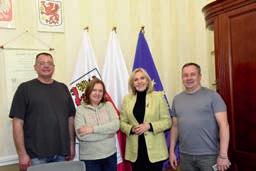
grounds, driving the fish away. Pike-perch has disappeared from the lagoon and is now protected from 15 April, whereas five years ago this would have been the peak period for pike-perch catches. A prohibition on eel fishing is also expected. And while costs of inputs and overheads have increased fish sales prices remain unchanged. Mr Hamala confesses that he earns so little from fishing he is dependent on his wife. Many fishers are therefore seeking a way out of the sector. Mr Kowalczyk says some 30 fishers have scrapped their boats already. It is becoming increasingly difficult to earn a living as a fisher, instead one must have another livelihood and then one can fish on the side. He points out that the loss of the fishery means that all the knowledge that fishers possess also vanishes as will many related industries
such as net manufacturing and repair. Small-scale fishers are bitter because they feel the way they fish is the most sustainable of all fleet segments, yet they are still subject to myriad rules and regulations while other segments that are far more environmentally destructive are not subject to the same level of restrictions.
Investments in infrastructure may give tourism a boost
Despite the grim outlook, the association with help from the municipality and with EU support has invested significantly to improve infrastructure in the area such as the port and the approach road. The idea is to create facilities that can also be used by visitors as tourism offers more prospects than fishing. Work at the port is almost complete but it has not yet been
Tomasz Hamala, Vice President, Wolin Fishermen’s Association, Joanna Zurawska-Łagoda, Department of Fisheries, Ewa Grzybowska, Mayor of Wolin, and Jacek Kowalczyk, President, Wolin Fishermen’s Association
EUROFISH Magazine 3 / 2024 47
POLAND



Waldemar Jalkowicz manages a cooperative with ten 7 m vessels and 16 fishers in
taken into use. Fishers land instead at the old landing facility close to the marina. Here a fisher unloads a substantial catch of bream from the lagoon. Currently, eel, pike-perch, bream, perch, and roach are the main species caught in the lagoon, he says. Fishers lay nets and traps in the water depending on the species targeted. By convention the nets are placed three to four hundred
meters away from each other, but their position is determined by whoever comes earliest. The most productive areas are taken first. The gear is usually placed in the water in the evening and emptied the next morning. However, in summer, when water temperatures can reach 25 degrees the nets must be emptied within two hours, or the fish start to deteriorate. The fish is
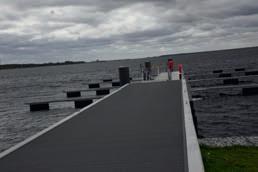
recreational vessels.
often sold to middlemen who sell it on to processors or other buyers. However, the price they offer is not very high, so fishers prefer to sell to private individuals who take smaller volumes but at a higher unit price. Landings are reported to the authorities by the fisher who files a report with information about the catch, species, weight, first buyer, price, etc. Inspectors
Wolin Fishermen’s Association’s catches by port (kg)
make random checks, so the fishers need to report transparently. The amount of money spent on monitoring and control is the same as is offered to fishers in subsidies, one aggrieved fisher states.
Despite complaints support for the EU remains strong
Some fishers feel the EU is to blame for the hardship they are facing. They recall the early days of Poland’s accession to the EU when there was plenty of fish, quotas were generous, and there was support for the industry. Things have changed since then. There is less dialogue with the sector, just restrictions and prohibitions, one claims. That said, most Polish fishers support continued membership of the bloc. They also support the war effort in Ukraine. Fishers have sent fishing nets to the front where they are used to camouflage equipment and protect the soldiers from drones.
Come rain or shine fishers are out catching all summer
At Stepnica some 25 km south of Wolin, fishers are packaging
Stepnica, some 25 km from Wolin. The fishers belong to the same producer organisation as the Wolin fishers.
EU support has been deployed to build infrastructure in Wolin such as this quay for fishing and
Port 2020202120222023 Mrzeżyno 1,078,746 631,423 395,231 500,054 Dziwnów 712,195 462,978 461,273 479,652 Władysławowo 441,705 339,613 309,429 Hel 113,870 130,312 178,070 Stepnica 38,788 176,608 216,989 170,145 Kołobrzeg 919,478 180,782 155,749 119,535 Wolin 65,346 88,359 142,608 119,345 Świnoujście-Karsibór 80,338 114,630 75,358 64,045 Nowe Warpno 37,759 58,805 67,334 45,141 Niechorze 17,185 26,952 15,276 44,184 Rewal 63,494 59,661 21,516 43,623 Świnoujście 276,975 166,336 48,640 19,009 Nexo 541,557 259,908 83,200 16,693 Międzyzdroje 119,859 125,027 4,831 5,538 Others 113,861 140,876 81,693 103,717 Total 4,065,5793,047,9192,239,6232,218,177 Department of Fisheries, Ministry of Agriculture and Rural Development 48 POLAND

freshly caught roach in Styrofoam boxes on ice for a processing company. The fish has been in storage for just three hours before it is sent on its way. The roach season will continue to the middle of April, says Waldemar Jalkowicz, who manages a cooperative with ten 7 m vessels and 16 fishers. From the middle of May the ban on fishing for pike-perch will be lifted and towards the end of July and in August we will target perch. In addition, we target other freshwater species including eel. Come November and until the end of March all fishing activity is suspended, so the fishers must catch and sell enough over the summer to see them through the winter. We ignore the weather in the summer, says Mr Jalkowicz, whether it rains or blows we go out to fish. The day’s catch amounted to about a tonne from three boats. This is considered a good haul, and a processor will willingly drive out to pick up the fish. The problem is when the catch is small because then a processor is reluctant to make the trip. The first sale price for large roach is PLN3/kilo (EUR0.7/kilo), small roach is less. In the cooperative too some fishers, usually the older generation,
would like to scrap their vessels and leave the fishery. Age, bureaucracy, and diminishing returns are the factors they cite for wanting to leave the business, but there are others who would like to continue. The fishers in the cooperative have invested in storage, a manager who handles sales, and an accountant. The advantage for buyers is that volumes in the cooperative are larger than those from a single fisher. There are several buyers in the area and the cooperative sells to the one offering the best terms for the day’s catch. We cannot make long-term contracts because the catches are unpredictable, so delivering, for example, five tonnes a week each week is just not feasible, explains Mr Jalkowicz.
The task is to catch and sell the fish quickly
The cheaper fish usually ends up in eastern Europe or in western European countries that have immigrant populations from the east, while the so-called noble fish goes typically to the west, often Switzerland. The cooperative does not process the fish; it would be a good solution, but it is too expensive,
says Mr Jalkowicz, so we concentrate on obtaining the raw material and selling it as quickly as possible. The cooperative has existed since 1993 in its current form and has been catching 200-250 tonnes a year, a figure that has remained stable. But, he clarifies, if you look at the structure of the catch, the species on which we can make money, perch, pike-perch, and eel, have declined. Today it is only perch which is caught in any quantities, pike-perch has reduced massively in recent years. He attributes this to the dredging of channels and the land reclamation as well as cormorants which eat quantities of young fish. In addition, there is more algae in the water and the salinity is increasing, so much so
that some marine fish have been spotted in the lagoon in spring. Increased salinity has an impact on spawning driving freshwater fish to spawn in other areas that are less saline. Another change has been the catches of roach. This did not used to be a target species as there was enough perch and pikeperch. The cooperative itself has so far been stable in terms of its membership, but three more vessels are due to be scrapped by 2026 leaving only seven in the cooperative. The decision to leave the sector is influenced by the age of those leaving, Mr Jalkowicz says, but other factors such as the amount of paperwork and now plans for putting cameras on board also play a role.
Wolin Fishermen’s Association
ul. Zamkowa 23A 72-510 Wolin
Tel.: +48 602 252 571 wsr@onet.eu http://iwsr.pl/
President: Jacek Kowalczyk
Vice president: Tomasz Hamala Number of members: 110
A group of fishers has concerns about the future of their industry
Ports covered: Stepnica, Wolin, Lubin, Świnoujście, Międzyzdroje, Karsibór, Przytór, Dziwnów, Niechorze, Mrzeżyno and Rewal
Vessel length: 6-24 m
Main species caught: Eel, pikeperch, bream, perch, and roach
Customers: Local processing companies
Diversification is the way forward
Trzebież, a town 30 kilometres north of Szczecin on the edge of the Szczecin Lagoon, is home to a fishing cooperative whose members fish in the Szczecin and Kamieński Lagoons and in the Dąbie Lake. The catch comprises a variety of freshwater fish species including, perch, roach, tench, eel, bream, and pike.
Part of the production is frozen, which means it can be stored and then sold gradually without the urgency that accompanies consignments of fresh sh. Like all wild sheries catches uctuate from day to
day depending on the weather, conditions at sea, and the time of the year. e middle of April signals the start of the good period to catch perch and roach. e best shing period is the second half of summer and the fall as well as
the spring, says Paweł Kuźmicki, President of the Szczecińska Group of Fish Producers. e twenty shers and their ten boats are organised into a company and the shers are also members of a producer organisation.
There is strength in numbers
The PO includes 10-12 fishers who have formed another company further along the coast of the Szczecin Lagoon, as well as several
POLAND EUROFISH Magazine 3 / 2024 49

individual fishers. The individuals that are members of the PO but do not belong to either of the companies is because they are geographically dispersed. Selling the fish they catch at Trzebież would be difficult as it is far away from their fishing grounds. The company’s function is to buy the fishers’ catch and sell it on behalf of the fishers, so that they do not have to sell their catch individually. This arrangement gives the fishers more negotiating power, a better price for their catch, and is also more suited to buyers who want access to larger volumes of fish. Before the company was formed the fishers were organised into a cooperative which performed much the same functions as the company. This was followed by an interim period, when the fishers were selling individually and which turned out to be quite burdensome, says Mr Kuźmicki. So, the fishers formed a company which is responsible for the sales and thanks to this arrangement are now selling at better prices than they were as individuals. If an individual fisher catches a 100 kilos of fish, then 10 fishers can catch a tonne of more. The company has invested in freezing and storage facilities which allows the fish to be consolidated into one large consignment even if the
individual fishers catch at slightly different times. The buyer can send a large vehicle to take all the fish in one go rather than collecting smaller loads in multiple trips.
Processors wield a lot of power
Buyers are usually processing companies and they play a key role in determining the price of the fish. They are difficult to negotiate with, according to Mr Kuźmicki, and there has never been an auction for freshwater fish which would force buyers to compete.
Most of the sales is to processors with a small proportion going as retail sales to individual customers, for example, shops. Processors put a lot of pressure on prices, says Mr Kuźmicki. The effects are mitigated if the turnover is large, but in recent years the catch has declined significantly and fishers struggle to keep their heads above water. One would think that when the resource became scarce its price would rise, but that does not seem to happen at our level, Mr Kuźmicki states, but the price the end consumer pays is high. The company gets a better unit price if a buyer declares they want a certain species of a certain size. The low prices force the company to cut its costs as far as possible to maintain its viability.
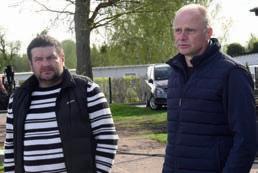
To achieve this it has invested in solar cells that generate the electricity needed to run the freezing machinery, the cold store, and the ice generating machine. Without this investment the sales price of the fish in storage would have had to be increased each month to take into account the storage costs. Not all the fish is frozen—only certain species as well as those considered of low value. But freezing capacity works as a kind of insurance for those occasions when there is a lot of fish. Freezing allows the fish to be stored until the price on the market is favourable, while fresh fish needs to be sold within two or three days irrespective of the price on the market.
Szczecińska Group of Fish Producers catches by port (kg)
Catches fall for a variety of reasons
There are several anthropogenic factors that contribute to the decline in catch volumes, says Marcin Żelechowicz, another of the company’s fishers. Among them were construction projects in the lagoon that called for dredging and waterworks. Moreover, in 2022, some 360 tonnes of fish were killed in the Oder in July and August. An analysis conducted by the EU concluded that the mass mortality event was due to a toxic algal species that proliferated due to the high salinity of the water caused partly by industrial wastewater being released into the river. Another factor is the presence of vast numbers of cormorants. Mr Żelechowicz believes that these predators eat more fish than the total catch of the lagoon’s fishers and that the problem is just getting bigger as the species is protected and nothing is being done to regulate it. Although volumes are declining, the Trzebież fishers’ catch is of particularly high quality thanks to the gear they use. They work predominantly with stationary traps which are set out in the spring and removed in the fall. The fishers visit the traps each day to remove any fish that may have
Port 2020202120222023 Kamień Pomorski 37,091 34,589 36,087 28,417 Lubin 126,286 73,561 109,134 102,141 Nowe Warpno 38,808 62,049 70,628 48,497 Stepnica 30,421 87,324 106,951 77,914 Szczecin-Dąbie 38,193 114,357 99,100 119,209 Szczecin-Stołczyn 62,583 129,180 85,937 88,388 Świnoujście-Przytór 46,216 23,154 11,906 38,363 Trzebież 312,792 571,546 640,754 434,691 Total 692,3881,095,7601,160,497 937,620
Department of Fisheries, Ministry of Agriculture and Rural Development
Paweł Kuźmicki (right), President, Szczecińska Group of Fish Producers, and Marcin Żelechowicz, Member of the Board
50 POLAND

been caught. The high quality of the catch is because the fish are alive when they are taken from the trap. With gill nets or trammel nets, on the other hand, the fish usually die before they are removed from the net. Climate change also affects the fish, for example, migration patterns are becoming more unpredictable, says Mr Kuźmicki, and some species, for example whitefish, have disappeared altogether, while others such as pikeperch vanished for several years, but has since reappeared. This unpredictability makes it difficult to plan and is also a factor in some fishers deciding to scrap their vessels and leave the profession. In the producers’ organisation there are 10-12 boats that are earmarked for scrapping. Other reasons behind the scrapping include the decreasing profitability of the activity, personal reasons, and, of course, age (though a few young fishermen are also pulling out).
Earning a reasonable income from fishing is likely to be the privilege of a few
Another development Mr Kuźmicki sees among his members is the

realisation among many of them that fishing is no longer the breadwinner it used to be. For many it will not be the sole source of income as it was in the past. Perhaps 20 will be able to survive on fishing alone; the others will have to diversify their incomes. Being a successful fisher depends on the location of the gear, the type of gear, experience, and luck. Good locations are highly prized. Mr Kuźmicki, who inherited his from his grandfather who used to fish in the 1950s, says the trap must be placed right

in the path of the fish. Placing it to the left or the right can make a difference one’s success, he claims. Dredges, changes to the seabed or to currents can make a fish follow a different path and also affect the catch. If a fisher has a good location, it would be unusual for him to leave the fishery. But there is not always a younger generation waiting to take over. In Mr Kuźmicki’s case, his children are at university and are likely to stay in the cities where they study.
Mr Żelechowicz, also a third-generation fisher, has a son who may follow in his father’s footsteps, but it is not certain. Women are generally not involved in the actual fishing because the
work of setting the traps and then harvesting them is highly physically demanding.
But the future of this kind of fishing is likely to be determined by diversification and the availability of alternate sources of income. Mr Kuźmicki is concerned that income from fishing alone will not cover the taxes, maintenance, and social insurance that a fisher is expected to pay. He used to employ two people to help on the boat, but now can only afford one. In addition, the processors have too much power regarding the price they will pay, but their costs have also increased, Mr Kuźmicki acknowledges.
Szczecińska Group of Fish Producers
Ul. Portowa 1 72-020 Trzebież
Tel.: +48 516 183 033 biuro@sgpr.pl www.sgpr.pl
President: Paweł Kuźmicki
Activity: Small scale fishing with traps in Szczecin Lagoon, Kamieński Lagoon, and Dąbie Lake
Species: Perch, roach, tench, eel, bream, and pike
No of fishers: 20
Volumes: 1,000 tonnes
Customers: Local processors
The company has 20 fishers and 10 boats active mainly in the Szczecin Lagoon.
POLAND EUROFISH Magazine 3 / 2024 51
The fishers use traps (fyke nets) that are supported by poles (shown). Setting the nets is thus extremely physically demanding as the poles must be sunk into the seabed. This is done once a year in spring and in the fall the gear is removed again.

The aquaculture sector in Georgia
Potential exists despite the challenges
Aquaculture in Georgia is focused on trout, carp, sturgeon, and catfish. Companies are trying new species and novel ways of adding value to their production to generate more from less. Issues remain, however, but there is an interest among stakeholders in resolving them to allow the sector to reach its full potential.
Analysing the possibility of developing a national aquaculture sector, the Georgian government concluded that Georgia with its abundant water resources had ample potential to develop fish and shellfish farming. According to the FAO, the Black Sea, rivers, reservoirs, and lakes all contribute to the country’s water resources. These include 5,000 km of rivers (the 90 most important) 17,000 ha of lakes, 23,000 ha of reservoirs, and 1,300 km of irrigation canals. In addition, the Georgian coastline is over 300 km long. The study recommended starting with the creation of a legal framework to ensure a stable base for this new sector. Accordingly, the Law on Aquaculture was drafted, examined by international experts from
the GFCM (General Fisheries Commission for the Mediterranean), and finally enacted in July 2020.
Creation of a legislative framework
Among other features, the law defines the terms used in aquaculture for the different technologies and methodologies applied. In addition, it addresses a wide range of topics, which together should create an environment that is favourable to the continued growth of aquaculture. Chapter IV of the law addresses mariculture, defined as “aquaculture in marine waters”, several provisions are related to the state management of aquaculture (Art. 4); mariculture (Art. 11); aquaculture permits (Art. 12);
Fish House combines an eatery with a fish farm
The Shida Kartli region in Gori is an area with many fish farms mostly cultivating trout and sturgeon. Among them is a farm that has diversified its activities and has established a restaurant, Fish House. The idea of connecting a restaurant to a fish farm was born in 2019. Despite the challenges the management faced—the pandemic, supply shortages, price hikes—the fish farm and restaurant attracted the attention of a lot of customers, tourists as well as locals. The main selling point of the restaurant was the different kinds of freshly slaughtered fish it could offer patrons which differed markedly in taste from frozen fish.
Many guests visit the restaurant for a meal of sturgeon grilled in a traditional Georgian clay oven where the different flavours from the oven blend with those of the fresh fish. The combination of restaurant and fish farm allows the guests to eat surrounded by lakes and pools, and with the relaxing sounds of water in their ears.
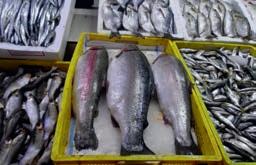
Aquaculture Inter-Agency Council (Art. 5); the plan for managing zones allocated for aquaculture (Art. 13); and transitional provisions (Art. 40). The law on aquaculture
gives the National Environmental Agency (NEA) the responsibility to coordinate the process of awarding permits to carry out aquaculture operations, as also mentioned in

Thanks to its connection to a fish farm, the restaurant Fish House can serve its guests fish that is fresher than anything else they can get.
52 GEORGIA
A fish market in Batumi has a range of wild and farmed fish on display. In the foreground is trout raised in the Black Sea.
Fresher fish does not exist!

Farmed fish production in Georgia (tonnes)
The discrepancy between the totals and the sum in some cases can be explained by using rounded data.
Salmonidae - Rainbow trout, river trout, lake trout, Kizhuch, Atlantic salmon, European cisco, peled.
Cyprinidae - Common carp, mirror carp, grass carp, silver carp, bighead carp, Scraper, barbel, common barbel, Danube bleak, Vimba vimba, crucian carp.
Sturgeon - Russian sturgeon, Siberian sturgeon, Sterlet.
Siluridae - Wels catfish, African sharptooth catfish.
Other - Pike, Clupea, European perch, Caucasian goby.
National Statistics Office of Georgia
the draft aquaculture strategy. To ensure the sustainable development of the sector, the Georgian government appealed to international partners to help the country solve several important challenges. As a result, internationally funded projects were implemented in Georgia.
Value chain analysis for fresh water aquaculture suggests potential for growth
The project Fresh Water Aquaculture Value Chain Analysis in Georgia, funded by the European Union was executed in 2022. (https://capacity4dev.europa.eu/ projects/value-chain-analysisfor-development-vca4d/info/235georgia-freshwater-aquaculture).
The VCA4D study consisted of four analyses: 1) functional, 2) economic, 3) social, and 4) environmental. The analysis is based on multiple information sources, including primary and secondary data. The purpose of a value chain analysis is to provide
decision-makers with evidencebased information that indicates whether the value chain fosters inclusive growth and whether it is socially and environmentally sustainable. The analysis suggested that there was potential for growth in the aquaculture sector as only 30-40 of the potential of ponds and basins was being utilised. Trout, carp, catfish, and sturgeon are the main species produced.
Activities conducted in the framework of the project Support to Environmental Protection and Fight against Climate Change in Georgia (ENI/2022/433-066) included the promotion of aquaculture development in Georgia. Under the project, areas in the Black Sea were identified for the development of marine aquaculture in Georgia, a completely new direction for Georgian aquaculture. The zones allocated for aquaculture were approved by a resolution adopted by the Georgian government, and today local and foreign investors have the opportunity to conduct farming activities in the designated
aquaculture zones. Currently, under the same project, aquaculture management areas (AMA) are being designated for inland aquaculture, which is also a new direction for the development of the aquaculture industry in Georgia.
Strategy for the sustainable development of aquaculture in Georgia
The draft strategy for the sustainable development of aquaculture in Georgia was prepared by the Georgian Aquaculture Task Force comprising MEPA (Ministry of Environmental Protection and Agriculture), FAO, and supported by the European Union and FAO under the EU ENPARD Programme. The strategy was released in February 2023 and is essential to set the overall vision and key priorities for Georgia. The objective of the strategy was to draw the roadmap for the development of aquaculture in Georgia (freshwater and marine water) and put forward four strategic objectives:
– Improve the legal framework (government);
– Promote the growth and reinforcement of the aquaculture sector (production);
– Support development of trade and marketing for aquaculture products (market and aquafood);
– Achieve social acceptability (social aspects).
In 2023, a public hearing in the form of a workshop Presentation of national aquaculture development strategy of Georgia was organised with the participation of all stakeholders. Following the workshop the strategy is now scheduled to be adopted.
Georgian aquaculture enjoys support from the GFCM
GFCM, which is involved in the planning and implementation of all the measures described above, provides active support for the sustainable development of Georgian aquaculture.
Eurofish Magazine 3 / 2024 53
GEORGIA
2017 2018 2019 2020 2021 2022 Fish, total 2042 2381 2465 2072 2861 2792 Of which: Salmonidae 1165 1476 1340 1155 1447 1347 Of which: Rainbow trout 1145 1463 1322 1133 1426 1317 Cyprinidae 786 817 1013 838 1265 1233
which: Common carp and mirror carp 328 363 480 360 555 572 Grass carp 118 118 135 114 174 233 Silver carp and bighead carp 336 332 396 360 514 411 Sturgeon 76 75 97 60 121 179 Siluridae 14 13 14 18 28 32 Other 0.4 0.9 0.6 0.5 0.4 0.3
Of

In addition, GFCM plans to implement several projects that will help strengthen governmental and non-governmental organisations promoting the sustainable development of aquaculture in the country, while MEPA continues to actively cooperate with all stakeholders in the field of aquaculture.
While trout, carp, sturgeon, and catfish are the main species farmed in Georgia, some companies are also producing more exotic fish. Guriafish, for example, is the first Georgian company to produce Atlantic salmon. The aquaculture expert responsible for the production, Revaz Nikoleishvili, says it is about innovation. With modern technologies, we produce salmon in reservoirs filled with Black Sea water creating the best environment for growing healthy fish. The company’s story began with an idea— that Georgia should be included in the list of leading Norwegian salmon-producing countries. The Curia region, with its geographical location, Black Sea shores and towering mountains, is one of the most attractive areas in terms of aquaculture development.
Since Atlantic salmon has never been produced in Georgia or even in the region, this project will make a significant contribution to the development of this sector. At the farm, tanks are filled from the river Bzhuzhi. Ultraviolet is used to eliminate bacteria and parasites. The water is then cooled and filtered before being supplied to raceways. It is important that we maintain a continuous supply of treated river water to the raceways, says Mr Nikoleishvili. The water is completely renewed once an hour and does not recirculate, which creates a very clean environment for fish. In addition, water temperature and oxygen saturation are continuously measured with sensors and in case of need the water is enriched with oxygen.
Atlantic salmon grown in the Black Sea
In August 2019, for the first time, the hatchery received eggs of Atlantic salmon and of three species of trout. The hatchery has tanks of different sizes, and the transfer of salmon larvae takes place in several stages, according to their weight. At the hatchery,
The Georgian Fish Farmer’s Association
The voice of the aquaculture sector
the fish grow for six months, until the individual weighs 50-60 grams. Thereafter, the fingerlings continue the growing process on a Black Sea farm. After the successful implementation of the hatchery project, the Guriafish team started building a farm on the Black Sea coast, in the village of Tskaltsminda, Guria District. This location was selected to grow Atlantic salmon in the Black Sea. There are several concrete reservoirs of different sizes on the Black Sea farm. Sea water is collected 500 meters from the coast, from a depth of 40 m and delivered to the reservoirs through pipes. The water supply process is continuous; as a result, the seawater in the tanks is completely renewed once an hour. We monitor water temperature, salt content, and oxygen saturation using sensors, says Mr Nikoleishvili. The used water is cleaned and flows back into the sea, 250 meters from the beach. The fish from the hatchery are distributed in the relevant sized tanks and are moved to larger tanks as they grow. They are maintained on the Black Sea farm altogether for 1.5-2 years reaching a final weight of
2 to 5 kg. Our farm operates in a completely innovative way, Mr Nikoleishvili explains. The system is open, at the same time the fish is grown in isolation, in tanks filled with seawater. The used water returned to the sea filtered and purified. In addition, we use a premium feed produced by the Danish company, Aller Aqua. As a result, we produce our fish with minimal impact on the environment. The novelty of the project has even unlocked support from the state in the form of a preferential agricultural loan worth GEL1.5 m (EUR532,000).
As some of these innovative companies show Georgian aquaculture is gradually fulfilling its potential, but much remains to be done to relieve structural bottlenecks including a lack of experts in critical fields such as fish pathology. With support from the EU and international bodies, however, these issues can be addressed over time fostering the further development of the sector.
Nino Chobaniani Georgian Fish Farmers Association ninoch62@mail.ru
The Georgian Fish Farmer’s Association (GFFA) was founded in 2011 by fish farmers and specialists in the field. GFFA unites more than 200 farms covering all the Georgian regions, feed-producing companies, and two cooperatives. The association works closely with the international organization Eurofish and the two regional fisheries management organisations, GFCM and CACFish. The association participates in workshops and conferences and disseminates the knowledge gathered at these events to its members. In 2023, an International Council of Experts was created in the association, with the help of which many interesting and innovative projects in the field of aquaculture will be implemented. The role of the association is important to the growth of aquaculture because it is well equipped to deal with local aquaculture problems. GFFA has access to local knowledge and resources, and it is often better at understanding what local people and farmers need, and what they care about. GFFA supports and advises communities and helps ensure that development is done in a way that benefits society, the economy, and the environment. The association also helps with technical issues subject to their compliance with the rules set by the government. For example, recently the GFFA offered the farmers support to comply with rules related to the delivery of aquaculture permits. It also works to support projects that help farmers make good use of resources, and it plays a role in ensuring that development is fair and open to everyone. Despite the joint efforts of government agencies and the GFFA, Georgia still faces many problems. The most important are the shortage of fish veterinarians, a lack of aquaculture specialists, and the low level of education in the sector. With the help of the European Union and international organisations, however, Georgia hopes to overcome these challenges and gradually achieve the sustainable development of aquaculture.
54 GEORGIA
The
rising tide of macroalgae cultivation in the EU
Macroalgae aquaculture needs to be expanded
Many macroalgae (seaweed) and some of their constituent parts are edible. They are used as food and raw material for numerous products. Increasing demand is predominantly met by aquaculture. Around 35.1 million tonnes were produced worldwide in 2020, worth USD 16.6 billion. Now the EU has also recognised the potential of algae and wants to push forward production. The fact that algae are able to bind enormous amounts of CO 2 contributes to climate protection.
There is evidence that humans were already consuming macroalgae 14,000 years ago, particularly in far eastern countries such as China, Vietnam, Thailand and Japan. Algae were also on the menu on some coasts in Europe, albeit to a modest extent.
For example, the consumption of sea lettuce (Ulva lactuca) was widespread. In Italy, people used to enjoy Mauru seaweed (Chondracanthus teedei) seasoned with salt, pepper and lemon juice. On the Irish coast, algae is said to have once even been used as chewing
tobacco. Back then, for understandable reasons, our ancestors could only use natural algae stocks, which in some places grew as real macroalgae forests. The area of these important maritime habitats is still considerable. Estimates of the area of global macroalgal
biomes, dominated primarily by red algae, range from 6 to 12 million sq. km. Their extent is limited primarily by the sufficient availability of light on the seabed.
Today, however, only some of the macroalgae we use come from
THE WORLD OF AQUACULTURE


.…the summer is here!
profifeed BeltFeeder/PRO
For years, the most popular fish feeder in fish farming and aquaculture worldwide.
The FIAP profifeed BeltFeeder and the newly developed profifeed BeltFeeder PRO, are the most popular fish feeder used in fish farming and aquaculture worldwide for years. We offer the profifeed BeltFeeder and the profifeed BeltFeeder PRO in two sizes (capacity 3 kg and 5 kg) and with three different mechanical clockwork running times (4 hours, 12 hours and 24 hours).
- Suitable for feeding fish fry and fingerlings
- Excellent weather resistance
- 2 years warranty (excluding wearing parts)
- Professional QUALITY from FIAP
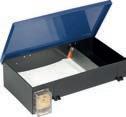









[ AQUACULTURE ]
... made by professionals for professionals!
wild stocks, as the demand is predominantly met by aquaculture. Based on the growth rates of the last few years, annual production is now likely to be around 40 million tonnes. The main producers are countries in South-east Asia, which contribute around 98 of the total production. In comparison, European algae production plays only a very small role that can hardly be represented in percentage terms. In addition, almost all of the algae produced in Europe currently come from natural sources. Although the level of theoretical knowledge about aquaculture in Europe is very high, there is a huge lack of implementation in practice. Algae aquaculture, long neglected, is still in its infancy, so to speak. That should now change if the EU Commission has its way. Macroalgae have become the focus of political attention, not least because of their ability to bind atmospheric carbon. As an effective tool for climate protection, macroalgae aquaculture positions itself perfectly in line with the EU’s Green Deal.
Neither animal nor plant
The term ‘algae’ is a collective name for living organisms with
a true cell nucleus (eukaryotes) that live mainly in water and carry out photosynthesis. They are usually divided into microalgae and macroalgae based on their size. Microalgae are individual cells or cell chains that mostly float freely in the water as phytoplankton and are only visible under a microscope. Macroalgae, on the other hand, can be seen with the naked eye. According to their colour, they are usually divided into green (Chlorophyta), brown (Phaeophyceae) and red algae (Rhodophyta). Algae are neither animals nor plants, but form a separate group of plant-like organisms. However, not every ‘plant’ in water is an alga. Seagrass, for example, which locally forms extensive meadow-like areas on sandy seabeds, is a flowering plant.
Large algae or macroalgae play an extremely important role in coastal marine ecosystems as a food source and providing shelter and habitat for a variety of fish and invertebrates. Added to this is their economic importance for the food industry. Around twenty species of macroalgae are currently used commercially on a regular basis, either directly as food or indirectly as a source
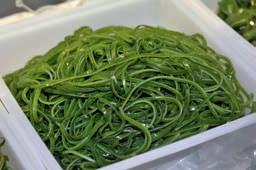
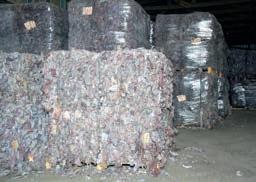
of protein and fibre as well as a gelling and thickening agent for industrial purposes. In the past, macroalgae were considered poor man’s food or were used as cold medicine, but today they have become a trendy product.
What makes macroalgae so popular, in addition to the many healthy ingredients, is their relative undemanding nature and enormous productivity. They grow almost anywhere where the light reaches deep enough into the water and they can cling to the seabed. Under good conditions, marine brown algae, especially species of the genus Laminaria, can reach lengths of up to 50 m or more and form veritable kelp forests, such as on the rocky coasts of Canada, Argentina, Africa, and Australia. The seaweed forests are not quite as lush off the European Atlantic coasts, but can grow into considerable bush landscapes wherever there is a sufficiently hard substrate available for settlement. Recently, humans have increasingly influenced the development of algae populations. Nutrient discharges from agriculture and industry (eutrophication effect) have noticeably
changed the species spectrum and the amount of algae in many coastal areas.
Food and versatile raw material
The use of macroalgae for nutritional purposes is actually a matter of common sense, because they are actually a maritime superfood, a plant-based alternative to many conventional foods. Some species contain more fibre and magnesium than kale and more vitamins and minerals than most land plants. Algae are a sustainable source of protein that also contain antioxidants, omega-3 and 6 fatty acids and plenty of natural iodine as well as important trace elements such as zinc, iron, selenium, potassium and calcium. Their specific taste ranges from neutral to grassy to nutty. Wakame and sea lettuce taste slightly salty, while kelp varies from slightly sweet to fishy and spicy. Algae are particularly recommended for vegans as some species contain the vital vitamin B12, which is otherwise almost only found in animal products. Due to their pronounced umami taste and the content of fatty acids
Kombu seaweed (Laminaria spp.) cut into strips can be used in a variety of ways, for example for making miso soup or in salads.
[ AQUACULTURE ] 56
In Chile, the macroalga Gigartina radula that washes up on beaches is collected and dried and sold to natural cosmetics manufacturers in Europe.
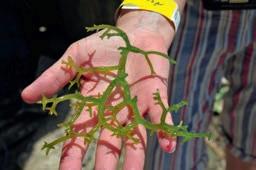

and trace elements, algae and algae extracts are also suitable as healthy flavour enhancers in meat and fish substitute products. Even the pharmaceutical industry is interested in some of the active ingredients in algae because they could potentially help with cancer, allergies, and diabetes.
Some of the extracted ingredients have already been proven to have antioxidant and anti-inflammatory effects, which develop their positive effects even in small doses. But it doesn’t always have to be algae-based dietary supplements, because it is enough to mix a few seaweed strips (sea spaghetti) into regular pasta or salads or to enrich vegetable dishes, soups and sauces with a few algae flakes to achieve the desired effect. The possible applications for macroalgae are extremely diverse and are far from being exhausted in Europe. Although many people are now familiar with kombu used in miso soups and occasionally eat seaweed in a salad or mix it into smoothies, it is a far cry from healthy crisps made from dried algae, for example, which are very popular in Asia. Nevertheless, interest in algae is growing and the range on offer in stores is expanding. Organic
seaweed-based seasonings are becoming more popular, breweries are producing algae beer from sugary seaweed (sweet kombu) and daring chefs are using dulse, red algae with a smoky aroma, as a bacon substitute.
The EU spends a lot of money on research
However, new ideas from researchers in algae reach much further. As part of the European project iCULTURE, which is funded by Horizon Europe with six million euros over a period of four years, 17 research partners from ten countries want to use macroalgae as a sustainable resource for the production of bioactive substances. To do this, they are developing special fermentation processes to convert the polysaccharides contained in seaweed, such as alginic acid, carrageenan or agar-agar, into bioactive ingredients, such as antimicrobial peptides. Some of these tiny protein building blocks are known to inhibit or even kill micro-organisms. This would perhaps give us the chance to use the peptides against pathogens, for example as a livestock feed additive or as an antibiotic alternative.
But food technologists and other scientists see even more opportunities to use algae more efficiently. For example, they could be used to produce polymeric bioplastics that are 100 biodegradable. As organic fertilizers, algae promote the growth of crops without polluting the soil. In addition, various biofuels such as bioethanol, biodiesel and biogas can be produced from algae. Given the health and ecological benefits of algae, it is easy to lose sight of the fact that they can also pose certain risks. For example, some types of algae have extremely high iodine contents between 5 and 11,000 mg/kg dry weight. Although there are no official recommendations or maximum daily iodine intake (RDI), it is generally accepted that the daily dose should not exceed 500 µg. Contamination with heavy metals such as lead and cadmium as well as exposure to inorganic arsenic or increased radioactivity can also be dangerous. That is why algae from known suspected areas must be checked particularly carefully before consumption.
Effective contribution to climate protection
The commercial cultivation of algae in aquaculture began only
a few decades ago. Production varies depending on the type of algae, location, and environmental conditions (light, nutrients), hydrodynamic situation (waves, tides, currents) and possible disturbances (diseases, herbivores). The net primary production per unit area of many macroalgal populations is among the highest of all habitats and can compete with that of tropical rainforests. Of the approximately 12,000 species of algae known to date, only a tiny fraction is used commercially. The FAO database for fisheries and aquaculture lists 47 species that are more or less regularly produced in aquaculture. Of these, only 12 species (mainly representatives of the genera Eucheuma, Laminaria, Undaria, Gracilaria, Pyropia and Porphyra) accounted for more than 95 of global algae production in terms of both volume and value in 2020.
Due to the many positive factors, it is obvious that interest in producing and commercially using algae is growing in other parts of the world outside of Asia. As part of its Green Deal, the EU Commission has launched an algae initiative to promote the development of a European algae industry. Algae cultures
Euchema algae are relatively easy to cultivate. Fragments of large algae are placed in suitable locations in the sea and sprout quickly
[ AQUACULTURE ] EUROFISHMagazine 3/202457
Before further industrial processing to extract the ingredients, the algae are dried in the sun, causing them to fade and lose their green colour.

are intended to accelerate the transition to a green, circular and carbon-neutral EU. The stated goals are as ambitious as they are optimistic, because there are currently hardly more than 80 companies in the EU countries that are involved in seaweed aquaculture. However, the EU Commission estimates that member states could allocate half a million square kilometres of sea surface for seaweed cultivation, which is the equivalent of around 70 million football fields. If this actually succeeds, perhaps even part of the annual European imports of algae-based products worth almost 600 million euros could be replaced. However, the financial support for algae production is not only aimed at algae as a healthy superfood or meat substitute, cosmetic products, natural fertilizers or biofuels. Algae aquaculture is increasingly in demand precisely because of its ability to absorb CO2. They are able to bond up to three times more CO2 than land plants. Cultivating them would help halve greenhouse gas emissions of the EU countries by 2030.
Improving the legal framework
Another advantage is that algae can be produced organically. However, the EU would not be the EU if the limits of what is permitted and prohibited were not defined by a meticulous set of bureaucratic rules. The EU Organic Regulation 2018/848 defines the site requirements, prescribes environmental assessments and requires algae producers to develop sustainability plans. Above all, it concerns a “balanced approach between economic use and the protection of biodiversity”. The EU report Blue Economy 2023 confirms that algae are a key to this new approach because they combine high benefits with low costs. Algae are a largely untapped resource with a limited carbon and environmental footprint. That is why the use of algae and algae-based products is being supported and financially subsidised as part of the EU algae initiative.
A lot of things still seem to be quite unstructured and inconsistent
across Europe, with different laws and regulations applying in almost every member state. Even the list of algae species that could be produced in the future needs to be revised and standardized. For example, of the 700 species of algae found in Brittany, only 40 species are approved for human consumption. Experts estimate that around 150 species of algae are served and eaten on European coasts. However, only a fifth of these are officially approved as ‘novel food’ according to Regulation (EU) No. 2015/2283. A revision seems to be urgently needed here. The Brussels authorities have identified a total of 23 areas of action that need to be addressed in order to advance the development of the economic framework and the acceptance of algae and algae products in Europe.
Progress can be seen in some areas. The European Commission has funded over 100 research and innovation projects with around 220 million euros. However, macroalgae were underrepresented as most funding projects focused on microalgae. This is currently changing, as shown by the Nordic Seafarm initiative in Sweden, which emerged from a scientific research project. With EU funding, methods are being developed there for large-scale production of sea lettuce Ulva lactuca out at sea. This macroalga is also suitable for gastronomic purposes, as studied and tested in the EU initiative Phycogastronomy (derived from the ancient Greek term ‘phýkos’ for algae).
Preserving resources, increasing production
Algae represent an enormous bioresource that at present is hardly being utilized. Of the more
than 100 megatonnes of algae that grow off the coasts of Europe every year (the largest biomass in Europe!), less than 0.25 per cent is currently utilized. In the future, this potential should be better exploited through sustainable, largely waste-free value chains in order to meet the ever-growing demand from the marine, animal feed, food and pharmaceutical industries. It is important to remember that the marine plants not only serve human commercial purposes, but also have an enormous impact on maritime ecosystems and biodiversity in the seas. It is for this reason the topic of protection of biodiversity and use of bioresources is also taken into account in the EU algae initiative. The EU-funded LINKFISH project (Investigating the link between sub-littoral algae habitats and fish communities in the Mediterranean Sea) investigated the structure of food webs in algal populations in shallow and deep water areas of the Mediterranean. The focus was on the importance of algae for fish production off Mallorca and Menorca at different times of the year.
Interest in algae is also growing in Europe. If aquaculture and the algae industry are to grow, we need a clear legal framework, fair competition rules and more administrative support for this still young industry. The conditions for this are very favourable, because unlike fish and shrimp farming, algae production is less complicated and much cheaper. Quick action is necessary because the sea is becoming increasingly crowded off the coast. Wind farms, shipping traffic, restricted military areas, fishing and tourism are making demands and taking up space. These are challenges that can only be solved politically. Manfred Klinkhardt
In Asia, seaweed is not only eaten as a sushi wrapping, but also as a vegetable, sea salad, and in healthy crisps and other snacks.
[ AQUACULTURE ] 58
Ukraine’s seafood business: Impacts of Russia’s war against Ukraine
Living on a powder keg
Odessa Sturgeon Breeding Complex LLC is located in the city of Vylkove in the Danube Delta, 220 kilometers from Odessa, on the border with Romania. The company specialises in the production of sturgeons, cyprinids, and other freshwater fish and their juveniles, fertilised sturgeon roe, and black caviar. Eurofish spoke to Viktor Katrechko, the company’s CEO, and Julia Sumenkova, Chief technologist.
This is the seventh in a series of articles in Eurofish Magazine dedicated to seafood businesses in Ukraine and how they work and survive during the war.
In 2006, explains Ms Sumenkova, three enthusiasts acquired a former Soviet fish farming facility, which had been abandoned and its equipment removed, as well as 720 ha of the surrounding land. A lot had to be done: renovations included the repair of the pump station to secure the water supply, pond base refurbishment, and the preparation of dams to ensure the farm functioned properly.
Sturgeons in focus
e investors decided on sturgeons as the core species, and applied for a permit to catch wild sh in the Danube—such permits are given in exchange for an undertaking to restock the river with sturgeon juveniles. In this way, the company got its broodstock. Today, the farm grows Siberian (Acipenser baerii), Russian (Acipenser gueldenstaedtii), sterlet (Acipenser ruthenus), beluga (Huso huso), starry (Acipenser stellatus) sturgeons and their hybrids, as well as cyprinids, herbivores, and predator freshwater species native to the northern Black Sea and the Danube Delta.
All the sh are grown in conditions as close to natural as possible in the Danube River with a natural food supply. By raising o spring from pure lines of
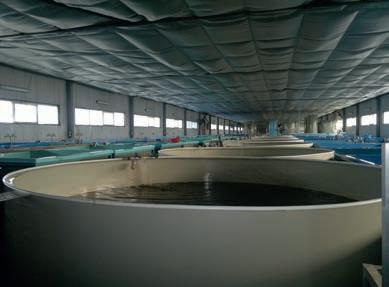
wild sturgeons, the company has achieved rapid growth rates and the sh show immunity to various diseases. Products from the sh are distinguished by a unique, natural taste, without any negative aftertaste.
Multiple uses for roe
To better control the growth of juvenile sturgeons, the owners decided to establish a hatchery
with a recirculation unit to grow the fry. is unit was built in Karnaliivka village, 77 km from Odessa. Fertilised roe is brought here from Vylkove, hatched, and the fry sent back to Vylkove for grow-out to commercial size. e sh are sorted, and the strongest ones are selected for the broodstock. Part of the roe extracted from these sh is processed into caviar for human consumption, and another part
is used for fertilised roe production, which amounts to 100 kilos a year: half of it is used by the company’s own hatchery or sold to other farmers in Ukraine, and the other half is exported to Moldova, Taiwan, Viet Nam, the UAE, and the US. e company also sells larvae, fry, and juveniles of sturgeons and other sh, including common, bighead, and grass carps, as well as pike. About 2.5 thousand sturgeon juveniles a
EUROFISH Magazine 3 / 2024 59 UKRAINE
The hatchery in Karnaliivka village, where sturgeon eggs are hatched and the larvae grown to juveniles before being transported to Vylkove for grow-out.

year are used to restock the Danube Delta.
Besides maintaining the broodstock, which is used solely for roe production, the company produces about 50 tonnes of sturgeons and 200 tonnes of cyprinids and other sh for human consumption on the domestic market. e sh are sold live through third parties all over Ukraine. Vylkove accommodates a processing unit for black caviar; current volumes reach one tonne annually and the plan is to produce three to four tonnes in the near future. e company also facilitates eco-tourism and leisure shing in the Danube Delta, 10 kilometers from Vylkove.
The war arrives with a suitcase of problems
Nobody wanted to believe that the war would erupt. And when it did, it was a shock, which paralysed all business activities for some time. However, the farming season was starting, and work at the company had to proceed. We could hear the shelling of Snake Island, it was scary, but we kept working, says Ms Sumenkova.
e war brought a number of problems—some universal and others speci c to the country’s businesses. Firms were most a ected in terms of human resources, logistics, and product distribution. Odessa Sturgeon Breeding Complex employs
exports overland through Moldova. is signi cantly increases the delivery time not only because of the distance, but also due to complex transport conditions and bureaucratic procedures. Fertilised roe is a perishable product so the company strives to limit the delivery time to 24-48 hours, despite the risks and uncertainty involved in commercial transportation.
Partial loss of the domestic market is another result of the war. Most customers for cyprinid juveniles were located in the south-east of the country, one of the centres of wartime destruction. Most of them do not exist any longer, and logistics to the central and western parts of the country have become much too expensive, therefore sales of juveniles are stagnating.
Can a war teach anyone anything?
55-60 people working full-time. Within 25 months of the war, sta turnover fell by half and the workforce challenges still continue.
Another problem relates to logistics. In the case of fertilised roe, it is quite severe: such roe is categorised as a “live sh” product, and due to EU law, non-EU countries cannot supply to the Union without government-level approval, which Ukraine does not have. is also applies to transit. Despite being close to the Romanian border, the company could not route exports through Romania but would use Kyiv or Odessa airports instead. But since ights from Ukraine for any civilian purpose is no longer possible, the company has had to re-route
Euro sh asks each of the interviewed Ukrainian companies this question, and the answer in all cases has been a resounding “yes.” e war has placed immeasurable burdens on Ukrainian seafood companies and their workers but resilience and imagination in defending and rebuilding operations has been the consistent response. “War is a disaster and life is the highest value,” says Mr Katrechko, “we live on a powder keg. We do not know what will happen tomorrow, we can make plans, but tomorrow a missile could y in…and what then? We keep going to do what we can to support our business and, overall, our country to the best of our ability.”
In the face of war, Ukraine’s companies have discovered reserves of strength and determination that they were unaware they possessed.
Aleksandra Petersen, aleksandra@eurofish.dk
The company is focused on the reproduction of genetically pure lines of sturgeon and other native species of fish living in the Danube Delta and the north-western edge of the Black Sea, including those which are on Ukraine’s Red List.
60 UKRAINE

The FISH INFOnetwork (FIN)












The FISH INFONetwork (FIN) consists of seven independent partners who cover all aspects of post-harvest fisheries and aquaculture. Fifty national governments have signed international agreements with the different FIN services and are using the expertise of these services to develop the fishery sector worldwide.
The FIN pages are a regular feature in the four network magazines
- INFOFISH International,
- INFOPESCA Internacional,
- EUROFISH Magazine
- INFOSAMAK Magazine They present the FIN-wide spectrum of activities, showing actions and results.
The FIN has more than 70 full-time staff and works with more than one hundred international experts in all fields of fisheries. Through its link from FAO GLOBEFISH to the FAO Fisheries Department, it also has access to the latest information and knowledge on fisheries policy and management issues worldwide.
The execution of multilateral and bilateral projects is one of the main activities of the network. It is also widely known for its range of publications and periodicals as well as for the organisation of international conferences, workshops and training seminars. All eight services offer different possibilities for co-operation with the private sector, institutes, government offices and donors.
For more information on the FISH INFONetwork visit the website http://www.fao.org/in-action/globefish/background/fishinfonetwork/en/.
Eurofish hosts three associations at SEG/SPG
Euro sh participated in the 42nd edition of Seafood Expo Global/Seafood Processing Global (SEG/SPG) in Barcelona at the end of April. e event is the biggest seafood show in Europe in terms of the numbers of exhibitors, visitors, and countries represented. Four Euro sh member countries do not have national pavilions at the show (all the other nine do). As part of the member country bene ts that Euro sh o ers, seafood associations from the four countries are invited to share the Euro sh stand. is year, Hungary, and Lithuania were represented by three associations, one from Hungary and two from Lithuania. For the Hungarian delegate, a producer of African cat sh and sturgeon caviar, the fair proved an eyeopener. Although he had visited in previous years, having access to a stand and being able to o er samples of his products to passers by made it a completely di erent experience. For the Lithuanians too, it was again a very positive experience with lots of interest in the products (smoked carp, carp bellies, trout, and African cat sh) they had brought with them.
e products, services, and processing machinery on display at the two events, SEG and SPG, o ered valuable insights into market and consumer trends in seafood and packaging. As one attendee, a chef, remarked, today packaging is equally, if not more, important as the taste of the

Th Eurofish stand at Seafood Expo Global/ Seafood Processing Global this year hosted associations from Hungary and Lithuania.
content. rough the Seafood Excellence Global Awards, the show highlights these trends providing a useful summary of the latest in tastes, textures, and presentation forms. For visiting the entire show would be exhausting and essentially unrealistic as this year the 2,250 exhibitors were spread over more than 51,000 sq. m of space. Euro sh itself attended with three people including Marco Frederiksen, the director, who spent one afternoon moderating a GLOBAL.G.A.P. organised panel discussing traceability and transparency in aquaculture supply chains. e show in 2025 will run from 6 to 8 May and Euro sh plans again to o er associations from its member countries the opportunity to participate as the potential bene ts in terms of promotion and information gathering are signi cant.
Reductions in quotas of key whitefish species
Analysis in the latest edition of the Globe sh Highlights, a quarterly publication from FAO Globe sh, supports some of the trends seen at the recent Seafood Expo Global. Increased consumer con dence and the stabilisation of commodity prices on several important markets for sheries and aquaculture indicate a break with the shocks that have rocked economies the last few years, from the pandemic to energy shortages to in ation. e FAO sh price index suggests global prices for aquaculture products have been declining over last year, though this may not have been felt in Europe where, according to the monthly European Price Report—also published by FAO Globe sh, seafood prices increased sharply in April. e Globe sh Highlights report that
salmon supply in 2024 could increase by up to 4.5 in 2024 compared to last year with a 4 increase in Norwegian production and growth of 2 in output from Chile. e white sh trade on the other hand can expect a reduction in the availability of cod following a recommendation from ICES to limit the Barents Sea cod quota to 791,000 tonnes in 2024, this follows reductions in both 2023 and 2022. e haddock quota has also been reduced by 4.6 percent in 2024 to 267,000 tonnes also following reductions in 2023 and 2022. On the other hand, the forecast for Alaska pollock is brighter with growth of 3 percent predicted in 2024 to 3.79m tonnes. e Globe sh Highlights can be downloaded from https://www.fao.org/3/ cd0274en/cd0274en.pdf
[ FISH INFONETWORK ] News EUROFISH Magazine 3 / 2024 61
INFOPESCA INFOSAMAK EUROFISH INFOYU INFOPÊCHE INFOFISH
The European Fisheries Control Agency
A key partner in the fight for fisheries sustainability
The sustainability of fisheries depends on legislation and its fair and harmonised implementation. EFCA plays a crucial role here in that it works together with EU Member States to ensure the uniform interpretation of rules and regulations to create a level playing field.
The European Fisheries Control Agency was established in 2005 to promote the highest common standards for fisheries control, inspection, and surveillance under the Common Fisheries Policy. The agency coordinates national control and inspection activities to ensure a level playing field across the EU regarding the implementation of European legislation. Moreover, the agency contributes to sustainable fisheries by policing compliance with conservation and management measures. It also cooperates with other EU agencies to support national authorities carry out their coast guard functions.
Training, joint deployments, species-specific campaigns among EFCA activities
In a 2020 paper1, the authors Federica Cacciatore and Mariolina Eliantonio describe EFCA’s powers as advisory (advising the commission on regulatory matters in sheries-related issues), enforcement (inspections of EU shing vessels, operational coordination between the EU and the countries, joint deployment plans), and support (for the EU and national bodies in sheries inspection
research and development). Currently led by Dr Susan Steele, the executive director and an Irish national, the agency has seen regular improvements over the years in several metrics including improved cooperation between countries to deliver harmonised sheries control, a more level playing eld for shers who are treated uniformly irrespective of where they come from and where they sh, and improvements in European sh stocks. e agency has joint deployment plans running in all the six sea basins in the EU. Member States work together creating and implementing these plans and then assessing their success. Together with the Member States, EFCA trains national sta seconded to the agency, and it also organises speci c campaigns in coordination with the countries. For example, in the Mediterranean it runs seven speci c campaigns per year, such as the campaign for highly migratory species and blue n tuna, which covers all the Mediterranean Member States. ese campaigns closely involve the countries, who are represented in the EFCA coordination centre in Vigo. Together with EFCA sta the Member States’ inspectors execute the campaign on the spot, which could include the use of aircraft or the deployment of one of the
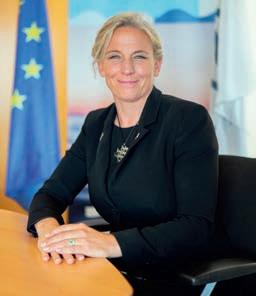
agency’s three vessels, the Ocean Sentinel, the Ocean Protector, or the Ocean Guardian.
e aim, says Dr Steele, is to deliver the same capacity building, training, and competences to the national inspectors no matter where they come from. If people are treated di erently in
di erent areas, then control and inspection does not work. is applies not only to EU members but also to the cooperation with third countries as EFCA also operates in areas that are managed by regional sheries management organisations (RFMOs), including the North-East Atlantic Fisheries Commission (NEAFC), Northwest
1 Cacciatore, F., & Eliantonio, M. (2020). Quis custodiet ipsos custodes? Assessing the systems of controls of the European Fisheries Control Agency’s inspecting powers. In M. Scholten, & A. Brenninkmeijer (Eds.), Controlling EU Agencies: e Rule of Law in a Multi-jurisdictional Legal Order (pp. 215–233). Edward Elgar Publishing. https://doi.org/10.4337/9781789905427.00020
GUEST PAGES
Dr Susan Steele, Executive Director, European Fisheries Control Agency
62
EFCA
Atlantic Fisheries Organization (NAFO), the International Commission for the Conservation of Atlantic Tunas (ICCAT), and the General Fisheries Commission for the Mediterranean (GFCM). A recent example of cooperation with non-EU countries is the E-FishMed project that EFCA is implementing with support from southern European EU members for the bene t of ve north African countries. e project will establish a virtual regional training academy to strengthen national and regional monitoring, control, and surveillance systems.
When cooperating with non-EU RFMO members, EFCA endeavours to create a level playing eld. In fact, this year, for the rst time, EFCA will have a joint deployment plan in the Indian Ocean. Information from the joint deployment plans is available on the EFCA website, in the agency’s annual report, and the multiannual work program. e gures include the number of inspections carried out at sea and on shore and the results of control activities including the number of suspected infringements detected and the ratio to the number of inspections. e data is arranged by year and by sea basin. Discerning a trend is not easy, however; in the Baltic Sea, for example, between 2014 and 2022 the ratio of suspected infringements to vessels inspected has uctuated between 6 and 0.95 for at-sea inspections and between 1.5 and 3.4 for onshore inspections. Infringements are of many types and severities such as non-compliance with conservation measures, with recording and reporting obligations, or other types of noncompliance such as incorrect weighing of catches at landing, marketing without mandatory rst sale, or failure to provide safe access to inspectors.

Monitoring
fisheries contributes to revealing illegal activities in other spheres
One development that promises to have a signi cant impact on EFCA’s work is the introduction from this year of the new control regulation. Among other changes, this calls for small-scale vessels to switch from paper logbooks to electronic recording methods which will simplify procedures both for the shers and for the control authorities.
In addition to its sheries control activities, EFCA works together with the European Border and Coast Guard Agency and the European Maritime Safety Agency to keep an eye on potentially illegal actions at sea. Data from drones, aircraft, or satellites that are used to monitor shing can also uncover other activities and the three Agencies shares this information between them. EFCA’s key tasks, however, remain the joint deployment plans, the training of sheries inspectors, and risk management for the cost-e ective deployment
of control means and implementation of activities to monitor and improve compliance. EFCA develops its own online tools for monitoring vessel activity which it then shares with the Member States. ese tools provide inspectors with troves of current and historical information on shing vessels. It also develops statistical tools to evaluate risks and identify which vessels or sectors it makes the most sense to inspect. As Dr Steele says, one cannot inspect all shing vessels, nor would one want to, so it is necessary to make educated choices about which vessel should be inspected and this is what our models show us. Here too cooperation with the countries plays a role as they can each feed the models with data to make their conclusions more robust. Dr Steele expects that data from the remote electronic monitoring of vessels envisaged in the new control regulation will also contribute to the accuracy and reliability of EFCA’s statistical models.
If during an inspection, violations of the rules are identi ed, the case
goes through national administration or courts, as EFCA does not have the authority to sanction o enders. While legal procedures vary widely from country to country, under European legislation the competent national authorities in the ag state shall impose points on shing licence holders and shing vessel captains for serious infringements. For repeated transgressions within a period the penalty gets progressively higher ultimately leading to the revocation of the license. e point system seeks to ensure that the same type of infringement wherever it takes place will be penalised to the same degree across the EU, thereby contributing to the creation of a level playing eld. While most shers are law abiding, whether the system deters even the most risk indi erent sher is probably determined by what is at stake.
Catching the sco aws depends on several factors of which technology is one. Progress in this area is rapid and continuous particularly in areas like satellite imaging. EFCA collaborates with EMSA, the European Union
GUEST PAGES
In a control operation inspectors study nets to determine whether they comply with legal requirements.
EFCA
EUROFISH Magazine 3 / 2024 63
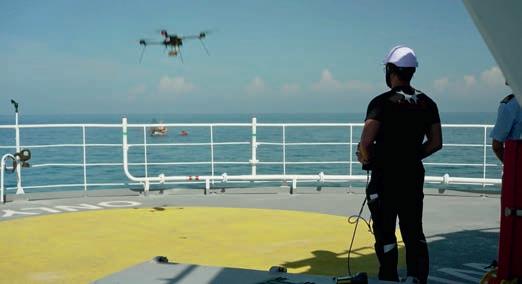
Satellite Centre and the European Space Agency, but Dr Steele points out that it is the e ciencies that are gained from working together, by pooling resources and not duplicating e orts, that give the most bene ts, and not the latest technological advancement per se.
Sharing knowledge between countries helps improve practices everywhere
Among the projects EFCA is running is one where countries install remote electronic monitoring equipment on test vessels. Since each country takes a different approach there is much to be learned when EFCA collects and analyses the data from all the countries. Another project works with weighing systems and here too the knowledge generated by the countries can be used to optimise these systems
across countries. is approach, whereby countries invest in technologies and share their experiences via EFCA, is e cient as it prevents reinvention of the wheel, and it bene ts all involved. Technology is one area, where this shared approach has proved its worth. In addition, Dr Steele says, in terms of compliance with regulations governing GDPR and articial intelligence, it has also been very useful.
EFCA works closely with non-EU countries in the Mediterranean but also with the UK. Inspectors from Mediterranean countries are taken on board EFCA vessels and there are also physical and virtual meetings with counterparts in these countries. All agree on the importance of sustainable sheries, and its implications for coastal areas. e challenge is how to achieve it given the limited resources. What should countries prioritise? How can
sheries be made sustainable most e ectively? All countries need to address these questions, but in non-EU Mediterranean countries they acquire an added urgency given the resources available and the impacts of climate change which are particularly severe. With the UK, one of EFCA’s key roles is communication regarding sheries control on both sides. A lack of communication can lead to a weakness in the system that can
be exploited by people who want to sh illegally. e agency’s priority in the next years is the new control regulation which will see the extension of control technologies currently used on larger vessels to the entire eet including the smaller vessels. We want to maintain a high level of trust and transparency with all our stakeholders, says Dr Steele, and ensure the harmonised implementation of the control regulation.
European Fisheries Control Agency
Edificio Odriozola, Avenida García Barbón, 4 E-36201 Vigo Spain
Tel.: +34 986 12 06 10 https://www.efca.europa.eu
Executive Director: Dr Susan Steele
Functions: Promote common standards for fisheries control, inspection, and surveillance; coordinate national control and inspection activities; monitor compliance with conservation and management measures; support national authorities coast guard functions Employees: 104
GUEST PAGES
While monitoring fishing footage from drones can also reveal illicit activities in other spheres such as smuggling.
EFCA
64

18-20 June 2024
Seagriculture * Torshavn, Faroe Islands info@dlg-benelux.com https://seagriculture.eu


28-29 June 2024
Aquaculture Congress
Athens, Greece
Tel.: +30 210 9219 948 info@ambio.gr www.aquaculture-congress.com
20-22 August 2024
Nor-Fishing
Trondheim, Norway
Tel.: +47 73 56 86 40 post@nor-fishing.no www.nor-fishing.no

26-30 August 2024
AQUA2024 * Copenhagen, Denmark mario@marevent.com www.was.org

4-6 September 2024
Seafood Expo Asia
Singapore
Tel.: +1 207 8425504 customerservice@divcom.com www.seafoodexpo.com
11-13 September 2024
Polfish * Gdansk, Poland monika.pain@mtgsa.com.pl https://polfishtargi.pl/en/

10-12 October 2024
Future Fish Eurasia * Izmir, Turkey
Tel.: +90 212 347 10 54 info@eurasiafairs.com www. eurasiafairs.com

18-20 September 2024
IceFish * Kópavogur, Iceland
ttattum@mercatormedia.com
Tel.: +44 1329 825335 https://www.worldfishing.net/icelandic-fisheriesexhibition








10 – 13 December 2024
AlgaEurope 2024 Athens, Grece info@dlg-benelux.com https://algaeurope.org/
1-3 October 2024
Conxemar Vigo, Spain conxemar@conxemar.com https://www.conxemar.com/en/exhibition/

6-8 May 2025 *

Seafood Expo Global/Seafood Processing Global *
Barcelona, Spain
8-10 October 2024
PolarExpo Fishing and Hunting
Ilulissat, Greenland
Tel.: +45 99 35 55 55 info@akkc.dk
Tel.: +1 207 8425504 customerservice@divcom.com www.seafoodexpo.com
* Eurofish will be attending
Add your event to www.eurofish.dk
DIARY DATES
Publisher Euro sh International Organisation
H.C. Andersens Boulevard 44-46 DK-1553 Copenhagen V Denmark
Tel.: +45 333 777 55, info@euro sh.dk euro sh.dk
Managing editor Marco Frederiksen
Editorial offices Behnan Thomas (bt) H.C. Andersens Boulevard 44-46 DK-1553 Copenhagen V Denmark
Tel.: +45 333 777 64 behnan.thomas@euro sh.dk
Dr. Manfred Klinkhardt (mk) Redaktionsbüro Delbrück Franz-Stock-Straße 23 D-33129 Delbrück Germany
Tel.: +49 5250 933416 manfred.klinkhardt@web.de
Technical layout Thomas Jensen
Advertising Aleksandra Petersen Euro sh Magazine
H.C. Andersens Boulevard 44-46 DK-1553 Copenhagen V Denmark
Tel.: +45 333 777 63 aleksandra.petersen@euro sh.dk
Frequency 6 issues per year
Circulation 2500 copies
Subscription details
Price: EUR 100,–To subscribe send an email to info@euro sh.dk
Unless otherwise stated, the copyright for articles in this magazine is vested in the publisher. Articles may not be reproduced without written permission from the copyright holders. A soft copy is available on request to aleksandra.petersen@euro sh.dk
ISSN 1868-5943
Order your free trial info@eurofish.dk



LIST OF ADVERTISERS
Fish Eurasia
Page
Imprint
Eurofish Magazine eurofish.dk
. . . . . . . . . . . . . . . . . . . . . . . . . . . . . . . . . . . . . . . . . .19
. . . . . . . . . . . . . . . . . . . . . . . . . . . . . . . . . . . . . . . . . . . . . . . . .17
. . . . . . . . . . . . . . . . . . . . . . . . . . . . . . . . . . . . . . . . . . . . . . . . . . . . .55
AQ24 Copenhagen.
AquaTech.
FIAP.
. . . . . . . . . . . . . . . . . . . . . . . . . . . . . . . . . . . . . . . . . .21
Future
. . . . . . . . . . . . . . . . . . . . . . . . . . . . . . . . . . . . . . . . . . . . . . . . . . .11
IceFish.
. . . . . . . . . . . . . . . . . . . . . . . . . . . . . . . . . . . . . . . . . . . . . . . . . . . .15
Kroma
. . . . . . . . . . . . . . . . . . . . . . . . . . . . . . . . . . . . . . . . .
MSC Cargo
Back cover
. . . . . . . . . . . . . . . . . . . . . . . . . . . . . .Inner
Project partners at AQUA24
front
. . . . . . . . . . . . . . . . . . . . . . . . . . . . . . . . . . . . . . . . . . . . . . . . . . . .13
Polfish
. . . . . . . . . . . . . . . . . . . . . . . . . . . . . . . . . . . . . . . . . . . . . . . . . . .23 Poland again! AlgaeProBanos will algae industry new sh trap keeps fish
Vimida.
Insulated containers
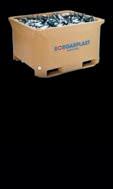
PIONEERS IN HIGH-QUALITY HIGHLY-INSULATED & HEAVY-DUTY FISH CONTAINERS
PROTECTING FRESHNESS AND QUALITY FOR DECADES MADE IN ICELAND
borgarplast.is/en
Pelagic fish processing

Nobbingmachines andAuto-packers forsardineandmackerel
VredenburgSouthAfrica
Mobile: +27 83 2620362
E-mail: easycancc@gmail.com Website: www.easycan.co.za
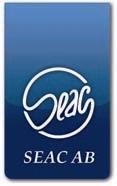
ONE OF THE MAIN MANUFACTURES OF PROCESSING MACHINES FOR BIG, SMALL AND VERY SMALL PELAGIC FISH
Nobbing down to 110 pcs/kg Filleting down to 100 pcs/kg Up to 450 fish pockets per min
Slånbärsv.4, SE-386 90 Öland Sweden info@seac.se WWW. SEAC.SE
Polystyrene compressors
The specialist in fishbox compactors and recycling Tel. +45 97371799 runi@runi.dk www.runi.dk A/S
Slicers
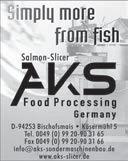

Thermal conditioning SALMCO Technik GmbH Robert-Koch-Straße 19 D-22851 Hamburg-Norderstedt
Tel.: +49 40 7131472
Fax: +49 40 71370166 info@salmco.com www.salmco.com
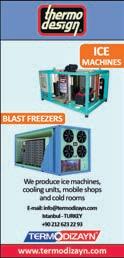
A different
kettle of fish
Pick up your copy at AQUA24, Copenhagen, 26-30
August 2024

■■■■■■■■■■ SUPPLY SOURCES ■■■■■■■■■■
Margar stærðir og tegundir sem henta ólíkum þörfum
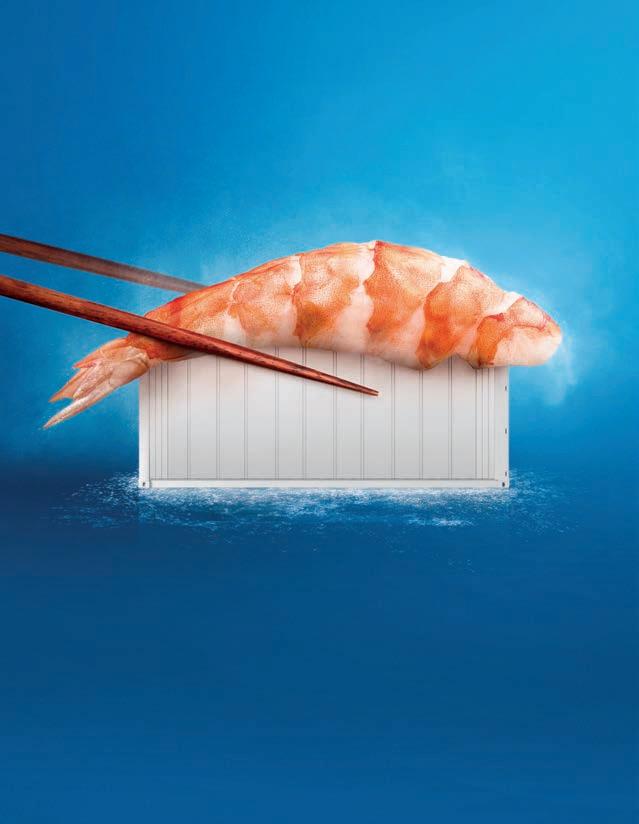















































































 Cormorant populations are on the rise in the EU, posing a threat to regional fisheries and the viability of smaller enterprises.
Cormorant populations are on the rise in the EU, posing a threat to regional fisheries and the viability of smaller enterprises.

 Marianne Sivertsen Næss is Norway's new fisheries minister with responsibility for fisheries, aquaculture, and seafood.
Marianne Sivertsen Næss is Norway's new fisheries minister with responsibility for fisheries, aquaculture, and seafood.



















 Katica
Katica







 Starfish
hot-
cold-smoked
Starfish
hot-
cold-smoked















































































































